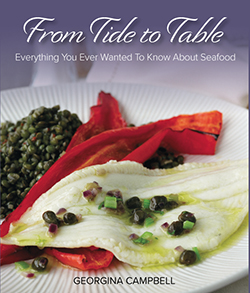Article THE SEAFOOD INTERVIEW
The Seafood Interview supported by BIM - The Crazy Crab Café & Bistro
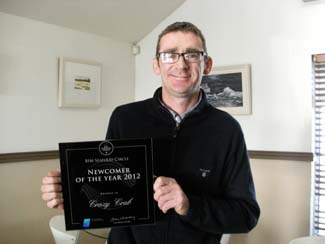
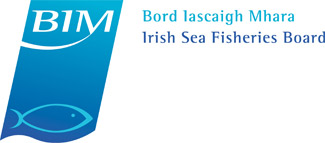 In the first of a new series, Marilyn Bright looks at the highs and lows of some of Ireland’s leading seafood restaurants - and finds out what makes them tick.
In the first of a new series, Marilyn Bright looks at the highs and lows of some of Ireland’s leading seafood restaurants - and finds out what makes them tick.They keep things simple at The Crazy Crab Café & Bistro, Kilmore Quay, Co Wexford, proving that you don’t need fancy dishes to please the punters – just really fresh fish that tastes of itself.
With its sprinkling of thatched cottages and sparkling harbour bustling with a mixture of sleek leisure craft and hard-working fishing boats unloading thair catch, Kilmore Quay is a film-makers dream of a picturesque port. Crowds of visitors appear as summer approaches and at the Crazy Crab Café and Bistro, they’re gearing up for their third season serving up seafood so fresh it has literally travelled just the width of the quayside.
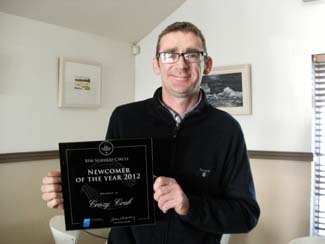 Chef-proprietor Mike Crowley says that no one was more surprised than himself when the Crazy Crab was named Newcomer of the Year in the BIM Seafood Circle Awards 2012. “We don't do anything fancy,” he says, “just put up the best fresh fish every day and do very little with it — no sauces, just garlic butter or tartare sauce.”
Chef-proprietor Mike Crowley says that no one was more surprised than himself when the Crazy Crab was named Newcomer of the Year in the BIM Seafood Circle Awards 2012. “We don't do anything fancy,” he says, “just put up the best fresh fish every day and do very little with it — no sauces, just garlic butter or tartare sauce.”Fish is what Mike knows, with a lifetime spent crab and lobster potting and working the fish auctions in Union Hall, the move into catering seems to have been a bit unplanned. “I think I got a bit bored with the fishing,” Mike muses, “and then this place came up. My wife works in the fish company across the way and I just thought why not?"'
Although the premises had been vacant for a year, it had been a full working restaurant left in good nick needing only “a lick of paint” and some minor equipment. On the cooking front, Mike's sister is a chef and she came in to help at the beginning. Since then, Mike presides at the stove and directs the dozen or so staff needed during peak
summer season.
Fresh fish comes in daily and is filleted in-house. “The biggest difficulty with fish is trying to hold it and that used to be more of a problem when supplies were scarce, but now the big boats can stay out in bad weather and supplies are more constant. We buy direct from Flaherty's, who have 13 boats landing their catch in Kilmore. Freshness is key and that's what keeps the customers coming."
Although most of the fish landed at Kilmore is destined for the continental export market through the two local fish companies, Mike’s good relationships there ensure fresh stock every morning — with the odd dash across the quay mid-service if there's been a run on a particular item.
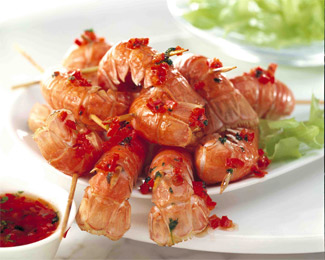 Popular langoustines, or Dublin Bay Prawns, actually come from all around the coast, from Galway and Union Hall to Clogherhead and Howth, and the Crazy Grab gets through crates of them. Prawns in garlic butter “fly out the door” all summer and also appear as golden battered scampi or with the classic Marie Rose sauce and salad.
Popular langoustines, or Dublin Bay Prawns, actually come from all around the coast, from Galway and Union Hall to Clogherhead and Howth, and the Crazy Grab gets through crates of them. Prawns in garlic butter “fly out the door” all summer and also appear as golden battered scampi or with the classic Marie Rose sauce and salad. Kilmore is a major lobster port, but Mike is puzzled by the fact that this top-end shellfish hasn't been much taken up in the cafe, even though lobster has been well priced over the past year “I just don't fathom it,” he admits, “but customers much prefer their prawns in garlic butter.”
Kilmore Quay scallops are partnered with Clonakilty black pudding or simply turned in garlic butter to be served with the Crazy Crab sides of chips and salad, Mike's fishcakes combine fresh cod and haddock and smoked cod seasoned with onion and parsley and set off with chilli salsa. Signature crab comes as crabmeat cocktail or garlic buttered claws or as part of the mountainous seafood platter that is the pièce de résistance for two hungry people.
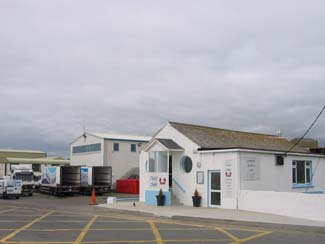 The Crazy Crab seafood chowder is an all-weather crowd pleaser, a creamy version with chunky white and smoked fish, prawns, scallops, onions and potatoes enriched with white wine and stock. Haddock and plaice are menu mainstays, with breaded haddock goujons a particular favourite for young customers. Constantly changing catch of the day is chalked up on the blackboard - lemon sole, hake, monkfish or John Dory — whatever has just arrived.
The Crazy Crab seafood chowder is an all-weather crowd pleaser, a creamy version with chunky white and smoked fish, prawns, scallops, onions and potatoes enriched with white wine and stock. Haddock and plaice are menu mainstays, with breaded haddock goujons a particular favourite for young customers. Constantly changing catch of the day is chalked up on the blackboard - lemon sole, hake, monkfish or John Dory — whatever has just arrived.Business starts to build gently in Kilmore in the spring and high season at the Crazy Crab kicks in with the June bank holiday. “Then it's really crazy for three months,” Mike says, “It's tough going, but I get a kick out of it when compliments come in. We only have a tiny kitchen, so everything we do is simple and fresh so that the fish speaks for itself. People are happy with it and it's their word of mouth that helps the business more than anything else."
The Seafood Interview supported by BIM - Out of the Blue, Dingle
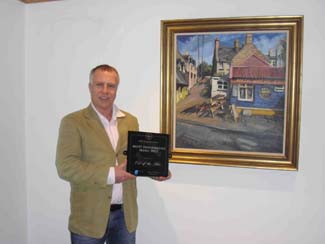
 Marilyn Bright talks to Tim Mason of Out of the Blue, Dingle, Co Kerry, a man who saw potential in a derelict shack beside the harbour - and turned it into one of Ireland’s best-known (and most uncompromising) seafood restaurants.
Marilyn Bright talks to Tim Mason of Out of the Blue, Dingle, Co Kerry, a man who saw potential in a derelict shack beside the harbour - and turned it into one of Ireland’s best-known (and most uncompromising) seafood restaurants.For restaurateur Tim Mason, Out of the Blue couldn’t be a more appropriate name for his seafood mecca now enjoying Its twelfth year beside Dingle pier. Although a South County Dubliner, Tim spent most of his working life abroad, shifting between financial powerhouses of Zurich, New York, London and Dusseldorf as a stockbroker and commodities trader. Taking a sabbatical from the stress of the trading floor, a leisurely home holiday brought him to Dingle, which was to prove his fatal attraction.
 "I drove down to the harbour and passed this tumbledown jumble of a shack with the light sparkling on the bay and boats bobbing up and down," Tim recollects. “And I thought that's it — I could do something here.”
"I drove down to the harbour and passed this tumbledown jumble of a shack with the light sparkling on the bay and boats bobbing up and down," Tim recollects. “And I thought that's it — I could do something here.”Although Tim always had a keen interest in food and his mother was a good cook and follower of Jane Grigson and Elizabeth David, he had never been involved at the sharp end of cooking, much less the catering profession. What did stand him in good stead, however, was the fact that stockbrokers ( in those days anyway ) dined extraordinarily well, so he’d experienced of best restaurants around the world,
 The tiny restaurant cum fish shop that opened in the summer of 2001 was a far cry from international fine dining, but fresh paint had worked wonders and the emphasis was on fresh, fresh fish -- sold from the iced counter to be taken home or cooked and served up at one of the five tables. With the nearest trawler just 50 yards away,
The tiny restaurant cum fish shop that opened in the summer of 2001 was a far cry from international fine dining, but fresh paint had worked wonders and the emphasis was on fresh, fresh fish -- sold from the iced counter to be taken home or cooked and served up at one of the five tables. With the nearest trawler just 50 yards away, Tim and his chef would literally drag the boxes across to the shop. “In the early days we used to sort the fish in front of the cafe — we just had no room inside — but it drew a lot of attention and attracted customers who could see how really fresh everything was. You couldn't do that today, though."
The restaurant has expanded bit by bit over the years, with derelict sections of the premises gradually reclaimed. The main dining area today was formerly the old donkey shed with a holed tin roof and the fish counter has given way to a much needed bar area. There’s seating now for 35 - 40 people, with three tables outside under a bright awning. “We've gone as far as we can,” Tim says, “without digging a basement.”
The very small kitchen only fits three people — the head chef Jean-Marie Vaireaux, a sous-chef and a kitchen porter who also doubles up on desserts. All good friends of necessity, Tim asserts. Eric Maillard who was the original Out of the Blue chef, has returned after a few years abroad and Peter Stephane is the third chef in the team. "With a seven day opening, Tim had found that three chefs working switchable rotas suits the confines of the kitchen, the menu and the pressure of business that means that tables may be turned two to three times an evening during high season.
Ten to fifteen different fish appear on menus chalked up on blackboards every service, dishes varying with the catch of the day and "whatever is in the chef's head". Various elements are interchangeable, like the toasted almond and lemon butter that may appear with pan-fried lemon sole one day and another fish on the next. Oven roasted sea bass may be partnered with garlic butter and black olive tapenade while creamy clam and mushroom sauce compliments braised turbot cutlets. Crayfish salad has homemade mayonnaise and the langoustine bisque has a classic Provencale topping of croutons and aioli.
With Jean-Marie hailing from Lyon and Eric from Brittany, it’s no surprise to see French classics like beurre blanc, sauce Grenobloise or the roast apple and cider sauce served with turbot, while Gallic favourites like ratatouille and celeriac remoulade are here too,
Sauces and flavourings are designed to let the freshness of the fish speak for itself and accompaniments are kept simple too. "Fish has to be the star and we do a combination of different small salads — maybe 15 or so, with a different selection going out on each plate, " Tim explains. Although he takes pride in a ' fish only' menu with no concession to carnivores, they will cater for vegetarians, making up a chef's selection plate of the salads and accompaniments of the day.
Pollock in a crisp potato crust served with chive cream has become the Out of the Blue signature dish, highly popular and appearing on every menu. "It's our version of fish and chips”, Tim jokes, “and although we're always being asked for the recipe, it's going to remain our secret."
Glenbeigh Shellfish Company supplies the oysters, clams and local mussels that are farmed just below Inch strand. Langoustines aren’t landed so much now in Dingle, Tim has observed, and there is less gurnard than there used to be. "Working with fish every day, you get to know what is really local to a specific area. Our own Dingle Bay cod has a purple colour from living among the reeds, while other cod has a greenish cast.”
Although Tim had a basic knowledge of fish from his young angling days, he's learned about filleting and how to keep fish by watching the fishermen, observing at the local fish factory and asking “plenty of questions”. Reading is important too and Tim regards Jane Grigson's Fish Cookery as his bible, while having high regard for Rick Stein's books as well as the Irish published From Tide to Table by Georgina ampbell which is sadly now out of print. The fish cookery book collection has grown over the years and well-thumbed copies appear as décor on the restaurant tables instead of flowers.
The success of Out of the Blue would be an achievement for any caterer, but especially so for a self-taught seafood specialist like Tim. “Membership of the BIM Seafood Circle has been a badge of honour and winning the Most Informative Menu award is the icing on the cake. It's a great and sometimes exasperating business and I always say it’s my first restaurant and my last.”
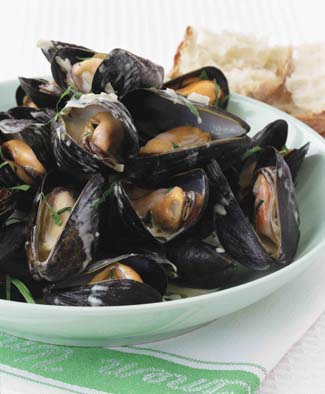 RECIPE: Glenbeigh Mussels 'Marinières'
RECIPE: Glenbeigh Mussels 'Marinières'At Out of the Blue they cook wonderful classics, sometimes with a modern twist. Everything depends on the fresh fish and seafood supply from the boats that day and if there’s no fresh produce, they don’t open. This favourite dish from our seafood cookbook From Tide To Table showcases one of Kerry’s most famous seafood products and, although very easy, it is a great dish for entertaining: simple, yet impressive. Serves 4
50g/2oz butter 1 shallot, finely chopped
1.75kg/4lb fresh mussels, cleaned
150ml/1/4 pint dry white wine
120ml/4fl oz cream or crème fraîche
handful chopped fresh flat-leaf parsley
freshly ground black pepper
To Serve: crusty bread
Melt the butter in a large pan with a lid, add the shallot and cook over a moderate heat for 2-3 minutes until softened but not coloured.
Increase the heat, tip in the mussels and wine and cover with the lid. Allow to cook for 3-4 minutes, shaking the pan occasionally until the mussel shells have opened; discard any that do not.
Using a large slotted spoon, divide the mussels among large bowls. Whisk the cream or crème fraîche into the wine mixture and season with pepper, then pour over the mussels. Sprinkle a little of the chopped parsley over each bowl and serve with some crusty bread to mop up all those delicious juices.
VARIATION: This dish could also be made with cockles or clams instead of mussels.
The Seafood Interview supported by BIM - Mary Anns Bar and Restaurant
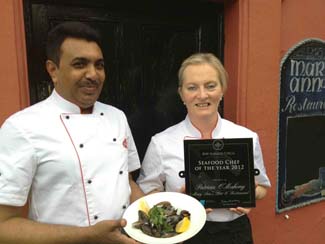
 Marilyn Bright talks to Patricia and Fergus O’Mahony, who have been running their renowned seafood pub in West Cork for over 25 years – that’s a quarter of a century before the word ‘gastro-pub’ entered the vocabulary of unsuspecting foodies everywhere.
Marilyn Bright talks to Patricia and Fergus O’Mahony, who have been running their renowned seafood pub in West Cork for over 25 years – that’s a quarter of a century before the word ‘gastro-pub’ entered the vocabulary of unsuspecting foodies everywhere.
For over 150 years, Mary Ann's Bar has been welcoming hungry sailors wending their way up from Castletownshend’s picturesque harbour. Licensed since 1846, the bones of the building go back to Armada times, an incident present day owners Patricia and Fergus O'Mahony can relate to during the mid-August peak when the village is thick with yachties and the harbour solid with boats.
Travellers tales abound with memories of thick crab sandwiches piled on homemade bread and lobsters delivered dripping fresh that day from Ted O'Driscoll's lobster pots in Union Hall.
 The family run bar and restaurant is garlanded with awards won since the couple took on the business over 25 years ago and built their reputation on excellent local seafood and generous hospitality. Patricia, who left a career in banking to take over the kitchen, was named BIM Seafood Circle Chef of the Year 2012 and Mary Ann’s has also taken top honours as Georgina Campbell’s Pub of the Year 2012.
The family run bar and restaurant is garlanded with awards won since the couple took on the business over 25 years ago and built their reputation on excellent local seafood and generous hospitality. Patricia, who left a career in banking to take over the kitchen, was named BIM Seafood Circle Chef of the Year 2012 and Mary Ann’s has also taken top honours as Georgina Campbell’s Pub of the Year 2012.
Seafood chowder – always gluten free - is legendary, as are the Roaring Water Bay mussels steamed in white wine with cream and garlic. Crab sells “by the ton” not only in the trademark open sandwich and salad, but in the delightfully retro baked avocado stuffed with crab and melting gratinated topping. "We’re spoiled here,” Patricia admits, “because we get the ready-picked crab meat from Shellfish de la Mer in Castletownbere just down the road."
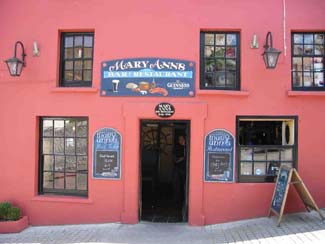 The menu at Mary Ann's is a crowd pleasing mélange of old and new and perennials like the Union Hall smoked salmon platter or crispy battered fish of the day with chips. Scallops Mary Ann is a blast from the past with piped potato and brandy-spiked mornay, otherwise known as Coquilles Saint Jacques of happy memory. Newer influences are reflected in scallops paired with Clonakilty black pudding and bacon with beurre blanc or the roasted monkfish tails complemented by a tasty cushion of wild mushroom risotto.
The menu at Mary Ann's is a crowd pleasing mélange of old and new and perennials like the Union Hall smoked salmon platter or crispy battered fish of the day with chips. Scallops Mary Ann is a blast from the past with piped potato and brandy-spiked mornay, otherwise known as Coquilles Saint Jacques of happy memory. Newer influences are reflected in scallops paired with Clonakilty black pudding and bacon with beurre blanc or the roasted monkfish tails complemented by a tasty cushion of wild mushroom risotto.
Tastes have changed over the years, Patricia acknowledges, with heavy cream sauces being by-passed in favour of infused oils, salsas, tapenades and Mediterranean marinades. Mary Ann's menus have seen further diversity with the arrival of assistant chefs from Sri Lanka and Bangladesh. Thai green curry and seafood laksa have proved popular along with the Thai fishcakes with mixed greens and chilli mango sauce. Prawns may be given a light tempura batter with chilli and soy dip or stir-fried with garlic, chilli and ginger. Salmon marinated with chilli, coriander and lime is a popular healthy choice served with steamed rice and salad.
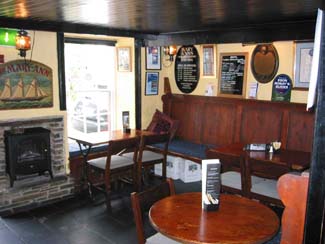 The busy bar and restaurant with its patio garden is especially family friendly during the summer months with kids’ options of half-portions of nearly everything on the menu. "Little ones eat fish now,” Patricia reports. “Goujons and pasta are popular, and they love mussels so they can get in with both hands and pick out the shells.”
The busy bar and restaurant with its patio garden is especially family friendly during the summer months with kids’ options of half-portions of nearly everything on the menu. "Little ones eat fish now,” Patricia reports. “Goujons and pasta are popular, and they love mussels so they can get in with both hands and pick out the shells.”
Patricia admits being thrown in at the deep end when she joined Fergus in Mary Ann’s with a tiny kitchen. It was only sandwiches in the beginning, but they quickly realised that offering food was the only way to survive and the menu expanded gradually. "It was on the job training,” she say, “and I read all the cookbooks and magazines and watched the television chefs."
Gordon Ramsay is respected for his straight talking and she likes Hugh Fearnley-Wittingstall’s River Cottage books. Everything from Ballymaloe is “amazing” and Delia Smith is sound on the basics - her sticky toffee pudding is constantly on the menu and Patricia is a great fan of her frangipan tarts which are adapted to the fruits and berries in season, "and a French chef gave me the tip of putting a little rum into the frangipan mixture."
Like everyone else, the O’Mahonys have had to adapt to the economic downturn. The kitchen brigade is down from five to three, with Patricia back full time as head chef. “With less hands, we've paired down the menu because you can't compromise on quality. People are dining out less often - summer visitors who used to eat out three times a week are probably out once now," she's observed. “Customers come to us because they know what they're getting is absolutely fresh - nearly jumping out of the water - but at the same time they want value for money. Our costs are going up all the time, so you'd want to be a magician to get the balance right.”
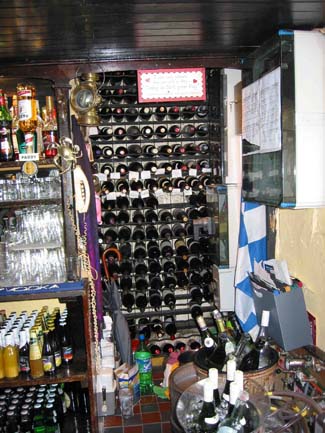 Wine afficianados consider Fergus something of a magician when it comes to Mary Ann’s wine list. House wines start at €17.95 for an Argentinian cabernet sauvignon, while wine specials of the week highlight bargains like Trimbach pinot blanc marked down from €29.95 to €21.95 and champagne down to €35 from €75. Fergus prides himself on prising great deals from suppliers, enabling him to offer premium wine like the current range of classic burgundies - Pouilly Fuisse, Meursault, Puligny-Montrachet - all in the €25- 50 bracket.
Wine afficianados consider Fergus something of a magician when it comes to Mary Ann’s wine list. House wines start at €17.95 for an Argentinian cabernet sauvignon, while wine specials of the week highlight bargains like Trimbach pinot blanc marked down from €29.95 to €21.95 and champagne down to €35 from €75. Fergus prides himself on prising great deals from suppliers, enabling him to offer premium wine like the current range of classic burgundies - Pouilly Fuisse, Meursault, Puligny-Montrachet - all in the €25- 50 bracket.
Wine dinners are a feature of the off-peak season and Mary Ann's wine club has five tastings a year as well as annual trip like the visit to Bordeaux which took in Chateau Palmer and Beychevelle-Pomerol. This year's trip will be to Barcelona, in October and although it's been a policy that both O'Mahonys are never away at the same time, Patricia insists that she'll be travelling with Fergus to Spain. “It's our silver wedding anniversary this year and I think I deserve it.”
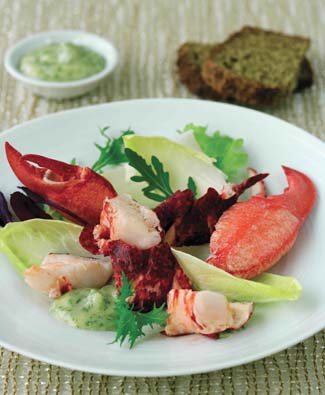 RECIPE: Lobster Salad with Lemon and Dill Mayonnaise
RECIPE: Lobster Salad with Lemon and Dill Mayonnaise
[From ‘From Tide To Table’ (Epicure Press. Out of print.)]
This is an old favourite from Trish O’Mahony and it often makes an appearance on the daily blackboard specials in the bar at Mary Ann’s; it’s a dish which never fails to draw compliments and you could also try making it with the freshest possible white crab meat.
[Hint: Freeze the leftover lobster shells and use them for lobster stock.]
2 live lobsters, each about 500g/1lb 2oz
1 small onion, sliced
1 slice lemon
1 bay leaf
2 fresh dill sprigs
handful fresh parsley stalks
few black peppercorns
120ml/4fl oz white wine
100g/4oz mixed salad leaves, such as chicory, rocket and lollo rosso
2 tbsp French vinaigrette (see below)
salt and freshly ground black pepper
To Serve
lemon and dill mayonnaise (see below)
freshly baked brown soda bread
SERVES 4
To prepare the lobsters, place each one on a board and cover it with foil and a cloth. Hold firmly down with one hand and, with the point of a large knife, pierce down to the board through the cross on the centre of the head.
Put enough salted water to cover the lobsters into a large deep pan, and bring to the boil. As a guide allow at least 1 litre/13/4 pints to 1 teaspoon of salt per 500g/1lb 2oz lobster. Add the onion, lemon, bay leaf, dill sprigs, parsley, peppercorns and white wine and simmer for 5 minutes to allow the flavours to combine.
Increase the heat and when the flavoured water is boiling, add the lobsters and boil for 5 minutes for the first 500g/1lb 2oz, adding an extra 3 minutes for each extra 500g/1lb 2oz. When the lobsters are cooked, the colour changes to bright red. Transfer to a large sink or basin of iced water to cool down immediately.
When the lobsters are cool enough to handle, pull the claws from the bodies. Crack the claws and remove the meat. With a large chef’s knife cut each lobster in half from the back, along the length of its body, and remove its intestinal tract, then discard. Remove the tail meat and slice it up neatly.
To serve, toss the salad leaves in the French vinaigrette, then season to taste and pile in the centre of each serving plate. Arrange the lobster meat on top and spoon a dollop of mayonnaise onto each plate. The remainder can be served in a small dish on the table along with a basket of freshly baked brown soda bread, allowing guests to help themselves.
French Vinaigrette
This is an excellent version of French vinaigrette, but you can adapt it to your own personal taste by using red or white wine vinegar, or experiment with different oils. This makes enough to dress a good-sized green or mixed salad.
1 tbsp white wine vinegar
pinch of caster sugar
4 tbsp extra virgin olive oil
1/2 tsp Dijon mustard
1 small garlic clove, crushed
salt and freshly ground black pepper
SERVES 4-6 MAKES ABOUT 75ML/3FL OZ
Place the vinegar in a screw-topped jar and add the sugar and a good pinch of salt, then shake until the salt has dissolved. Add the oil to the jar with the mustard and garlic and shake again until you have formed a thick emulsion. Season to taste and chill until needed.
Mayonnaise
This quick mayonnaise is made in a food processor and it will keep happily in the fridge for up to one week. It literally takes minutes to make and is far superior to any shop bought alternatives.
1 egg, at room temperature
2 tsp white wine vinegar
1/2 tsp salt
pinch of caster sugar
1 tsp Dijon mustard
120ml/4fl oz olive oil
120ml/4fl oz sunflower oil
MAKES 300ML/1/2 PINT
Break the egg into the food processor and add the vinegar, salt, sugar, mustard and half of the olive oil. Secure the lid and whizz for 10 seconds. Leave to stand for a couple of seconds, then turn on again at medium speed and pour the remaining olive oil and sunflower oil through the feeder tube in a thin steady stream. This should take 25-30 seconds. Switch off the machine, take off the lid, scrape down the sides, and whizz again for 2-3 seconds. Transfer to a bowl or a jar, season to taste and cover with clingfilm. Chill until ready to use.
VARIATION: To make LEMON AND DILL MAYONNAISE, stir the finely grated rind of 1 lemon and 2 tablespoons of chopped fresh dill into the mayonnaise
Marilyn Bright talks to Patricia and Fergus O’Mahony, who have been running their renowned seafood pub in West Cork for over 25 years – that’s a quarter of a century before the word ‘gastro-pub’ entered the vocabulary of unsuspecting foodies everywhere.
The Seafood Interview supported by BIM - Castle Murray House Hotel
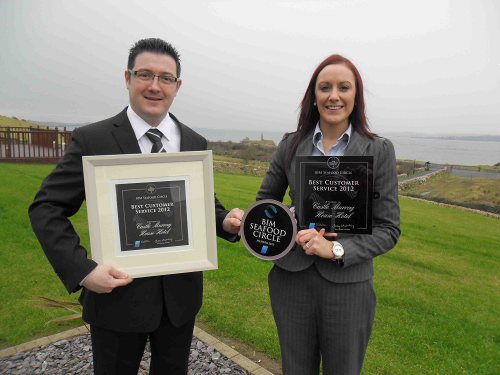
 Marilyn Bright talks to Marguerite Howley of Castle Murray House Hotel, St John's Point, Dunkineely, Co Donegal.
Marilyn Bright talks to Marguerite Howley of Castle Murray House Hotel, St John's Point, Dunkineely, Co Donegal.
From a cliff-top above the long toe of St John's Point, diners in Castle Murray House Hotel have a perfect view of Donegal Bay and the Atlantic coast where some of the world's best seafood is landed. Air miles simply don’t figure here as lobsters for the restaurant may be lifted from pots just 100 metres away while langoustines come from day boats seen bobbling about off St John's Point.
Proprietor Marguerite Howley celebrated 10 years at Castle Murray this spring and has grown up in the fishing industry. With both a father and a brother involved in the Donegal fleet, she is committed to supporting local fishermen, "We're lucky to be able to get supplies daily in summer - we'd have lobsters every day and keep them alive in a tank, crabs are local too, or from Burtonport just up the coast. Prawns have been more scarce because of the red tide in Rossnowlagh this summer. We didn't get it around the corner in our bay but it has affected stocks,” Marguerite says.
 Trained as a chef in the famed Killybegs Catering College, Marguerite ran a bar and restaurant with accommodation in the town for five years before taking over Castle Murray with her father Martin in 2002. Inheriting French head chef Remy Dupuy from the previous owners has meant that she now spends time front of house and developing areas like the herb garden, so they are now self-sufficient in fresh herbs as well as edible flowers for decoration.
Trained as a chef in the famed Killybegs Catering College, Marguerite ran a bar and restaurant with accommodation in the town for five years before taking over Castle Murray with her father Martin in 2002. Inheriting French head chef Remy Dupuy from the previous owners has meant that she now spends time front of house and developing areas like the herb garden, so they are now self-sufficient in fresh herbs as well as edible flowers for decoration.
Head chef Remy has been in situ for 17 years, but the house signature dish of monkfish and langoustines in garlic butter goes back 20 years. "They’re served escargot style in the dimpled French dishes and gratinated over the sizzling garlic butter. It’s the one dish we could never take off the menu, Marguerite observes," and it's very popular on the children menu as well.
Dungloe oysters are served au naturel or flashed under a grill with chive buerre blanc as a warm starter that is well suited to the gigas oysters that are available year round. Crab is always popular and features in a specialty of McSwynes Bay blue lobster and St John's crab salad which comes with lobster oil mayonnaise and lemon grass dressing. “Irish people prefer white crabmeat, " Marguerite comments, but the French love the brown. Recently we've discovered that our suppliers in Burtonport have a surplus of brown crabmeat, so we're experimenting with new dishes to use that - perhaps in a velouté or bisque”
Although Castle Murray diners enjoy a range of choices from Angus or Hereford steaks to Silver Hill duck and interesting vegetarian dishes like sesame seed millefeuille of asparagus and wild mushrooms, seafood remains the greatest draw, "With boats arriving back most days, we have to use whatever comes in and keep the menu flexible,” Marguerite explains, Supplies vary from season to season as well. This year we've had good sea bass, hake and the farmed turbot, but we only got Dover sole once this summer and John Dory is very scarce. I can't figure out if stocks are down, or is the price putting off buyers and they're going directly for export,"
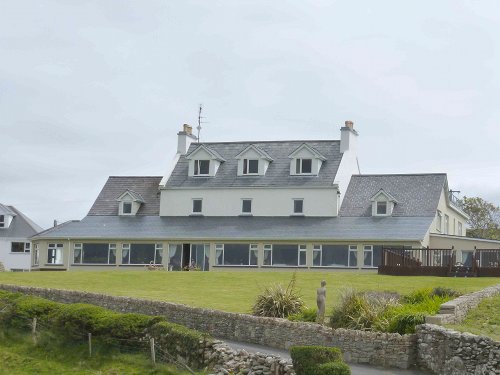 In addition to sourcing, Marguerite finds that paperwork takes up an increasing amount of time. “Especially dealing with seafood, you'll have inspectors looking for documentation on individual fishermen — are they registered and has shellfish been tested? It's not enough to know that correct procedures have been implemented, they want to see everything written down. And I've even had inspectors arriving in the middle of a wedding. "You get the impression that they only care about paperwork, not how the kitchen looks."
In addition to sourcing, Marguerite finds that paperwork takes up an increasing amount of time. “Especially dealing with seafood, you'll have inspectors looking for documentation on individual fishermen — are they registered and has shellfish been tested? It's not enough to know that correct procedures have been implemented, they want to see everything written down. And I've even had inspectors arriving in the middle of a wedding. "You get the impression that they only care about paperwork, not how the kitchen looks."
With her father Involved in the fishing industry, Marguerite is also aware that the fishermen she deals -with are being killed with red tape. They’re expected to keep records of things like the rations carried on each boat and the number of hours of actual work for each man as opposed to time spent waiting between hauling catches. There doesn't seem to be an understanding that fishing isn't a nine-to-five job and dealing with all the documentation is tough when we're all struggling to survive.”
In an area that has been traditionally seasonal. Castle Murray stayed open all winter last year for the first time. “It worked out well," Marguerite confirms. "We started just opening at weekends during January and February, then went to five-day opening, Wednesday to Sunday. In the past we would have closed completely for eight weeks, but we found a market there and we already have bookings for early 2013."
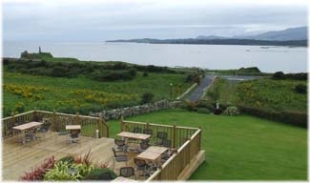 Developments continue apace at Castle Murray, with negotiations underway for grown-to-order organic vegetables from a local allotment. Marguerite has plans for at least seven different varieties of potatoes next season — “we do love our potatoes in Donegal!” And the wine list has been ramped up to include a good selection of half-bottles. " It's a definite trend now, with concerns about driving and it gives people more choice to try different wines with different courses. Predictably, Cbablis, Sancerre and Muscadet are top sellers, but red wine comes on when game dishes appear on the autumn and winter menus.
Developments continue apace at Castle Murray, with negotiations underway for grown-to-order organic vegetables from a local allotment. Marguerite has plans for at least seven different varieties of potatoes next season — “we do love our potatoes in Donegal!” And the wine list has been ramped up to include a good selection of half-bottles. " It's a definite trend now, with concerns about driving and it gives people more choice to try different wines with different courses. Predictably, Cbablis, Sancerre and Muscadet are top sellers, but red wine comes on when game dishes appear on the autumn and winter menus.
As the high season winds down, this outpost of good food on the edge of the Atlantic can claim another successful year, weathering the storm of tough times, " It’s all about community Marguerite says, " Local people and suppliers support each other and that's what will get us through."
The Seafood Interview supported by BIM - The Oar House
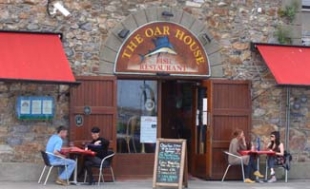
 MARILYN BRIGHT talks to the folk behind Howth’s busiest and buzziest harbourside restaurant, The Oar House – a relatively new restaurant but part of along-established business, and one with its own fishing boat to boot.
MARILYN BRIGHT talks to the folk behind Howth’s busiest and buzziest harbourside restaurant, The Oar House – a relatively new restaurant but part of along-established business, and one with its own fishing boat to boot.
Supported by BIM
Well fed seals splash about the sound off Howth, successfully cadging the odd mackerel or dab thrown off the trawlers that chug into the bustling harbour. The once quiet seaport is vibrant with strollers and shoppers drawn by the colourful rows of rejuvenated warehouses that now house buzzy cafes and fishmongers purveying some of the east coast's finest seafood.
.jpg) The Dorans are no newcomers to the seafaring industries clustered along the coastline. Formerly running trawlers and supplying their fish wholesaling and processing operations from a base in the centre of old Dublin, the firm celebrated 50 years in business last year. As city development encroached 25 years ago, Doran’s moved to Howth, expanding business to include a retail shop that proved a draw to locals as well as sight-seeing city visitors.
The Dorans are no newcomers to the seafaring industries clustered along the coastline. Formerly running trawlers and supplying their fish wholesaling and processing operations from a base in the centre of old Dublin, the firm celebrated 50 years in business last year. As city development encroached 25 years ago, Doran’s moved to Howth, expanding business to include a retail shop that proved a draw to locals as well as sight-seeing city visitors.
Sean Doran recalls that a casual chat with John Aungier of Casa Pasta on the harbourfront triggered the idea for a seafood restaurant on the pier. The two formed a partnership and opened the Oar House in August 2006 converting what had been Doran's smokehouse into a nautically themed restaurant retaining the old beams and corrugated iron roof that bear witness to its industrial past.
The sight of fresh fish being landed from trawlers (one of them their own) literally at the front door of the restaurant proved an irresistible draw for customers and reputation built quickly. "'When we say catch of the day on the blackboards, we really mean fish that has been caught that day,” Sean says.
John Aungier is at the helm in the kitchen and recently accepted the Oar House’s award as Georgina Campbell Seafood Restaurant of the Year 2013 sponsored by BIM. He describes the menu as seafood classics balanced by contemporary trends and makes sure that old favourites are there along with the daily changing catch of the day and blackboard specials. “We try to put at least one or two unusual things on every day. We find that people are willing to be a lot more experimental than they were in the past, hut we wouldn't go too mad or put on anything too complicated."
Oar House fish and chips is a steady winner with fish of the day in crisp beer batter, the chips handcut and served with mushy peas. The fresh Dublin Bay prawns are universal favourites and Doran’s get through 300 kg a week between the shop and restaurant sales. With the downturn in consumer spending, Sean says they aim for a good line-up of less expensive dishes, with a couple of prime fish choices like turbot or sole, which mostly sell at weekends and at holiday times as a treat.
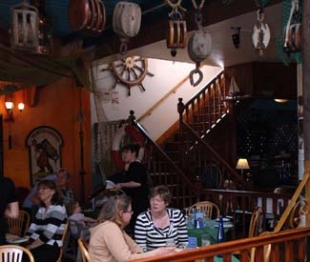 Plentiful mackerel way be simply grilled with herby butter or given blackened cajun treatment with blue cheese mayo. Many of the choices like crab cakes with remoulade sauce or creamy seafood chowder may be ordered as a tapas size starter or main course. With the day's catch displayed on ice, customers can go up to the counter to select their fish for the chefs to cook to order.
Plentiful mackerel way be simply grilled with herby butter or given blackened cajun treatment with blue cheese mayo. Many of the choices like crab cakes with remoulade sauce or creamy seafood chowder may be ordered as a tapas size starter or main course. With the day's catch displayed on ice, customers can go up to the counter to select their fish for the chefs to cook to order.
The Oar House is unique in its seven-day opening, serving from noon to late every day. A busy kitchen brigade of six work in shifts, complementing a 35-strong staff which is a mix of full and part-timers, most of whom have been there long term,. Sean and John take pride in the staff level of knowledge about the food they’re serving and their ability to answer customers’ questions.
“We run a refresher training session once a year,” Sean explains. “We go through the different types of fish and shellfish - the difference between pelagic and demersal fish, where they're caught, what they look like and how they're prepared. Everybody, even old-timers, has to attend and we have a wine tasting afterwards as a bit of a reward.”
Sourcing local, seasonal and organic food as much as possible, along with the key issue of sustainability is the declared aim on Oar House menus. “People are open to eating a greater variety of fish than ever before, so we've moved beyond just cod, plaice and salmon. And we can serve up things like monkfish cheek, so we’re making better use of the whole fish, and that’s not a bad thing.”
The Seafood Interview supported by BIM - QCs
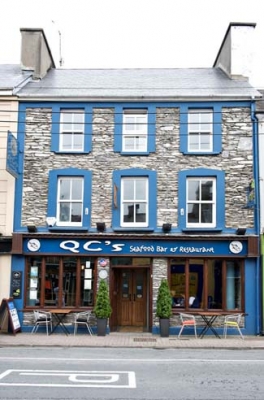
 Marilyn Bright talks to Kate Cooke who, together with her husband Andrew, runs QC’s Bar, Restaurant & Townhouse in Caherciveen, Co Kerry - where, bucking the trend for the area this year, 2013 will go down as a bumper season.
Marilyn Bright talks to Kate Cooke who, together with her husband Andrew, runs QC’s Bar, Restaurant & Townhouse in Caherciveen, Co Kerry - where, bucking the trend for the area this year, 2013 will go down as a bumper season.
Supported by BIM
“The best season ever” is how Kate Cooke describes business at QC’s Bar and Restaurant this year. In addition to winning the title of BIM Seafood Circle Seafood Restaurant of the Year 2012, the family run enterprise has won accolades for the stylish new guest rooms which have added another string to their bow.
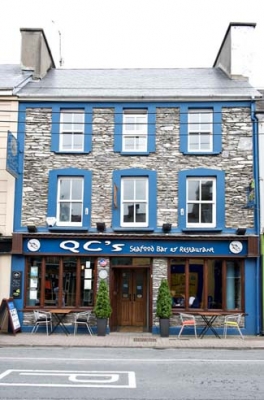 Since opening in 2000, QC’s has earned a top reputation far spanking fresh seafood, not surprising given that Kate is part of the dynasty behind Quinlan's Kerry Fish which runs three fishing trawlers and four wet fish shops. “We're very lucky to have access to fresh fish," she agrees, “but we pay for top quality and serve only fresh, wild local Irish fish. If anybody can get fish when the weather is bad, that's us,"
Since opening in 2000, QC’s has earned a top reputation far spanking fresh seafood, not surprising given that Kate is part of the dynasty behind Quinlan's Kerry Fish which runs three fishing trawlers and four wet fish shops. “We're very lucky to have access to fresh fish," she agrees, “but we pay for top quality and serve only fresh, wild local Irish fish. If anybody can get fish when the weather is bad, that's us,"
Although daytime food business could be busy, Kate and husband Andrew could see that, in common with others in the area, they were suffering from "Ring of Kerry in a day syndrome" Cars and coaches would pass through the towns from morning to late afternoon, then head back to Killarney or Kenmare for dinner and overnighting" And it didn’t help that Cahirciveen had a shortage of accommodation," Kate adds.
That changed in early 2011 - when the Cookes decided to bite the bullet and develop guestrooms. It was a distinct advantage tha Kate had trained in hotel management in Shannon and subsequently spent seven years with the Jury's Group before meeting Andrew in England and bringing him back to Kerry. “We’d taken over an old licensed premises and built up the restaurant over ten years, so we decided that adding guestrooms was a risk worth taking.”
QC’s Townhouse has just completed its second summer season and Kate says that their biggest problem now is that they don’t have enough rooms. Steady demand for the five rooms means ten extra diners in the bar and restaurant - and that attracts others,” Kate points out. Having acccommodation has also opened up new markets like the golfing and angling sectors, “We’ve been named preferred supplier of food and accommodation to Peninsula Pass, a grouping of The Dooks, Skellig Bay and Ring of Kerry Golf Clubs, and independent tourists stay longer and do more in the area when there's good accommodation.”
The restaurant has been expanded too, with a glass covered courtyard carved from the hillside and made colourful with tiles that reflect a bit of Spanish bias to the menu. Olive oil and garlic bring Mediterranean flavours to sizzling Dingle Bay prawns with a spark of chilli or crispy calimari frito with lemony aioli. A house specialty of Valencia crab from down the road is baked in chilli and garlic cream sauce and served with tomato and avocado salad, as a starter or main course.
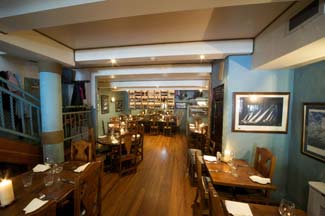 QC's crisp battered fish with handout chips is a perennial favourite served in classic style with mushy peas. Kate reveals that the secret of their ultra light and crispy coating is in the batter made up with one part of cornflour to three parts plain flour mixed with frothy beer. “We try to keep things simple and concentrate on getting the freshest and best quality seafood even though it's more costly than farmed and frozen fish. Our crab for instance, is always fresh from Valencia even though it's more expensive than the pasteurised and processed crabmeat."
QC's crisp battered fish with handout chips is a perennial favourite served in classic style with mushy peas. Kate reveals that the secret of their ultra light and crispy coating is in the batter made up with one part of cornflour to three parts plain flour mixed with frothy beer. “We try to keep things simple and concentrate on getting the freshest and best quality seafood even though it's more costly than farmed and frozen fish. Our crab for instance, is always fresh from Valencia even though it's more expensive than the pasteurised and processed crabmeat."
Head chef Eddie Gannon has been with the Cookes for seven years and has developed a menu that includes favourites like scallops mornay made with local cheddar and creamy potato-topped seafood pie combining wild salmon, whitefish and prawns. Thai red seafood curry with scented rice appeals to modern tastes and the catch of the day is flagged on a specials blackboard - perhaps monkfish and scallops with a red pepper purée or roast hake with samphire, prawn, mussel and lemon risotto.
Ray wings, seldom seen outside Dublin, are paired with lemon and shrimp butter at QC's , a dish that was a hit with the crew of a Spanish trawler grounded for repairs in the harbour, "I was puzzled when the plates came back completely cleared,” Kate recalls. "Then I was told that the Spanish custom is to eat ray wings bones and all."
Looking back on their best season ever, the Cookes feel that maintaining quality through the hard times has been worth it. "The combination of the restaurant and accommodation has been greater than the sum of its parts," Kate reflects, "We've bucked the trend and expanded our market - now we're considering extending our winter season, so watch this space!”
The Seafood Interview supported by BIM - Aldridge Lodge
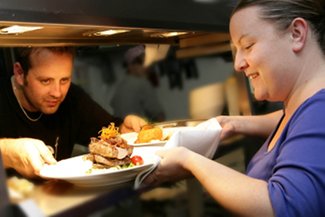
 MARILYN BRIGHT talks to our Seafood Chef Of The Year For 2013, Billy Whitty, of Aldridge Lodge, Duncannon, Co Wexford
MARILYN BRIGHT talks to our Seafood Chef Of The Year For 2013, Billy Whitty, of Aldridge Lodge, Duncannon, Co Wexford
Supported by BIM
A chef who has grown up living just 200 yards from the Duncannon quayside just has to know something about fish. In fact, Billy Whitty of Aldridge Lodge who has been named Seafood Chef of the Year 2013 can draw on a background of seafaring tradition and hospitality spanning the generations.
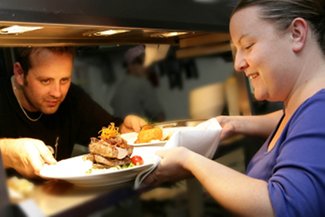 Billy's father is a crab and lobster fisherman, a brother-in-law runs trawlers off the south coast and in the past his grandmother ran the town's only hotel in a Georgian house overlooking the beach. Although Billy shared the family interest in good cooking at home and regular dining out at better restaurants peppering the south, his career path was far from certain. An application for a CERT course was not successful, “And I’m seasick in anything larger than a rowboat," Blly adds “So fishing wasn't an option.”
Billy's father is a crab and lobster fisherman, a brother-in-law runs trawlers off the south coast and in the past his grandmother ran the town's only hotel in a Georgian house overlooking the beach. Although Billy shared the family interest in good cooking at home and regular dining out at better restaurants peppering the south, his career path was far from certain. An application for a CERT course was not successful, “And I’m seasick in anything larger than a rowboat," Blly adds “So fishing wasn't an option.”
During school holidays, Billy had started a fish round, filleting fish straight from the boats and delivering in an inherited refrigerated van. He covered a lot of territory, with several restaurants as customers and selling house to house around Waterford. When Kevin and Catherine Dundon opened Dunbrody House nearby, Billy jumped at the opportunity of a kitchen job, working alongside Kevin and learning as he went. Within 18 months he was sous chef in the tightly run kitchen with its brigade of four and the country house hotel and restaurant was winning awards and raising its profile.
In addition to building skills and learning the workings of a professional kitchen, Billy met another young chef, Joanne Harding, who was to become his partner in life as wall as business. Eventually, at the age of 22, Billy struck out on his own and with Joanne, took over the lease at Horetown House, with grand 18th century rooms and well established business conveniently situated midway between Wexford and Waterford.
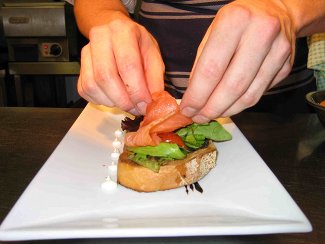 Here the young chef continued to develop his own style, building on the principles of using best quality ingredients and making the most of local produce. “ Flexibility is key," Billy observes, "especially when you're dealing with seafood — you just have to depend on the weather and whatever is best on the day. I could never work from a set printed menu and I enjoy making up a new menu every day — even the old favourites can be tweaked to keep things more interesting for the kitchen as well as the customer. I cook what I feel like on any particular day."
Here the young chef continued to develop his own style, building on the principles of using best quality ingredients and making the most of local produce. “ Flexibility is key," Billy observes, "especially when you're dealing with seafood — you just have to depend on the weather and whatever is best on the day. I could never work from a set printed menu and I enjoy making up a new menu every day — even the old favourites can be tweaked to keep things more interesting for the kitchen as well as the customer. I cook what I feel like on any particular day."
Billy and Joanna moved on to open Aldridge Lodge in 2005 as a restaurant with rooms in a modem stone-fronted dormer home and were named Georgina Campbell's Newcomer of the Year in 2006. Set above the village of Duncannon with views of the beach and mountains, the dining room seats 34 and there are three guest bedrooms. With his business head on, Billy says they were able to set up without a huge outlay of money. “My sister's company did the build and it's designed so that it could be sold as a family house if the business didn't work out."
Most of the fish on Aldridge Lodge menus comes from local boats working out of Kilmore Quay, with scallops, hake, haddock, prawns, squid and monkfish appearing regularly. He acknowledges his luck in getting first choice of prime like black sole and turbot that Dublin chefs can find difficult to source. Naturally, lobster from the senior Whitty's boat is a house speciality, but like the other seafood, is subject to weather, " You can't put lobster pots oat in a run of bad weather" Billy points out, “They just get broken up."
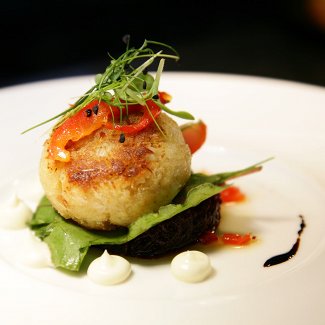 Crab is a popular starter served with homemade mayonnaise, tempura crab toes and peanut butter powder. Sprats are smoked locally and served with braised beetroot and creme fraiche while seared Kilmore Quay scallops come with red onion marmalade and toast made from Billy's dark flecked black pudding bread.
Crab is a popular starter served with homemade mayonnaise, tempura crab toes and peanut butter powder. Sprats are smoked locally and served with braised beetroot and creme fraiche while seared Kilmore Quay scallops come with red onion marmalade and toast made from Billy's dark flecked black pudding bread.
Keeping it simple and letting quality ingredients speak for themselves is a mantra, but the inventive chef enjoys playing with contrasts of texture and flavour. Thin slices of scallop go into crisp spring rolls to accompany pan-seared Kilmore Quay cod with lemon, caper and prawn butter sauce. Pairings of meat and seafood go beyond the usual surf and turf with twice-cooked pork belly teamed with squid rings and three textures of carrot — powder, purée andcrispy carrot noodles.
Tiger prawns never appear on Aldridge Lodge menus and Billy admits- annoyance on seeing sea bass appearing on a number of menus in the recent Waterford Festival. “Farmed sea bass is all coming from Greece,” he points out, “and wild Irish caught sea bass is illegal. With so much fresh fish available beside us, I just don't understand it."
Billy's menus are built around all that is local and home grown. With a plot of more than seven acres, there are polytunnels and raised beds to supply the restaurant with fresh herbs and prodigious quantities of vine ripened tomatoes and courgettes. Potatoes are from a local farm and more veg comes twice a week from Growers Direct, sourced from small allotments around New Ross. Salad leaves and extras like squash come from the parents’ farm and free range pork is reared by a sister.
Beef is 21 day dry-aged rib-eye and holiday menus feature wild venison paired with local mushrooms and a Christmas dinner pairs confit goose leg with char-grilled turkey escalope, spicy brussels sprouts, potato croquette, apple purée and cranberry gravy.
Altogether, 2012 has been a landmark year for Billy and Joanne, crowned with the arrival of their first baby during the summer. “Being named Seafood Chef of the Year was a great boost,” Billy adds, “and better still, Aldridge Lodge has had the best year since we opened.”
The Seafood Interview supported by BIM
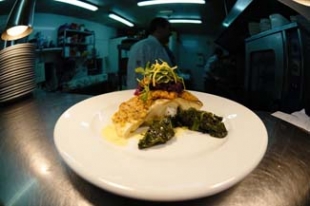
 Marilyn Bright talks to Geoff Jones, owner and head chef of The Fairways Bar & Orchard Restaurant near Nenagh Co Tipperary, of the joys and challenges of running a rural restaurant specialising in seafood
Marilyn Bright talks to Geoff Jones, owner and head chef of The Fairways Bar & Orchard Restaurant near Nenagh Co Tipperary, of the joys and challenges of running a rural restaurant specialising in seafood
Passion for good food and looking after his customers comes barreling out of Geoff Jones from the first moment of contact. His enthusiasm and energy have seen The Fairways Bar and Orchard Restaurant through, as tough years of recession have hit rural business with particular force.
Bought six years ago, just before the downturn, the premises was “run down, and in the middle of nowhere outside Nenagh, but it had a lot of character and I could see it just needed a bit of love,” Geoff recalls. “It was well known locally as ‘The Lucky Bag’ because of some Irish Sweepstake win in the past, but it needed a new identity and a reputation that would be built on food rather than drink. I’m interested in all kinds of good food but I’m really passionate about fish, which is unusual in the middle of Ireland and nobody was serving much around here at the time, so I decided that would be an interesting speciality, a real point of difference between us and other businesses in the area.”
 With a new name inspired by the neighbouring Nenagh Golf Club, The Fairways was smartened up to provide a warm and inviting atmosphere while retaining traditional elements such as the glowing fireplaces and old stained glass. A comfortable dining space was created and christened The Orchard Restaurant, while the kitchen was geared up to serve up to 120 covers between both bar and restaurant.
With a new name inspired by the neighbouring Nenagh Golf Club, The Fairways was smartened up to provide a warm and inviting atmosphere while retaining traditional elements such as the glowing fireplaces and old stained glass. A comfortable dining space was created and christened The Orchard Restaurant, while the kitchen was geared up to serve up to 120 covers between both bar and restaurant.
Geoff’s father worked in stainless steel fabrication with Masser Hammond, so remembers being in and out of professional kitchens from an early age and it was a natural progression to train at Cathal Brugha Street. Experience in some of Ireland’s great classic kitchens followed, and he likes to do things right. Quality food made in-house is the foundation of Geoff’s menus, with special pride taken in the homemade breads, pastas, terrines and ice cream - and, of course, the fish. “Instead of just ordering from a fish supplier, I go to Rene Cusack in Limerick two or three times a week to choose fish straight off the trucks as it comes in, so I’m sure of getting the widest possible choice and at its freshest.”
The menus at The Fairways Bar and Orchard Restaurant are highly unusual - especially for a restaurant so far from the sea - in that they offer a huge range of fish and seafood. While there will be less choice in winter, there may be 15 to 18 different species offered at certain times of year, although probably not all at the same time. And something else which you won’t see often is that the approach is very flexible, with menus changing every day and an amazing amount of choice offered to customers, not only in terms of the fish itself but also the way it is prepared and cooked. Geoff likes to show customers the fresh fish and give them the option of how they’d like it done - filleted or on the bone, steamed, baked, pan-fried or finished with a flavoured sauce or butter - the choices seem to be endless and nothing is too much trouble.
Menus for the day are only decided each morning and Geoff confesses to enjoying the challenge and to encouraging "a bit of passion and originality" from the other chefs in his brigade. He’s a firm believer that the awards on the door are only as good as the chef in the kitchen and he has regular sit-down sessions with staff for reviews and brainstorming new ideas. "I have to say our chefs love what they’re doing and the chat in the kitchen tends to be less about football and more about what Heston Blumenthal was doing on television last night.”
Geoff’s chefs are cautioned not to put anything on a plate that they wouldn't be pleased to eat themselves and, when issues arise about a customer's food, they’re not allowed to hide behind kitchen doors. “It’s not fair for the front of house to take the flack if there's a problem concerning the food.” The upside for Fairways chefs was this year's Christmas present from Geoff — a master class in Derry Clarke’s kitchen and dinner that night in the Michelin starred L'Ecrivain.
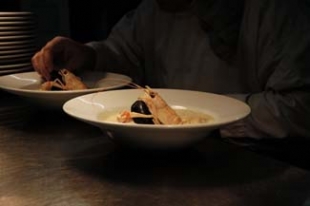 Although Geoff is proud of the team he has built up at The Fairways, he professes to being a bit disappointed with the current training in catering colleges. “There’s more to professional cooking than just opening packets - fish doesn't come out of the sea in neat little fillets. You need to get the full experience, handle fish, know where it's coming from and how to keep and prepare it.”
Although Geoff is proud of the team he has built up at The Fairways, he professes to being a bit disappointed with the current training in catering colleges. “There’s more to professional cooking than just opening packets - fish doesn't come out of the sea in neat little fillets. You need to get the full experience, handle fish, know where it's coming from and how to keep and prepare it.”
Fortunately BIM have recognised the need for helping chefs and others with an interest in developing their practical skills in this area, and they offer hands-on “Fish Handling and Filleting” workshops in Clonakilty, which are facilitated by Hal Dawson, an experienced trainer and filleter who has worked in the industry for many years.
The workshops cover a wide range of skills, including species identification, hygiene and safety, safe knife handling and a variety of filleting techniques. The next two day courses, which are each restricted to six participants, are beginning 28th January and 4th February (for further information visit ww.bim.ie, or call Lorraine O’Byrne 01 214 4185).
At The Fairways, Geoff has a very hands-on approach to fish handling too - and at least one intern has learned that the boss’s convictions are more than mere rhetoric when he was sent off on a trawler for a day's fishing and experience filleting fish straight out of the briny.
Local produce like the Tipperary reared Piemontese beef (irishpiemontesebeef.ie) is always on the menu too, and the latest project is the adjacent acre that Geoff has taken to install a polytunnel and grow his own vegetables, herbs and salads.
"Everything is aimed at creating a good experience for customers. We have a baby grand piano and live music at the weekends, as well as themed events like French or Mexican evenings. It takes real effort to get people out in these challenging times but we try to attract customers with quality and by offering something different, especially through our seafood cooking. And we offer a complimentary Daimler service that local diners can book at weekends, so they can relax and enjoy their evening out. People may be only going out every three weeks instead of every two, but we've seen our customer base growing and that makes the hours you put in worth the effort."
The Seafood Interview supported by BIM - The Tavern Bar & Restaurant
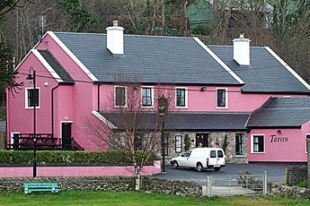
 This month Marilyn Bright talks to Myles O’Brien of The Tavern Bar & Restaurant at Murrisk, Co Mayo, where local seafood is emphatically the star of the show
This month Marilyn Bright talks to Myles O’Brien of The Tavern Bar & Restaurant at Murrisk, Co Mayo, where local seafood is emphatically the star of the show
Warnings of gale force winds and fifty-foot waves might seem like bad news for many coastal businesses, but at The Tavern Bar and Restaurant above Mayo's Clew Bay, it's a call to step up production in the kitchen. When storms at sea are brewing, the mighty rollers attract super-fit surfers from every corner of the globe and their reviver of choice is The Tavern's hearty seafood chowder served up with homemade brown bread.
Myles and Ruth O'Brien’s seafood mecca at Murrisk has been serving up their ocean-fresh specialities for thirteen years, and it’s a popular port of call for holiday makers heading to nearby beaches or pedalling along the Atlantic cycle path at the bottom of the Tavern's garden.
And, as Croagh Patrick looms above, the wave of pilgrims and mountain walkers climbing this iconic peak mean that numbers dining in the bar, restaurant and garden terrace can rise to as many as 500 - 600 a day at the height of the sunnnier season.
"We were the first in the area to make a feature of seafood and, as the water in Clew Bay is so pure, local seafood is a huge part of our menu," Myles comments. “We get specialities like local oysters and lobsters delivered straight into the door. ”
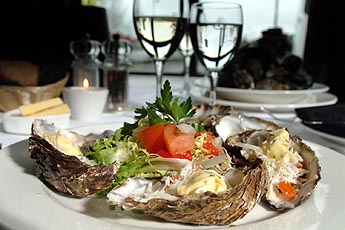 Myles, who trained as a chef at RTC Galway, went on to spend three years in Australia in seafood and Asian restaurants and a further three years in Boston, a city famously described as the home of the cod. Ruth trained in hotel management in Cathal Brugha Street and arrived in Boston's Ritz Carlton via Marlfield House and Ashford Castle.
Myles, who trained as a chef at RTC Galway, went on to spend three years in Australia in seafood and Asian restaurants and a further three years in Boston, a city famously described as the home of the cod. Ruth trained in hotel management in Cathal Brugha Street and arrived in Boston's Ritz Carlton via Marlfield House and Ashford Castle.
Returning together to Ireland, the couple recalls the year spent demolishing and rebuilding the old licensed premises they bought at the foot of the ascent to Croagh Patrick in Murrisk. In the beginning, the O'Briens lived above the bar-restaurant and, as business expanded, the upstairs was revamped to provide a fine dining space. "But things change and you have to adapt to the times," Myles observes, "As fine dining declined, we upgraded the bar menu to bistro style and now we have three areas serving food all day.''
Fresh lobsters in a tank greet summer visitors and Murrisk farmed oysters are served up in half a dozen ways - Kirkpatrick style grilled with bacon lardons, oysters Rockefeller finished with spinach and hollandaise, beer battered in a crispy coating, or simply au naturel with red onion vinaigrette.
Fish is mostly local and flagged on the menu - organic salmon and sea trout from Clare Island, langoustines from Killary harbour, Sean Grady's farmed clams and Clew Bay mussels and summer mackerel. Supplier Honoretta McNamara gets a special menu mention in Honoretta's fresh Cleggan scallops served up with award winning black pudding from Kelly's of Newport.
Scallops may also feature in classic coquilles St. Jacques or the Tavern's rib-sticking seafood pie with chunky fish in creamy white wine and dill sauce under a potato topping. Fresh baked cod with Clew Bay mussels in a tomato, coriander and garlic sauce is one of the most popular dishes Myles says, second only to the signature chowder, The Tavern's seafood chowder, a creamy style with a good variety of fish made to Myles’ recipe, is adapted from the chowder served in the Boston Prince Charles Hotel and sells "by the ton”.
Prep is done in-house, with bones and shellfish trimmings used for stocks and sauces. Prawns are shelled in the kitchen and the shells and heads are then cooked down with leeks, onions and tomato purée to make the red stock for a seafood tagliatelle main course.
.jpg) Although Myles reckons that at least ten different varieties of fish appear on the menu most days from April to September, continuity of supply can be problematical on the West coast, when boats are affected by weather and sea conditions. Two years ago he invested in a blast chiller and vacuum packer which enables him to buy in quantity when supplies are good.
Although Myles reckons that at least ten different varieties of fish appear on the menu most days from April to September, continuity of supply can be problematical on the West coast, when boats are affected by weather and sea conditions. Two years ago he invested in a blast chiller and vacuum packer which enables him to buy in quantity when supplies are good.
"To keep the quality, fish has to be dealt with right away. When we get a big delivery of something like pollock fresh off the boat, I have a retired local fisherman who comes in to help and we'd often work into the night after staff have gone home. The prepped fillets are packed in portions of four, chilled immediately and they'll be just as fresh when we're ready to use them."
Reflecting on changes he’s seen over the dozen or so years, Myles recalls a dining out market that was very much ‘well-done steak and salmon’. ''Food culture has grown now and people's expectations are higher. The Greenway has brought tourism to this part of Mayo, and international visitors have added influences. Ten years ago you couldn't have sold anything like the cajun spiced sea trout or fish cakes with Thai green aioli that are on our menu now."
Myles also finds that customers are willing to try new things when they're properly explained. "Servers must taste dishes so they can sell with confidence. With a good product and enthusiastic staff you can educate people to open their taste buds and get the most enjoyment when dining out.”
The Seafood Interview supported by BIM - La Bohème Restaurant
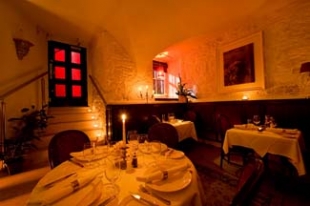
 This month Marilyn Bright talks to Christine & Eric Thèze of La Bohème Restaurant in Waterford City, where seafood is an increasingly important item on the menu
This month Marilyn Bright talks to Christine & Eric Thèze of La Bohème Restaurant in Waterford City, where seafood is an increasingly important item on the menu
Hong Kong, Paris, Brazil and the United States - globe-trotting Christine and Eric Thèze put the nomadic life behind them when they decided to settle in Waterford and opened La Bohème Restaurant six years ago. With a name derived from a favourite song by Charles Aznavour rather than the opera, the restaurant is a smartly Gallic setting for Eric’s classically based modern food which has given food lovers plenty to sing about.
Growing up in a seaside town in Brittany, Eric had first hand experience on fishing boats while progressing through the chef apprenticeship system in France. Gravitating to his preferred section as saucier, his expertise with classics like beurre blanc and sauce vierge brought him to work in the United States, where association with other international chefs introduced him to the flavours of Asia, the Caribbean and far-flung tropics that blended seamlessly with his own style.
Eric's first port of call in Ireland was as private chef at Humewood Castle in Wicklow, then a stint with Johnny Cooke in Dublin. Travelling around Ireland confirmed to the couple that big city life was not for them and they were delighted to be offered a place on the banks of the lovely Lee at the renowned Arbutus Lodge with the Ryan brothers.
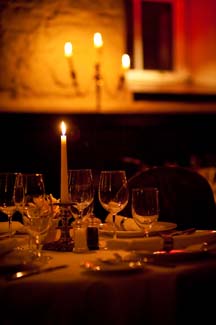 With the closure of that landmark restaurant, Eric moved to the elegant Faithlegg House Hotel in Waterford, busy with golfers, leisure guests and up to 75 weddings a year, all drawn by the excellent reputation for fine dining. It was a hectic sort of life, Christine admits, but Eric developed a regard for the area, the local produce and the fresh seafood that reminded him of his home in Brittany.
With the closure of that landmark restaurant, Eric moved to the elegant Faithlegg House Hotel in Waterford, busy with golfers, leisure guests and up to 75 weddings a year, all drawn by the excellent reputation for fine dining. It was a hectic sort of life, Christine admits, but Eric developed a regard for the area, the local produce and the fresh seafood that reminded him of his home in Brittany.
Christine recalls the day she came across space being offered in the lower ground floor of the historic Port of Waterford building. Without telling Eric, she arranged a viewing and remembers trying to conceal her excitement from the landlord as she saw the potential of the high vaulted ceilings, granite archways and stone floors.
The space had been vacant for several years and the budding restaurateurs were to discover the rigours of dealing with a listed building with walls four feet thick, requiring most of the work to be done by hand rather than heavy machinery. In the end, the renovation took a year and a half, “but it was exciting to see it all come to life," Christine recalls.
A light well off the dining room makes the kitchen partially open and Eric encourages customers to come up and chat as he works. Many of La Bohème's diners are regulars and he values their comments and feedback on dishes. " People have come to trust Eric’s cooking and they're willing to try new things," Christine says. "We sell more seafood than meat, even on Christmas party menus, and his signature crème brulée of crab has become very popular. It has a savoury herb base and Parmesan crust and most often appears as part of a trio with wasabi marinated salmon and a rillette of haddock."
Eric counts himself lucky to have fresh seafood on his doorstep and supplies come from the Whittle brothers at Flanagan's Fish Merchanta, who buy at the nearby Dunmore auctions. Lobsters and fresh picked crabmeat come from James and Maurice O'Rourke. Prawns may appear simply served up in the French way with homemade mayonnaise, or more cost-effectively as part of another dish such as seafood terrine or a stuffing for loin of rabbit.
La Bohème menus regularly feature popular fish such as haddock, monkfish, hake and John Dory - all freshly caught off the South coast, but it is a slight frustration to Eric that much of the less usual fish by-passes Waterford and gets sent straight up to Dublin's bigger markets. "I'd like to get more variety like gurnard, pollock and fresh ling. It's even hard to get turbot and sole because it goes straight up to Dublin.”
While Eric’s penchant is for the classic butter-rich cream sauces of his French training, Christine encourages him to keep things lighter, so sea bream fillets may be paired with olive, pepper and basil salsa. Medallions of Dunmore East monkfish and chickpeas come with a garlicky Moroccan tomato sauce spiked with harissa while another dish is complemented by a Pacific Rim coconut sauce.
Having seen their own customers' preference change from "mostly meat" to a 70 per cent bias towards fish, the Thèzes feel that there is even greater potential for seafood, recounting a recent experience with a visiting relative. A scenic weekend drive along the coast to Hook Head and Kilmore Quay gave them a yen for fish to bring home, but there was nothing available. The French uncle commented, "Anybody who opens a fish shop here on Sundays would make a fortune."
 In common with other businesses, Eric and Christine had to adapt to change as the recession kicked in. “We dropped plans of going for a Michelin rating and decided to offer value with a ‘Menu du Marché' ” Christine explains, “It includes a mise en bouche, starter, choice of five or six mains and desserts or cheese trolley. It has brought in customers and good repeat business and we still offer à la carte - which can suit anyone who just wants one or two courses or something different."
In common with other businesses, Eric and Christine had to adapt to change as the recession kicked in. “We dropped plans of going for a Michelin rating and decided to offer value with a ‘Menu du Marché' ” Christine explains, “It includes a mise en bouche, starter, choice of five or six mains and desserts or cheese trolley. It has brought in customers and good repeat business and we still offer à la carte - which can suit anyone who just wants one or two courses or something different."
Innovative promotions ensure that La Bohème never rests on its laurels. Eric has had columns and recipes in Waterford's Munster Express, and cookery demonstrations are part of the regular ' Jeudi Jazz' — Thursday jazz evenings.
In late March the restaurant will be central to the 'Let's French Again’ festival organised by the Alliance Francaise. With a clutch of other restaurants committed to using local produce, they'll also be part of a Slow Food weekend scheduled for May, with tours to producers followed by meals based on food sourced within a ten mile radius of Waterford.
Within six years, Eric and Christine have become part of the community, promoting their restaurant, the excellent local produce and the beauties of their area, Christine was a member of the committee which organised the week-long Harvest Festival in Waterford last autumn. "We hope to make it the biggest food fair in Ireland," she says. And you'd have every confidence they'll succeed.
The Seafood Interview supported by BIM - The Moorings

 This month Marilyn Bright talks to Patricia Kennedy of The Moorings in Portmagee, Co Kerry, where even traditional accompaniments like colcannon and boxty have been given a local seafood twist
This month Marilyn Bright talks to Patricia Kennedy of The Moorings in Portmagee, Co Kerry, where even traditional accompaniments like colcannon and boxty have been given a local seafood twist
Lemon sole turned in butter, fresh baked brown broad and steaming pots of tea with views of the mist clearing over Valentia Island and the rolling Atlantic between - breakfast at The Moorings in Portmagee is the sea lovers’ idea of bliss.
The award winning guesthouse and restaurant grew from The Bridge Bar, a quiet harbourside pub run by Patricia Kennedy's family from the 1950's. When Patricia and her husband Gerard took over in 1988, she recalls how they gradually introduced simple food from the tiny kitchen - local crab claws and smoked salmon salad, seafood chowder and homemade soda bread, apple tart and cream and the Irish whiskey cake that is still a Moorings teatime favourite. “The food really took off,” Patricia remembers, “Because there was very little at the time catering for tourists taking the coastal route off the Ring of Kerry. Our customers were nearly all tourists and holiday visitors then because locals just didn't eat out thirty years ago.”
 As the pub food business grew, overhead living quarters were converted to five guestrooms for the increasing number of visitors who found the picturesque harbour a pleasant place to linger. Before long, further expansion was on the cards and the next door building was annexed to become The Moorings Restaurant with more guestrooms above. The restaurant opened in 1994 and Patricia recalls with relief, "At last we had a proper kitchen and I was able to hire a proper chef."
As the pub food business grew, overhead living quarters were converted to five guestrooms for the increasing number of visitors who found the picturesque harbour a pleasant place to linger. Before long, further expansion was on the cards and the next door building was annexed to become The Moorings Restaurant with more guestrooms above. The restaurant opened in 1994 and Patricia recalls with relief, "At last we had a proper kitchen and I was able to hire a proper chef."
Chef Noel Dennehy presides today over a menu that has developed into a celebration of the spectacularly good food that abounds in this corner of Kerry. Seafood listings read like a traveller's itinerary — Dingle Bay prawns, fresh Portmagee crab, Valentia scallops, Cromane mussels and oysters. Both Noel and Patricia are adamant that ingredients this good don't need complication. "You'll find no sprays or foams here”, she says.
.jpg) The original seafood chowder remains top order in both bar and restaurant, closely followed by the Skellig crab claws with garlic butter. The popular trio of seafood changes daily as the catch arrives - perhaps fillet of hake, brill and wild Irish turbot simply served with lemon butter. Traditional accompaniments might be given a seafood twist too, as in the Dingle Bay prawn colcannon to go with grilled fillet of hake or Portmagee crab flavoured boxty potato cake served with pan-fried Valentia scallops.
The original seafood chowder remains top order in both bar and restaurant, closely followed by the Skellig crab claws with garlic butter. The popular trio of seafood changes daily as the catch arrives - perhaps fillet of hake, brill and wild Irish turbot simply served with lemon butter. Traditional accompaniments might be given a seafood twist too, as in the Dingle Bay prawn colcannon to go with grilled fillet of hake or Portmagee crab flavoured boxty potato cake served with pan-fried Valentia scallops.
Provenance is celebrated throughout The Moorings menus, which could quite usefully come with a map for the uninitiated. In addition to the Atlantic seafood riches, there is Sneem black pudding, Valentia Island ice cream, Ring of Kerry lamb and oak smoked bacon and sausages from Kieran Hartnett in Tralee. A dedicated page of the menu lists local producers of everything from eggs to buttermilk and honey, even the organic tomatoes, herbs, salad leaves and berries grown by the chef's wife Maureen Dennehy for the kitchen.
“Our suppliers are important to us and were instrumental in our receiving the Green Hospitality Gold Award for Environmental Management,” Patricia explains. “We were one of just five nationwide to receive the top award for achieving environmental savings in the areas of waste reduction, recycling, food sourcing and reducing food miles.”
 Portmagee revels in being named fourth best place to live in Ireland, and was further crowned by being named National Tourism Town of the Year 2012. Judges commended the community spirit which "has woven its fishing past and present into its story". The Kennedys and the hardworking local community are especially chuffed to have won over major players like Killarney and Westport. “It's so hard for a small community to make it in the tourism game," Patricia comments.
Portmagee revels in being named fourth best place to live in Ireland, and was further crowned by being named National Tourism Town of the Year 2012. Judges commended the community spirit which "has woven its fishing past and present into its story". The Kennedys and the hardworking local community are especially chuffed to have won over major players like Killarney and Westport. “It's so hard for a small community to make it in the tourism game," Patricia comments.
The early decision to buck the trend and stay open year round and to up the ante with food offerings was key in setting the business on the upward track, Patricia reflects, "You can't do half a job - you're either in it or you're not,” she says, and the innovations keep coming. The environmental award inspired a 'Green Package' consisting of two nights B and B, a guided wildlife shore search and special Thirty Mile Menu with all ingredients sourced within a 30 mile radius.
Patricia likes to keep the menu fresh with the addition of new dishes, although customers don't allow tinkering with hardy favourites like the seafood marinière which was brought back by popular demand. This season, Spain's loss was Kerry's gain as hake stocks formerly snapped up for export are more available on the Irish market. This prime fish is being smoked by Daly's of Caherciveen and appears on the bar menu as tempura of naturally smoked hake with mushy peas and chips. "It's absolutely flying," Patricia says.
The spring season is under way in Kerry and the Kennedys have seen the return of three or so tour buses a week. "You have to work harder when you're a bit out of the way," Patricia observes, “but things are going well and we're determined to keep tight margins without sacrificing quality. When it comes to our food we like to say ‘it's simply grown, simply prepared and simply enjoyed.' "
The Seafood Interview supported by BIM - The Exchange Restaurant at The Westin Hotel
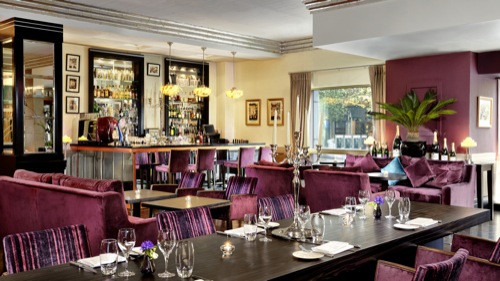
 This month Marilyn Bright talks to John Hickey, Head Chef of The Exchange Restaurant at the Westin Hotel, Dublin 2, where an innovative Daily Catch menu offers diners a choice of cooking methods, side dishes and sauces for their daily-changing selection of spanking fresh fish.
This month Marilyn Bright talks to John Hickey, Head Chef of The Exchange Restaurant at the Westin Hotel, Dublin 2, where an innovative Daily Catch menu offers diners a choice of cooking methods, side dishes and sauces for their daily-changing selection of spanking fresh fish.
A stone's throw from the quays where street hawkers once cried their fresh herrings, cockles and mussels, The Exchange Restaurant in Dublin's Westin Hotel is enticing diners with fresh seafood menus that change with the daily catch.
In an initiative that has been in place for the past year, head chef John Hickey receives a list of the day's catch as the boats head back into port overnight and plans the day's menu as the fish is en route to the hotel's kitchens. “We're dependent on our suppliers and we've had impressive service from Quinlan's in Cahirciveen. Fish can be expensive if it's not used so we don't carry a huge stock, with typically three choices on our special fish menu on any given day," John explains.
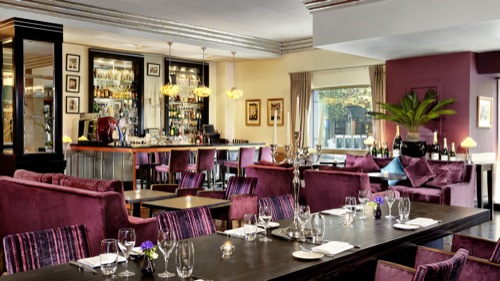 While the main à la carte menu features starters of Carlingford oysters - natural or Rockefeller style, crab cakes and spring rolls, king scallops and prawns, the changing fish of the day menu is separate. Restaurant manager Dermot Green explains that customers select their preferred fish, the side dishes and one of the half-dozen sauces that range from hollandaise or prawn butter to salsa verde and spicy chipotle chilli aioli. While a typical day's choice might appear on the menu as roasted fillet of hake, baked plaice with sundried tomato and herb crust and pan-fried sea bream, the chef is happy to cook the fish any way the diner wishes.
While the main à la carte menu features starters of Carlingford oysters - natural or Rockefeller style, crab cakes and spring rolls, king scallops and prawns, the changing fish of the day menu is separate. Restaurant manager Dermot Green explains that customers select their preferred fish, the side dishes and one of the half-dozen sauces that range from hollandaise or prawn butter to salsa verde and spicy chipotle chilli aioli. While a typical day's choice might appear on the menu as roasted fillet of hake, baked plaice with sundried tomato and herb crust and pan-fried sea bream, the chef is happy to cook the fish any way the diner wishes.
When the daily catch menu was introduced, they expected greatest uptake from female diners, but that has not been the case, Dermot has observed. Seafood is now equally popular with men, and increasingly, with children in family groups at the weekend and bumper holidays like St Patrick's day. "We'll do small portions of any fish of the day for the kids, or homemade fish nuggets made from the fillets, rolled in panko crumbs, just browned and finished in the oven so they're not deep-fried," John says.
Sharing plates add extra choices, with an oyster platter or a seafood selection that includes crab, prawns, smoked salmon and oysters with homemade brown scones, A Mediterranean platter pairs spicy merguez sausage with Dublin Bay prawns, Parmesan aioli and toasted sourdough bread. The oysters come from Carlingford and are especially popular with French and American visitors.
With a glass frontage overlooking the elegant pillars of the Bank of Ireland, The Exchange Restaurant has direct access from busy Westmoreland Street as well as from the hotel's spacious reception area. This was a deliberate design, Dermot explains. “The Westin's view is that the city centre restaurant should be accessible for everyone, not just the residents, and that diners needn't pay over-inflated prices, even though this is a five star hotel."
 Signally perhaps, for a hotel whose opening day fell on the infamous 9/11 of 2001, attention to pricing has always been a precept. . An “Early Doors" dining menu is in place from 6-7.30pm and a weekly no corkage BYOB evening is flagged as "Wine on Wednesdays - It's on your house". Chef Hickey minds food costings with an eye to market prices. “We'd rarely put on Dover sole because it's so expensive, but hake is more available now at a reasonable price and lesser used fish like gurnard and mackerel are popular with customers. The mackerel in particular sells well, I think because people associate it with summer holidays when they were children and it's a fine fish when it's absolutely fresh.”
Signally perhaps, for a hotel whose opening day fell on the infamous 9/11 of 2001, attention to pricing has always been a precept. . An “Early Doors" dining menu is in place from 6-7.30pm and a weekly no corkage BYOB evening is flagged as "Wine on Wednesdays - It's on your house". Chef Hickey minds food costings with an eye to market prices. “We'd rarely put on Dover sole because it's so expensive, but hake is more available now at a reasonable price and lesser used fish like gurnard and mackerel are popular with customers. The mackerel in particular sells well, I think because people associate it with summer holidays when they were children and it's a fine fish when it's absolutely fresh.”
Catch of the day features downstairs too, in the award winning Mint Bar, along with traditional beer battered fish and chips. More formal dining for weddings and events takes place in the elegant ballroom where chandeliers glitter in what was once a grand banking hall. Banqueting food is all cooked to order and The Westin’s puff pastry topped fish pie nudges the traditional roasts as an events favourite. The food and beverage staff also confirm that crab cakes and smoked salmon are top choices for weddings.
Prepping and portioning of the fresh fish is all done in-house, which John finds cost effective as well as allowing greatest flexibility for the day's needs. "We use bones and trimmings to make our own stocks and off cuts can be used in anything from fish pies and chowders to canapés and sandwich fillings. Fillet sizes have to be adaptable because the main kitchen is responsible for everything from bar and restaurant food to conference buffets, formal events and room service which may involve special orders."
Restaurant manager Dermot Green attributes the success of the Daily Catch menu to the increasing interest in healthy eating. “People see fish as a healthy choice so they might choose something like baked fillet of halibut, pair it with a Greek salad and still indulge in a few chunky chips without feeling too guilty."
The Seafood Interview supported by BIM - Kealy's Seafood Bar
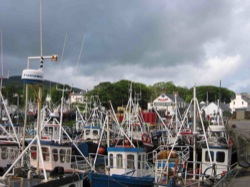

This month Marilyn Bright talks to Tricia Kealy, owner-chef of Kealy’s Seafood Bar, in Greencastle, Co Donegal, who is marking a quarter of a century in business this year
The sun was glinting off the harbour and trawlers unloading dripping boxes of fishy goodness as the Kealy family marked 25 years in business in May this year. Kealy's Seafood Bar has been an institution in this most northerly peninsula of Donegal, growing from a traditional family pub to an award winning restaurant attracting customers from both sides of the border and beyond.
Tricia Kealy and her late husband James had both trained as chefs in the Killybegs catering college and gone on to work in the Doyle Group hotels in Dublin when they decided to return to Donegal and re-open the old family pub that had been closed for several years.
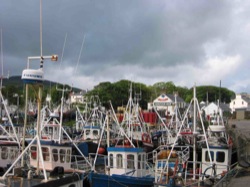
Tricia remembers that they started serving food at five tables set up in the bar, "And, with fish being landed just paces from our front door, it made sense to feature seafood. It's a huge advantage when you can look out of the window and see the fishing boats arriving back with your fresh ingredients."
News of the simple delicious food spread by word of mouth, attracting locals and summer visitors alike. Although business was seasonal, competition for the five tables could be fierce at weekends Tricia recalls, "Like a rugby scrum on Saturday nights, and in the summer we'd have to turn customers away". After four years, adjacent restaurant space was added to provide an extra 50 seats.
Kealy's legendary seafood chowder is far and away the most popular order, made with a mixture of white fish and salmon in vegetable enriched stock with a subtle flavour boost of pink peppercorns and a dash of Angostura bitters.
It sells winter and summer, on its own as a hearty lunch with homemade wheaten scones or a dinner time starter. Mussels were eliminated from the chowder a few years ago to cater for customers with shellfish allergies. "We’re seeing more people with allergies now,” Tricia observes. "In the past, you might have one coeliac a month, now we'd have someone with some sort of allergy nearly every night."
On the plus side, today's diners are more adventurous and willing to try something new. John Dory is now the most popular fish on Kealy's menu, but Tricia recalls that in James's day as a kid, it was used as bait.
Travel has given people a taste for new flavours too - salmon might come as a Japanese crumbed fishcake with ginger infused mayonnaise, simply grilled with lime and dill butter or given a Mediterranean spin with smoked pancetta and crushed cannellini beans.
Eating habits have changed too, with informal bar food and tapas largely replacing the traditional four or five course dinner and demand for all-day food blurring meal times. "With the recession, people want value for money, so we've had to be more inventive and think of ways to get customers through the door. We have themed nights and curry nights which work especially well in the winter when it's mostly locals."
The biggest boost to business has been the reinstatement of the Magilligan car ferry which brings customers from the North across Lough Foyle and lands them a few minutes walk from the restaurant door.
Running seasonally from St. Patrick's weekend to the end of September, it marks the beginning of the summer season and means that, at holiday time, 80 per cent of Kealy's customers are from the North. "Before the ferry, Greencastle was a cul-de sac with no passing trade," Tricia says. “ Now the Inishowen peninsula has opened up to visitors from all the North Antrim coast, and the past two summers have been our best ever.”
During the winter, Kealy's opens for weekends and holidays, with Tricia and one other in the kitchen where everything is produced in-house, from from ice creams and sorbets to relishes, toasted foccacias and their signature wheaten scones. In summer the brigade expands to four or five with sons Owen and Oisin returning from university studies and travel as far flung as Mexico. “They've become great little chefs," Tricia boasts, “and bring new ideas like the seafood tacos that have gone down very well."
Traditional classics never go out of favour, like the treat of freshly landed whole Dover sole on the bone, served with brown butter, parsley and capers. Grilled mackerel stars in the summer, along with mussels marinière and bountiful seafood platters made up from the day's catch.
“When the business was smaller, I used to walk across when the fish came in and choose the fish myself. Now I'm too busy but our suppliers in the Foyle Fishermens Co-op know what we want and look after us very well. Lobsters come from Malin Head a few miles away and we get big juicy oysters from Foyle Mor just 15 minutes away - most of theirs are exported to Japan.”
The first bank holiday of the year has seen business booming and Tricia feels it's going to be a good summer. “Even through thinner times, you have to be positive and not talk yourself down. We have good loyal customers who keep coining back and it's the locals who keep us going when the summer visitors have gone. We still have the original five tables beside the bar and that's where a lot of our regulars like to be. After 25 years, they're all friends."
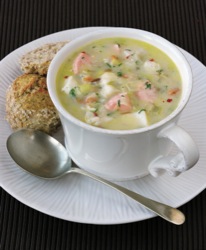 Kealy's Greencastle Chowder
Kealy's Greencastle Chowder
1.2 litres/2 pints fish stock
100g/4oz skinless salmon fillet, cubed
100g/4oz skinless haddock fillet, cubed
50g/2oz butter 1 onion, chopped
2 carrots, chopped
1 leek, chopped
3 celery sticks, chopped
1 tsp chopped fresh dill
1 tsp crushed pink peppercorns
50g/2oz plain flour salt and freshly ground black pepper
Angostura bitters
a little milk (optional)
pouring cream and chopped fresh parsley, to garnish
To Serve
freshly baked baby brown scones
SERVES 4-6
Bring the fish stock to a gentle simmer in a large pan and add the salmon and haddock. Cook for a couple of minutes until tender, then transfer to a plate with a slotted spoon. Set aside until needed.
Melt the butter in a separate large pan over a medium heat. Sweat the onion, carrots, leek and celery for about 10 minutes or until they are softened but not coloured. Add the dill and pink peppercorns and cook for a further 5 minutes.
Stir the flour into the vegetable mixture and cook for 5 minutes, stirring constantly. Gradually pour in the fish stock, stirring until smooth after each addition: add a dash of Angostura bitters, then bring to the boil and simmer for 15 minutes until all of the vegetables are completely tender and the liquid is slightly reduced. Season to taste.
Just before serving, a little milk can be added to thin out to desired consistency. Add the cooked salmon and haddock to the chowder and allow to warm through. Ladle into warmed bowls and garnish with a little cream and some parsley. Arrange on plates with some brown baby scones to serve.
The Seafood Interview supported by BIM - Cullinan's Seafood Restaurant & Guesthouse


This month Marilyn Bright talks to James Cullinan, owner-chef Cullinan’s Seafood Restaurant & Guesthouse, in Doolin, Co. Clare
When the surf's up in Doolin, it also means the tide is in at Cullinan's Restaurant serving up some of the Clare coast's finest and freshest seafood. Chef proprietor James Cullinan confirms that the global attraction of the mighty Atlantic rollers has brought an influx of visitors to the seaside village and a lively buzz that extends far beyond traditional high summer holiday times.
“We'll celebrate 20 years in business next year, “ James reflects, “And we’ve seen the interest in water sports balloon, bringing a lively mix of everything from backpackers to campers and family groups. The restaurant was built to include ten guestrooms and the village has developed a good standard of hostels and campsites so there’s something for everyone and the season is much longer - from about mid February to early December now.”
 Doolin's reputation for traditional music adds to the atmosphere in the evenings when surf boards and diving gear is stowed away. James is a noted musician, following in the fabled footsteps of “the fiddler of Doolin”, and a popular performer at the evening sessions and folk festivals the village is known for. “Playing music is similar to cooking,” James asserts, “You have to be passionate about it to be any good.”
Doolin's reputation for traditional music adds to the atmosphere in the evenings when surf boards and diving gear is stowed away. James is a noted musician, following in the fabled footsteps of “the fiddler of Doolin”, and a popular performer at the evening sessions and folk festivals the village is known for. “Playing music is similar to cooking,” James asserts, “You have to be passionate about it to be any good.”
Cullinan's Restaurant menu displays that passion with dishes that showcase finest local ingredients — Atlantic haddock with asparagus and smoked salmon chiffonade napped in pink grapefruit butter, or seared monkfish tail with basil mash and roast pepper and parsley salsa. “We do as much as possible in-house, James explains, “yeast breads like tomato and olive or red onion, brown soda bread and ice creams and sorbets.”
Fresh fish is mainly sourced through Garrihy Seafood Company half a mile away and James prefers to buy in whole fish which he fillets and portions in in-house. “You have more control that way and we use off-cuts to make our own stock and sauces - we don't buy in any convenience products.”
One exception is the fresh Miltown Malbay crab bought in ready-picked. “You'd need a separate area of the kitchen to process crab in the quantities we use. We get excellent quality local crab meat ready to use for dishes like the popular tian of crab layered with a cherry tomato compote, baby salad leaves and avocado crème fraiche.”
Cullinan’s Atlantic seafood chowder is legendary, made on a velouté base with their own fish stock and white aromatic vegetables. “The secret is good jellied fish stock which we make a couple of times a week. We cook to order in that the base is made up, with fresh seafood added last minute - no smoked fish as I think that can be too dominant, so we’d have prawns and a variety of white fish, kept a bit chunky and finished with a bit of cream, but not too much to mask flavours,"
Fresh and local is a theme that runs through James's menus -- salad leaves and herbs grown a few miles away in Bell Harbour, St Tola goats cheese from Inagh, Cratloe Hills sheeps’ cheese and Burren Smoked Salmon that travels just a few minutes from Birgitta Curtin's smokehouse to Cullinan's kitchen door.
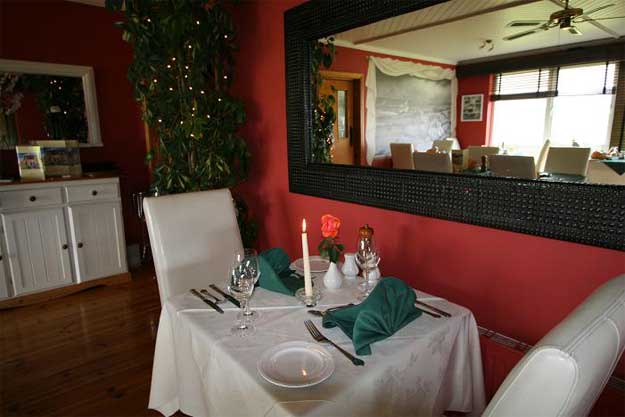 Much of James's appreciation of fresh produce stems from early training in the much missed Rockwell College with its own farm supplying food for the school and monastery. Everything was produced on site - eggs, vegetables and dairy - and CERT students had to deal with every stage of food preparation from the field or the barn to the plate. Putting out three meals a day was like living a hotel experience — tough but fun."
Much of James's appreciation of fresh produce stems from early training in the much missed Rockwell College with its own farm supplying food for the school and monastery. Everything was produced on site - eggs, vegetables and dairy - and CERT students had to deal with every stage of food preparation from the field or the barn to the plate. Putting out three meals a day was like living a hotel experience — tough but fun."
James' career later included several stints in Irish hotels and a year in the United States at Cape Cod dealing with nightly volumes of 250 diners. “It was high pressure, “ he recalls, “aand I was stunned by the huge portions and the size of the steaks."
James returned to his native Clare with his wife Carol and opened Cullinan's Restaurant and Guesthouse in 1994, quickly gaining a top reputation for excellent Irish food with the French influences that reflect his classical training. It's a sound training and passion that he has been happy to pass on, becoming involved in training new generations of chefs at the highly regarded Shannon College of Hotel Management.
In earlier years, the academic year dovetailed neatly with the restaurant’s seasonality, but now as Doolin's dramatic coast and reputation for traditional music attracts visitors nearly year round, James spends more time on his home ground, happy to use both culinary and fiddling skills that add to the lively scene in this corner of Clare.
The Seafood Interview supported by BIM - O'Grady's on the Pier
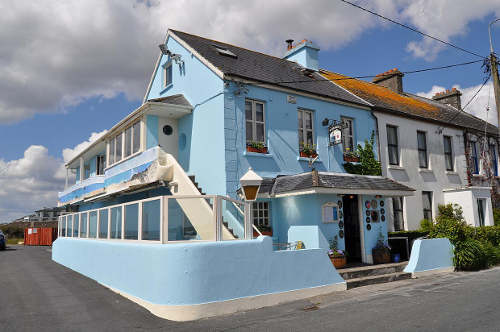

This month Marilyn Bright talks to Michael O’Grady, proprietor of O’Grady’s on the Pier, in Barna Co Galway and Kirwan’s Lane Restaurant & The Seafood Bar in Galway City
Nothing commends a seafood restaurant more than the sight of the proprietor carrying crates of dripping fresh fish from the harbour to his kitchen door. It's a regular occurrence for the sun-seeking crowds thronging the Barna seafront this summer, and restaurateurs don't get more hands-on than Michael O'Grady at the aptly named O'Grady's on the Pier.
Michael can be a difficult man to track down as he's likely to be on a boat scouting the shoals of mackerel that have the happy fate of ending up on diners' plates within hours of being landed. Galway Bay and the Connemara Coast are Michael's natural habitat and there's not much he doesn't know about the spanking fresh seafood that O'Grady's is famed for.
 Although the Barna restaurant was established in the old harbourside pub 13 years ago, Michael grew up in the O'Grady family restaurant in Clifden where he was involved in the business “from the time I was in short pants. Our place was one of the first in the west to specialise in seafood and I grew up knowing nothing else."
Although the Barna restaurant was established in the old harbourside pub 13 years ago, Michael grew up in the O'Grady family restaurant in Clifden where he was involved in the business “from the time I was in short pants. Our place was one of the first in the west to specialise in seafood and I grew up knowing nothing else."
Galway Catering College and hotel management were to follow, but Michael claims his real training was in the home business. After travelling a bit, he returned and ran the Clifden restaurant for a few years before establishing O'Grady's on the Pier in 2000. Ideally situated on the harbour, there are stunning views of the beach and mountains beyond and summer diners at outdoor tables can hear the lapping of waves around the boats that have landed much of the day’s menu.
Unusually - especially for a seafood restaurant - O'Grady's is open for lunch and dinner seven days a week, closing only for five days over Christmas. Although there are meat and vegetarian options, the eight to ten different fish that appear on the daily menu are the draw that attracts visitors and locals alike. In addition to health and fitness trends, people are just more aware of seafood now," Michael observes. "Fish is more available generally and you see more fish shops and good fish counters.”
He is also pleased that there is good uptake on the more unusual, like the razor clams that appear occasionally, steamed open with shallots and a splash of wine and served with a garlic and lemon butter. Gurnard is one of the best," Michael says, but warns that it must be pin-boned.
There is fresh squid linguini with samphire in garlic and oyster cream and a bolognese made with squid instead of meat and served with fennel.
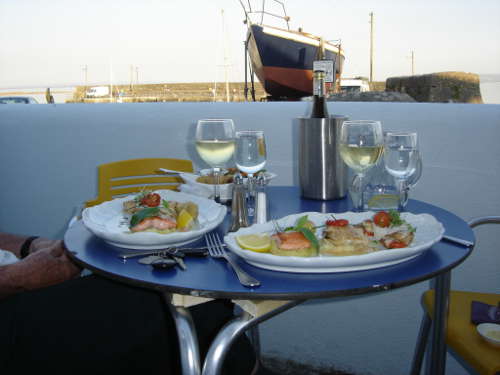 Megrim appear on the menu and, as they're difficult fish to fillet, most are sold on the bone, as are the lemon sole. "Many of our customers order their fish cooked on the bone, which is fine because we get in about 80 per cent of our fish on the bone to fillet and portion in-house. "We use the bones and trimmings for the tremendous amount of stock we get through every day.”
Megrim appear on the menu and, as they're difficult fish to fillet, most are sold on the bone, as are the lemon sole. "Many of our customers order their fish cooked on the bone, which is fine because we get in about 80 per cent of our fish on the bone to fillet and portion in-house. "We use the bones and trimmings for the tremendous amount of stock we get through every day.”
Much of that stock is required for the top-selling creamy seafood chowder still made to the O'Grady senior's original recipe. Stock also goes into elegant shellfish bisque either served up on its own or as an element of dishes like the ravioli of Dublin Bay prawns served with smoky bacon mousse, roast red pepper and wilted spinach napped with prawn bisque.
Michael has seen customers' tastes change from old restaurant standbys like turbot, brill and black sole, all seen much less these days. Cost, of course is an important element and he quotes recent prices like €25 per kg for John Dory and €31 per kg for wild salmon, of which there is very little these days. O'Grady's use the Clare Island organic farmed salmon which they find to be of excellent quality,
"We have superb shellfish practically on our doorstep,” Michael points out. "Lobsters come from about 100 yards away, prawns are from Rossaveal and we've been getting scallops from Carna - from the same supplier for 30 years. Killary mussels are popular, steamed with Guinness cream and a hint of garlic or served up escargot style with garlic butter.”
Plaice is “huge" now with customers Michael says, along with popular choices of fresh mackerel, hake, ray and pollock. “We get in black pollock and sand pollock, but I think the sand pollock is preferable. Spanking fresh, it's the best for great fish and chips. With all that indigenous fish available, I can't understand the current popularity of sea bass, which is nearly all farmed abroad and imported."
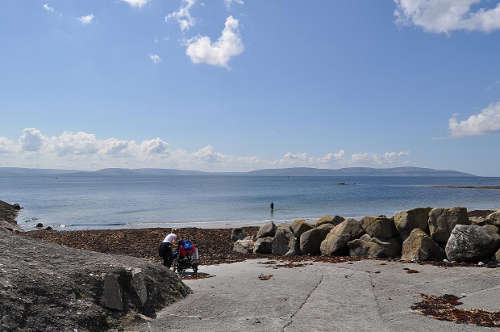 Galway Bay may be famed for the native oysters, but these are scarce now, and expensive. Pacific, or gigas oysters are the order of the day at O'Grady's, as with most other places. Michael notes that while oysters are generally thought of as autumn-winter eating, seasonal demand from their customers kicks off in March and continues through the summer, with most people preferring them “au naturel” with a bit of red wine vinegar and shallot.
Galway Bay may be famed for the native oysters, but these are scarce now, and expensive. Pacific, or gigas oysters are the order of the day at O'Grady's, as with most other places. Michael notes that while oysters are generally thought of as autumn-winter eating, seasonal demand from their customers kicks off in March and continues through the summer, with most people preferring them “au naturel” with a bit of red wine vinegar and shallot.
There are round clams too, and winkles found in abundance all around Galway Bay. Tuna is an occasional summer visitor to the west coast and Michael has found this appeals mostly to foreign visitors. When it comes to Irish tastes it’s hard to beat the perennial appeal of a fat, juicy Dublin Bay prawn cocktail with lashings of O'Grady's brandy scented Marie Rose sauce.
The Seafood Interview supported by BIM - The Lobster Pot, Dublin 4
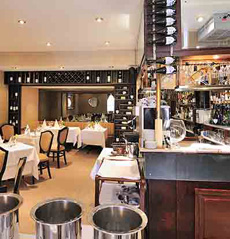
 This month Marilyn Bright talks to Gary Crean, proprietor of one of Dublin’s oldest and most famous restaurants, The Lobster Pot, in Ballsbridge.
This month Marilyn Bright talks to Gary Crean, proprietor of one of Dublin’s oldest and most famous restaurants, The Lobster Pot, in Ballsbridge.
Proust may have longed for lost tea and madeleines, but at Dublin's Lobster Pot Restaurant, seafood lovers can still indulge in tastes that were golden classics long before foams, leek ash and snail porridge were the merest glimmer.
Fresh Dublin Bay prawn cocktail with Marie Rose sauce, coquilles St. Jacques and goujons of sole were on the menu thirty-three years ago when Tommy Crean opened the first floor restaurant in a red brick terrace beside the Dodder in Ballsbridge and they've been firm favourites ever since.
 One of Dublin's oldest family owned restaurants, The Lobster Pot is run today by son Gary, who has retained the well-loved dishes of the menu as well as the elegance of old-style silver service. There's no doubting the house specialty as a tray laden with the seafood selection of the day is presented at the table for diners to choose, allowing for indulgences like sole with a few prawns or scallops on the side. A flexible and skilled kitchen means that the fresh seafood can be prepared to the customer's fancy, perhaps with hollandaise or Mornay sauce, or simply turned in butter.
One of Dublin's oldest family owned restaurants, The Lobster Pot is run today by son Gary, who has retained the well-loved dishes of the menu as well as the elegance of old-style silver service. There's no doubting the house specialty as a tray laden with the seafood selection of the day is presented at the table for diners to choose, allowing for indulgences like sole with a few prawns or scallops on the side. A flexible and skilled kitchen means that the fresh seafood can be prepared to the customer's fancy, perhaps with hollandaise or Mornay sauce, or simply turned in butter.
Gary was just nine years old when his father took over the premises, formerly The Runaway Horse, and recalls that the previous owners only completed the sale after that year's Horse Show in the RDS had finished. And Horse Show week is still one of the restaurant's busiest times, with the normal evening openings extending to lunchtimes, as they do on Rugby International weekends and at Christmas time 'which can be booked out a year in advance'.
Head chef Don McGuinness has been at the helm since opening day, but over the past two years he's been gradually handing over to chef David Beattie who is carrying on the tradition of classically based cooking using freshest ingredients. “Over the years we've seen things go in and out of fashion,” Gary says, “but we've always stuck to our guns, doing what we do well and ignoring nouvelle. Fresh ingredients should speak for themselves and cooking should enhance without over complication.”
Provenance is high on the agenda at The Lobster Pot, and seafood comes from three main suppliers and several small specialists. Prawns and scallops are mostly from Kilmore Quay, oysters from Carlingford and crab from Dunany in County Louth.
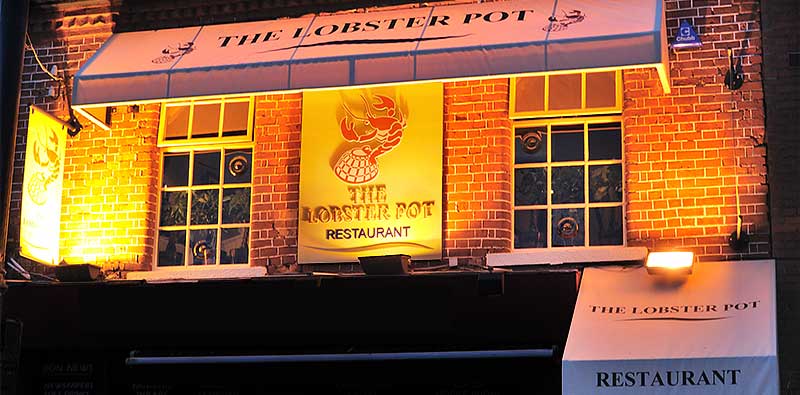 Gary goes to Kinsealy vegetable market daily for freshest supplies - “picking it yourself is the only way". Potatoes come from Willie Snow in North County Dublin, and the newer Casablanca variety has largely replaced Roosters on the menu, although reliable Pipers and Queens appear in their season. Gary has a maxim when it comes to the nation's favourite vegetable: “Never be afraid to order chips in a restaurant; then you'll know what kind of chef is in the kitchen.”
Gary goes to Kinsealy vegetable market daily for freshest supplies - “picking it yourself is the only way". Potatoes come from Willie Snow in North County Dublin, and the newer Casablanca variety has largely replaced Roosters on the menu, although reliable Pipers and Queens appear in their season. Gary has a maxim when it comes to the nation's favourite vegetable: “Never be afraid to order chips in a restaurant; then you'll know what kind of chef is in the kitchen.”
Although The Lobster Pot has built a solid following of regulars and corporate business over the years, they've not been immune to the economic downturn. “We'd been contemplating a refurbishment of the restaurant in 2008, just when things were starting to slow down but we decided to go ahead. It was difficult at the time, but I'm glad we did it and we're set up now for a good few years.”
The average spend is down and customers look for value, Gary has observed, but an early bird menu has proved popular. Traditional silver service has been a distinguishing mainstay, instituted originally by the now retired restaurant manager and sommelier John Rigby, schooled from an early age in the impeccable ways of the old Royal Hibernian Hotel. In-house training has ensured that all staff are well briefed about the fish on offer and happy to suggest varying menu options.
Nearly lost performance arts are well honed too, with skilful de-boning of whole sole at the table and trolleys roll out bearing ingredients for steak tartare or a flaming finale of crepes Suzette.
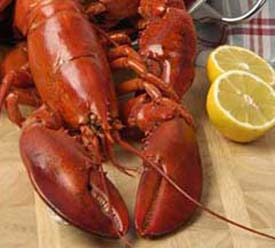 Lobster Pot customers tend to favour prime seafood like black sole, halibut, cod and the hard to get turbot while occasional offerings of variety fish like gurnard have less appeal. Fat prawns from Kilmore Quay are always best sellers, with the restaurant getting through four to five kilos daily.
Lobster Pot customers tend to favour prime seafood like black sole, halibut, cod and the hard to get turbot while occasional offerings of variety fish like gurnard have less appeal. Fat prawns from Kilmore Quay are always best sellers, with the restaurant getting through four to five kilos daily.
Recent additions of salmon and smoked cod fish cakes with dill mayonnaise have proved popular as have feathery battered tempura prawns. Gentle tweaks to the menu are carefully gauged, as Gary acknowledges “we'd get a backlash from customer if we tried to remove the favourites.”
So seafood lovers can be assured that there'll always be a place for pan-seared ray wings with brown butter and capers, lobster Thermidor and classic prawn cocktail with cognac scented Marie Rose sauce.
The Seafood Interview supported by BIM - Eithna's by the Sea, Co Sligo


This month Marilyn Bright talks to Eithna O’Sullivan, proprietor-chef of Eithna’s by the Sea, Mullaghmore, Co Sligo. our Seafood Restaurant of the Year 2014, sponsored by BIM
If unspoilt seashore and views of the mountains beyond Donegal Bay weren't enough, the happiness quotient around Mullaghmore harbour shot up even more this summer with the re-opening of Eithna's by the Sea.
This harbourside mecca for seafood lovers had closed eight years earlier when proprietor Eithna O'Sullivan took a sabbatical, and leased the property out while she furthered her interest in all things oceanic.
 But now, with a fresh coat of bright blue paint, this seaside favourite has once again become a hub for happy diners with daily changing menus of everything fresh from the sea - from mackerel and hake to squid, clams, mussels and the local lobster - that features in Eithna’s most popular signature dishes. Seaweed and sea vegetables are used to enhance dishes - not surprisingly perhaps, as Eithna’s break from the restaurant was used partly to complete an honours degree in Culinary Arts, with a thesis on Seaweed as an Artisan Food Product.
But now, with a fresh coat of bright blue paint, this seaside favourite has once again become a hub for happy diners with daily changing menus of everything fresh from the sea - from mackerel and hake to squid, clams, mussels and the local lobster - that features in Eithna’s most popular signature dishes. Seaweed and sea vegetables are used to enhance dishes - not surprisingly perhaps, as Eithna’s break from the restaurant was used partly to complete an honours degree in Culinary Arts, with a thesis on Seaweed as an Artisan Food Product.
Organic salmon and hake fillets may come with a crust of aduka, seaweed, pumpkin and sesame seeds while fresh char-grilled mackerel is sparked with beetroot pickle and seaweed relish. Hake is wrapped in mild flavoured wakame and served with lime sauce, and a versatile homemade seaweed pesto may enhance an open sandwich of mixed seafood on homemade brown bread. Combined with organically grown seasonal herbs, the seaweed pesto is sold in jars as a popular restaurant take-away.
Eithna started working in hotels at the age of 14 and went on to train in hotel management in Galway, with work experience in Germany and Ashford Castle. She recalls being attracted to the local seafood offered at the time by Paddy Burkes of Clarinbridge and Austie’s at Rosses Point (a pub that’s since changed hands many times since); they were ahead of their time, offering simply served seafood chowder, garlic mussels and open sandwiches of crab, prawns or salmon.
Focusing on food, Eithna completed a course at Alix Gardner's Cookery School in Dublin and went on to secure a place in the cutting- edge kitchens of White's on the Green, a restaurant that was setting the pace for fine dining in the 1980's. Ready to strike out on her own, Eithna recalls hearing that a property in Mullaghmore had become available and a return to the west was decided on.
Months of hands-on refurbishment followed, with new wiring and plumbing, fresh paint and canny recycling. “We went for the stripped pine look which was popular then,” Eithna says, “and we have it still."
From the opening in June 1990, emphasis was on offering flavourful seasonal food that made the most of local produce, working with the area's farmers, growers and fishermen. The ethos is the same today, with longstanding suppliers like The Tattie Hoaker organic farm currently delivering autumnal kale, beetroot, salad leaves and herbs, while cottage flowers from The Secret Gardens of Sligo bloom in recycled painted tins dotted about the tables.
Happily located beside one of the west coast's main centres for lobsters Fisheries Exports, Eithna's daily supplies come through Mullaghmore Sea Farm and local landings. With lobsters “on my doorstep” it's no surprise that the restaurant has become known for specialities featuring the majestic crustacean.
Summertime is the peak season for lobster and price fluctuates according to availability, ranging this year from around €17 kg to a low of €12.50 kg, due to the softening of the export market. Top prices are to be expected at Christmas time, with live lobsters caught earlier in the season and held in the sea farm.
“Lobster Thermidor is the most popular,” Eithna says, “with good uptake also for lobster Americaine which I do with Mexican spices and spaghetti. I also do my own take on Rick Stein's Goan lobster curry with tomatoes, shallots and freshly ground spices. I'm an admirer of his seafood recipes and I also like Hugh Fearnley-Whittingstall's books for ideas.”
With her specialist degree work, and research and development projects with seaweed expert Pranny Rhatigan, it is no wonder that seaweeds and sea vegetables feature throughout the restaurant menus. The neglected, old favourite dillisk, or dulse, with its distinctive flavour is roasted in the oven for crisps, flaked into salads, mixed into homemade mayonnaise for the seafood platter or whizzed into sauces and Eithna’s unique seaweed pesto.
Hijiki, like fine strands of black pasta, is highly prized in Japan but rarely used here. Eithna uses it in a dish of land and sea spaghetti with lobster, clams and mussels dressed with roast lobster stock, herbs and rapeseed oil. It's tasty sweetish flavours are brought to the fore mixed with berries in a dessert served with chocolate and nori (laver) meringues.
Carrigeen moss is an old favourite revived iIn Eithna's pudding, flavoured with lemon and lemon balm, served in a shot glass with seasonal fruits like autumn blackberries and apple,.
Seaweeds are seasonal, Eithna points out, like the other produce used in the restaurant, and the mineral content varies too. Despite her expertise and seaside location, she doesn't gather seaweed herself, but buys it from local harvesters who must have foreshore licensing. “It’s necessary to source seaweed that has been tested and correctly dried - which may include ultra-violet treatment, “ Eithna says.
A seaweed tasting plate is being developed for next season, joining a menu that celebrates all that is good from the sea, and ensuring that this family business with its ocean blue frontage continues to shine on the shores of Donegal Bay.
The Seafood Interview supported by BIM - Oscar's Seafood Bistro, Galway
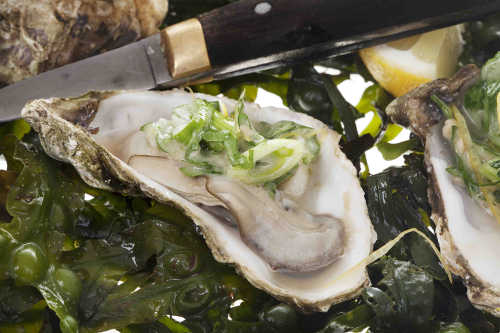

This month Marilyn Bright talks to Michael O'Meara, chef-proprietor of Oscar's Seafood Bistro, Galway
Michael O'Meara is a chef who literally immerses himself in his work and in the process has been named BIM’s Seafood Chef of the Year. Swapping chef's whites for a wet suit, Michael explores Galway Bay's rich sea life and gathers research for a book featuring the award winning fish and sea vegetable dishes he serves up in Oscar's Seafood Bistro.
Anything from six to 10 species of fish feature daily on the small blackboard menus on each table, offering unusual choices ranging from forkbeard, rockling or megrim to the more familiar cod and hake. Michael is a vocal campaigner for the less usual fish that are often discarded and laments the amount of prime fish being exported. "I estimate that only about 10% of fish landed here reaches Irish tables," he claims.
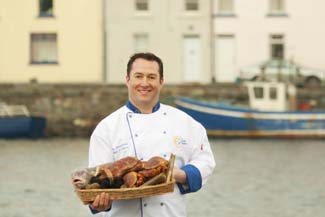 When it comes to cooking, "old fashioned classical training” in Galway tech is how Michael describes his roots, built on later with work in Dromoland Castle and the Mediterranean south of France. Returning to Ireland to run a popular bar and restaurant in Westport, Michael determined to open a place of his own, looking for a city location with year round rather than seasonal trade.
When it comes to cooking, "old fashioned classical training” in Galway tech is how Michael describes his roots, built on later with work in Dromoland Castle and the Mediterranean south of France. Returning to Ireland to run a popular bar and restaurant in Westport, Michael determined to open a place of his own, looking for a city location with year round rather than seasonal trade.
"People laughed at me," he recalls, when he opened Oscar's in quiet Dominick Street in 2000, just off Galway's bustling main beat, correctly gambling that this would be an up and corning area. "The first Saturday night we did three covers, but that built little by little and by the end of the year we were full at weekends. We just made sure we didn't lose any customers once we'd got them through the door."
Seafood speciality was something that evolved as Michael appreciated the superb local produce that Galway provides. "Buying local is just a better way of doing things. It's nothing new but people are more aware now because of work by people like Myrtle Allen and the late Gerry Galvin."
Menus are kept flexible because they're dependent on what is available on the day. A reliable supply chain is vital to Oscar's and Michael uses Stephane Griesbach's highly regarded Gannet Fishmongers who source much of their fish from the Galway and Aran Fisherman's Co-op in Rossaveal.
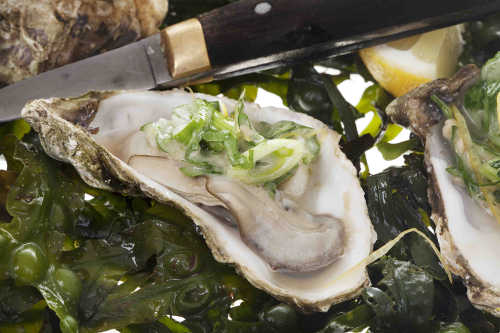 Less usual fish like the three-bearded rockling may be paired in a dish with a more familiar fish like John Dory but in general Michael finds that customers like to try different things. “Although a lot of seafood menus seem obsessed with monkfish and scallops, we find that everything sells well here, with no particular favourites."
Less usual fish like the three-bearded rockling may be paired in a dish with a more familiar fish like John Dory but in general Michael finds that customers like to try different things. “Although a lot of seafood menus seem obsessed with monkfish and scallops, we find that everything sells well here, with no particular favourites."
With fish bought in every day, a lot of kitchen time goes into preparation and getting the basics right. "Michael favours just scaling most fish and leaving skin on for cooking. Bones, especially from flat fish like turbot, go into the vast quantities of rich stock used in the sauces that are made to order during service. Stock is made in large batches, enriched with vegetables and wine and blast frozen in 500ml containers for use as needed.
Bouillabaisse is a house speciality, made with crab and turbot stock and a variety of fish, given sunny south of France flavourings of saffron, tomato and Ricard. Other dishes show Asian influences with fish gently cooked in bamboo steamers lined with seaweed or banana leaves.
Michael considers the Japanese masters of fish cookery and often uses seasonings such as sweet mirin rice wine, sake and soy. For spicy dishes he prefers wasabi and horseradish, finding it complements seafood better than chilli. Any variety of fish may turn up in Michael's version of perennial favourite fish and chips, but he uses gram flour made from dried chickpeas to make a spicy batter - "it crisps well and doesn't hold oil like wheat flour."
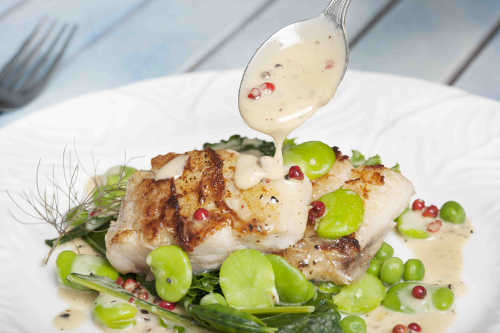 Wild Atlantic seaweeds are another of Michael's passions and they turn up in flavourful butters to finish off grilled fish or sauces such as a colourful beurre blanc flecked with purpley-red seaweed and bright green parsley to go with potted crab. Dillisk goes into the yeast bread baked daily and hard-to-get large leaves of sea lettuce may be used to wrap fish and impart a savoury flavouring.
Wild Atlantic seaweeds are another of Michael's passions and they turn up in flavourful butters to finish off grilled fish or sauces such as a colourful beurre blanc flecked with purpley-red seaweed and bright green parsley to go with potted crab. Dillisk goes into the yeast bread baked daily and hard-to-get large leaves of sea lettuce may be used to wrap fish and impart a savoury flavouring.
As a flavour enhancer, fresh (or fresh frozen ) seaweed is better than dried, Michael says, and his supplies are collected professionally on the Aran Islands. "You have to be aware of restrictions like foreshore licensing," he points out. "I do sometimes cut a bit under water when I'm diving, which is allowed if you do it without assisted breathing*"
The waters of Galway Bay are also providing material for Michael’s magnum opus - a book that aims to combine his cookery and photography skills with aquatic knowledge.
“I want to include all fish found in Irish waters, with two or three recipes for each. The photos need to be good and taken on the spot so that it can be a reference book as well. With fish being seasonal, this is a long term project, so I expect it will keep me busy for some time."
The Seafood Interview supported by BIM - George Stephens
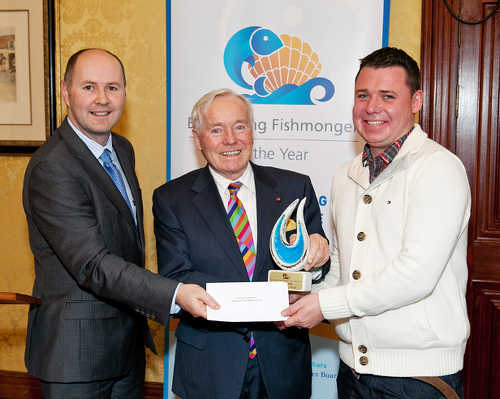

We begin the new year with a brand new series in which we find out what makes the best of our young fishmongers stand out from the crowd. This month, Marilyn Bright talks to George Stephens of The Fish Market in Mullingar, Co Westmeath, and discovers a number of very good reasons for his success.
Smart phones flashing in The Fish Market in downtown Mullingar aren’t lighting up for selfies. Switched on customers are recording fish recipes printed on the walls as they decide what seafood treats they'll take home from fishmonger George Stephens's attractive display counters.
George, one of the five finalists in BIM’s recent Young Fishmonger of the Year competition, reckons that only one in ten people eat fresh fish on a regular basis and he aims to change that by showing that seafood is delicious, nutritious and easy to cook too. “The market for fish is growing significantly as people see fish being featured by television chefs and in the media, “ George observes, "and they're realising what fantastic produce we have on our shores - sometimes appreciated more in other countries than here at home."
As a chef for ten years before opening the shop in 2008, George had a particular interest in fish, working in the famed Red Bank Restaurant with Terry McCoy, who passed on his enthusiasm for seafood from the seldom seen razor clams gently poached with garlic and parsley to the luxurious heights of lobster and turbot.
Later with Derry Clarke at L'Ecrivain, "I learned a huge amount - we did all the filleting, boning and shelling there. Stocks and sauces were made with bones and trimmings. Off-cuts from portioning prime fish went into delicious fish cakes, bisques and chowders. Nothing was wasted - even lobster and langoustine shells were roasted with herbs and pounded to make flavoured oils for seasoning.”
 Passing on this cookery know-how is an important cornerstone of the original Fish Market in Mullingar and a second shop opened now in Maynooth. In addition to the recipes on the walls and in countertop leaflets, two of the six employees are chefs. Training staff is important in giving the best customer service, George asserts "' All our staff have different assets, and if they have a food background they're already 70% there."
Passing on this cookery know-how is an important cornerstone of the original Fish Market in Mullingar and a second shop opened now in Maynooth. In addition to the recipes on the walls and in countertop leaflets, two of the six employees are chefs. Training staff is important in giving the best customer service, George asserts "' All our staff have different assets, and if they have a food background they're already 70% there."
There was no fishmonger in his hometown of Mullingar when George opened five years ago. He spent six months researching and making contacts, getting great assistance from Martin McLoughlin of Nicky's Plaice on Howth pier and TV chef and fish expert Martin Shanahan who mentored him as he set up the new business. The Fish Market opened in September 2008, “A scary time," George recalls, "just before the bank guarantee.”
Fortunately, local response to the shop was instantly very good, with customers welcoming an alternative to supermarket fish. “Customers want information, from what fish to choose to simple cooking instructions and recipe ideas. All our counter staff are able to interact with customers and once they've tried something successfully at home, they'll be back, and we'll encourage them to try something else."
The spanking fresh display that lures passersby in comes by dint of George’s 5 a.m. trips to the fish market on Tuesdays, Thursdays and Fridays. He keeps the selection as varied as possible and counter staff are up to speed with information and serving suggestions, especially when it comes to less familiar seafood. George has found that people are willing to try something different if they're given confidence with simple cooking guidance. “We try to make it as easy as possible - everything is pin-boned and ready for the pan, filleted and portioned as the customer likes it."
Even easier options are the convenience products prepared freshly by the chefs in each of the premises - ready-to-heat chowder, seafood pies and fish cakes. Fish stock comes chilled or frozen in 500ml containers and a selection of sauces ranges from roast tomato and fresh herbs, coriander and lime or teriyaki to wholegrain mustard, honey and lemon. Any of the sauces can be selected to be sealed in a cook-in bag with the customer's choice of fish, ready for oven or microwave.
Gluten-free options are included in the prepared dishes and recipe development is ongoing, with recipes ready to be e-mailed to customers looking for inspiration. People are eating a greater variety of fish now and George credits recent initiatives such as the Bord Bia supported promotion of hake. “In the past a lot of Irish-caught hake was exported, but you wouldn't have seen much on the home market. Recipe leaflets and advertising turned that around and now hake is flying off the counters.”
George sees the BIM Young Fishmonger of the Year competition as a great boost to Ireland's seafood industry and its potential in terms of business and career opportunities. With two shops trading successfully, George isn’t sitting on his laurels as plans for shop number three are well on the way - to be announced soon.
The Seafood Interview supported by BIM - Graham Rogerson
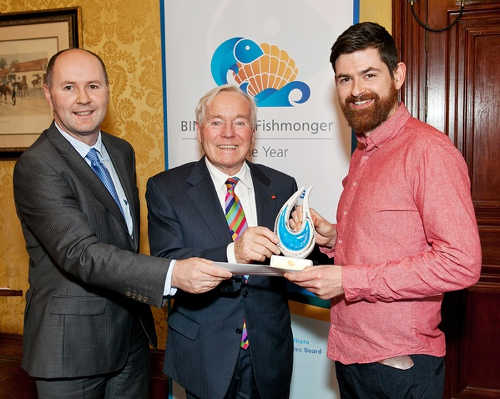

What makes the best of our young fishmongers stand out from the crowd? Marilyn Bright talks to Graham Rogerson of Georges Fish Shop, at Monkstown Farm, Dun Laoghaire, and finds that fishmongering and a strong work ethic are in his genes
With grandparents who sold fish from Dun Laoghaire pier and guided ships safely into harbour, it’s not surprising that Graham Rogerson would pack in a job in banking and return to family tradition.
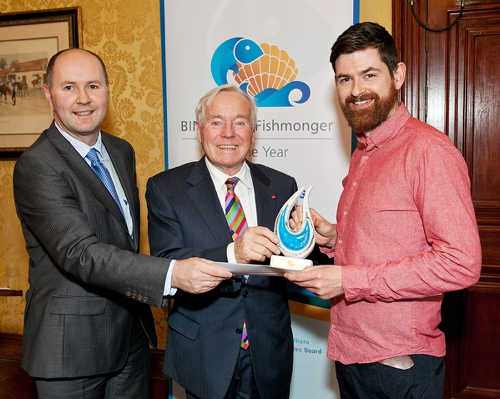 Re-opening the family fish shop four years ago in South County Dublin with his sister Lisa has been a happy transition, with Graham named as a finalist this year in Bord lascaigh Mhara's Young Fishmonger of the Year competition.
Re-opening the family fish shop four years ago in South County Dublin with his sister Lisa has been a happy transition, with Graham named as a finalist this year in Bord lascaigh Mhara's Young Fishmonger of the Year competition.
Graham's grandfather Jimmy had fished the Irish sea in a trawler from Fleetwood and ended up marrying into a Dun Laoghaire fishmongering family. With few jobs available in the 1930’s, he bought an open rowing boat and became a “hobbler”, competing with other small boats for jobs guiding ships into harbour. It was a Dublin profession that disappeared when pilot boats became the norm.
George, Graham's father and founder of the business, was sent to Fleetwood at an early age to learn trawlering, returned to Dun Laoghaire to sell fish from the pier, work for Irish Lights and eventually opened the family shop in Monkstown in 1980.
Along with the retail business, they began to fillet and supply fish to restaurants. After more than two decades, the Rogersons closed the shop to concentrate on the growing wholesale trade.
“My sister and I re-opened four years ago” Graham relates, “keeping the name George's Fish Shop that has been over the door since my parents opened over thirty years ago. In the beginning I worked both jobs — in the bank with computers during the night, and days in the shop, I think I got about two hours sleep a night for the first two years.”
Business was slow for the first few months, Graham remembers, but built up steadily as their reputation grew. He is now assisted by one full-time and two part-time staff, with sister Lisa helping at weekends.
Since the beginning of this year, George's Fish Shop has been opening on Mondays too, as they've found that fish has well and truly shed the Fridays-only image to become an everyday experience. There are also plans to open a second shop soon in Monkstown village to cater for demand.
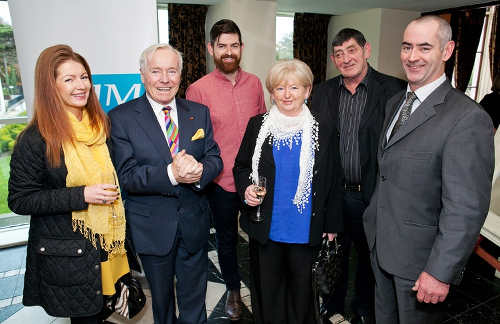 “People are buying and cooking more fish now - they're health conscious and also having good experiences eating seafood in restaurants,” Graham observes, “Television food programmes have had an influence too, so customers are more knowledgeable and willing to go beyond the usual cod or salmon.
“People are buying and cooking more fish now - they're health conscious and also having good experiences eating seafood in restaurants,” Graham observes, “Television food programmes have had an influence too, so customers are more knowledgeable and willing to go beyond the usual cod or salmon.
They’re still a bit unsure about cooking though, so it's part of our job to make suggestions and reassure customers that fish is quick and easy to cook with just a little seasoning.”
Graham has found that people can be wary about bones so fish is pin-boned and presented as ready-to-cook fillets. Life is made even easier with the shop's range of marinades and sauces made with fresh ingredients - herby pomidoro or red pepper and onion sauces are popular, sealed in oven bags for instant meals, or fillets can be given a coriander, thyme and parsley crust in a tray ready for sliding into the oven.
The Rogersons work with a chef to develop their own ready-to-heat dishes that are increasingly in demand. Creamy fish chowder includes a rich mix of mussels, squid and prawns, while elegant prawn bisque is made with stock from the prawn heads which Graham thinks has a better flavour than lobster.
Top selling fish cakes are potato based with a mix of cod, haddock, salmon and smoked fish with a sweet chilli kick and breadcrumb finish.
Next most popular is the signature fish pie, oven- ready in a two portion container with potato topping over a mix of fish in creamy Dijon mustard sauce. Prawn lasagne is in the experimental stage and Graham says that ideas for new products come from meals out in restaurants and feedback from customers.
With more people cooking dishes like seafood risotto and paella at home, there is a steady demand for the half-litre tubs of frozen fish stock made every week.
More surprising to Graham has been the surge in popularity of homemade sushi among his Irish customers. “They'll mostly ask for salmon to use in sushi, while our Japanese and Filipino customers take as much swordfish or tuna as we can get.”
Fresh fish comes from Kilmore Quay three or four times a week and Graham is keen to promote lesser used sustainable species like witches, dabs and megrims. “Customers can be a bit wary if you offer something cheaper than the prime fish they're more familiar with, so you have to make a bit of effort. For anything unusual we reference good cookbooks and print up our own recipe cards. Spanish, Portuguese and French customers go for anything different, but our most unusual request came from Polish weight lifters looking for blue shark which they eat raw. It's nice soft meat and we recommend freezing it before eating."
Graham's own taste is a lot simpler. Pan-fried brill with fried potatoes is cited as a favourite, or hake cooked with onions, chorizo, tomatoes and black pepper for a quick in-the-pan sauce. In any case, it's clear that taking work home these days is a lot more enjoyable than sitting in front of a computer screen.
The Seafood Interview supported by BIM - John Feeney
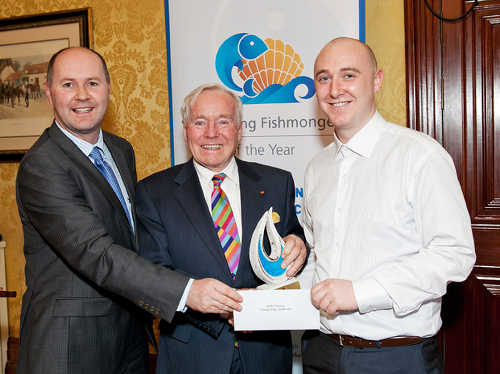

What makes the best of our young fishmongers stand out from the crowd? Marilyn Bright talks to John Feeney of Galway Bay Seafoods at Salthill, Galway and finds that this newcomer to fishmongering has an infectious enthusiasm for fish
In Salthill, above the churning seas of Galway's Atlantic coast, John Feeney presides over the newly opened branch of Galway Bay Seafoods with a sparkling display of fish so fresh it might have leapt straight from the wave onto the fishmonger's slab.
 John, one of five finalists in BIM's Young Fishmonger of the Year competition, confesses it's been a steep learning curve since he changed careers just three years ago. “Coming from carpentry and construction, I started on the fisheries plant floor down on the New Docks, packing fish for the restaurant and supermarket trade.
John, one of five finalists in BIM's Young Fishmonger of the Year competition, confesses it's been a steep learning curve since he changed careers just three years ago. “Coming from carpentry and construction, I started on the fisheries plant floor down on the New Docks, packing fish for the restaurant and supermarket trade.
First off, I had to learn how to recognise all the different kinds of fish, and learn to judge freshness by the condition of eyes, scales and gills. It was exciting learning something new and it sure beat working on a freezing rooftop site in winter.”
John progressed to Galway Bay Seafood’s state of the art processing and smoking facility where he learned the skills of brining and smoking that produce the company's award winning smoked mackerel, salmon and newly introduced kippers.
Filleting was John's most recently acquired skill and he admits to taking this up just a few weeks before the Young Fishmongers' competition. “The lads on the Galway Bay team have been working with fish for years and I learned working alongside them - how to scale and skin, pinbone and trim.”
The move into the retail shop on New Docks Road initiated John into another aspect of the seafood business, where interfacing with customers required calling on the knowledge he’d gained behind the scenes. Employer John Holland, who owns Galway Bay Seafoods with his brother Noel, confirms that the enthusiastic young apprentice got on well with both customers and others on the team. “We employ about 26 people,” John says. “All training is in-house and on-going so every aspect of the business is covered, but not everyone is suited to working behind the counter.”
 John Feeney was working in the retail shop when the manager gave him the BIM competition entry form. “I thought I might as well have a go and I'm glad I did because I really enjoyed it. There were four stages to go through - the judges ask questions and watch you in action in the shop. For the practical, all the finalists were given a box of 30 different fish to clean, fillet and display in half-an-hour. I won a cracking set of professional knives I expect to have for the rest of my life and I love showing them off.”
John Feeney was working in the retail shop when the manager gave him the BIM competition entry form. “I thought I might as well have a go and I'm glad I did because I really enjoyed it. There were four stages to go through - the judges ask questions and watch you in action in the shop. For the practical, all the finalists were given a box of 30 different fish to clean, fillet and display in half-an-hour. I won a cracking set of professional knives I expect to have for the rest of my life and I love showing them off.”
The Holland brothers have continued to develop and modernise the Galway Bay Seafood business founded by their father over sixty years ago. A cookery school was established in 2006, attracting customers with sessions on all aspects of seafood preparation, keeping up with current trends like homemade sushi, eastern seafood curries and use of spices and herbs, while the programme is rounded out with a series of wine tastings.
John Feeney confesses that Wednesday has become a favourite day, as staff meet up every week for a cookery session with the chef. “It's not just a demo - we actually do the chopping and cooking for a new dish every week. The chef sets homework too; last week we had to go home and make a meal with whatever was in the cupboard. I made a stir-fry with bits of fish and veg that were in the fridge and it was so good I made it twice.”
The house chef also develops the range of value-added products that feature in both retail shops. Dishes like stuffed sole, fish cakes, salmon lattice pasties with cream cheese, pepper and spinach filling are tasted and discussed at the weekly meetings and feedback from customers is exchanged. “You have to pass on what you've learned to the customers,” John says. “ The most often asked questions are ‘does it have bones?’ and and ‘how do you cook it?’ ”
John's own enthusiasm for fish is contagious and he lists seafood risotto as a favourite, with cod or hake turned in butter and stirred through. Mackerel or herring is his breakfast choice and he’d choose simply cooked plaice or lemon sole for lunch.
The variety of fish available has been a bit less during the winter storms, but John says that supplies from the bigger boats have been reasonably regular, with fish netted on the Monday on the counter for sale on Wednesday,
John is clearly happy that he's found his niche in fishmongering and insists that he is learning more every day. “It's exciting because you never know everything and you have to try to give the experience back to your customers.”
The Seafood Interview supported by BIM - Arnaud Lepricey
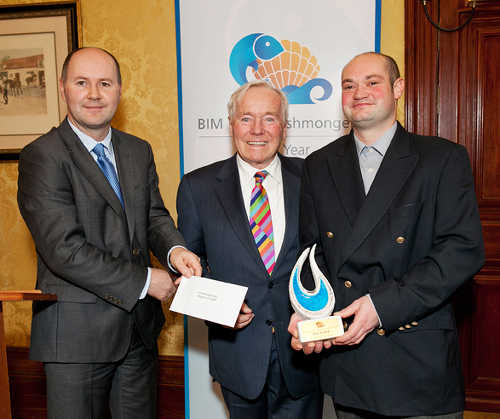

What makes the best of our young fishmongers stand out from the crowd? Marilyn Bright talks to Arnaud Lepricey at Wrights of Howth, and finds that - while he may have arrived in this Howth fish shop by a roundabout route - fishmongering is truly the expert niche for him.
Arnaud Lepricey's story that as a teenager he dreamed he was a fishmonger is nearly believable. Sceptics might think that prospects of a weekend job in the local fish market was also a canny way of financing a driving licence and car. In any case the youthful Arnaud fell into a niche that he enjoyed and became expert in, ending up ten years later as a finalist in BIM’s inaugural Young Fishmonger of the Year competition in 2013.
 Growing up in Normandy near the infamous Omaha Beach, Arnaud was surrounded by the good food culture of the area that boasted classic cheeses like Livarot and Pont-l’Eveque, rich Isigny butter and plump corn-fed poultry that is prized in the top restaurants of Paris.
Growing up in Normandy near the infamous Omaha Beach, Arnaud was surrounded by the good food culture of the area that boasted classic cheeses like Livarot and Pont-l’Eveque, rich Isigny butter and plump corn-fed poultry that is prized in the top restaurants of Paris.
In the Market that was the hub for local food, the fish stall was central and an ideal spot for on-the-job learning about the daily catch and how to prepare it for knowledgeable customers.
At the same time, the very practical Maman Lepricey insisted that Arnaud study for an accounting degree, a process which was to take seven years, financed by weekend and summer holiday work in the market and on supermarket fish counters.
Travel followed completion of final exams and Arnaud spent time in Dublin, doing stints at various jobs including waiting tables in a bistro, where he claims to have been “the worst ever waiter”’.
His kind employers - two Swedish ladies -- suggested it might be better to turn to his fishmongering skills and directed him to Howth pier with CV in hand. Today he is cheerfully ensconced behind the impressive counter of Wrights in Howth, where he says he most enjoys meeting customers and creating colourful displays of the vast array of seafood that is sold from the pier seven days a week.
“It's a hard job, and cold,” Arnaud concedes. “So you have to love what you're doing. I like dealing with customers face-to-face and it's interesting to see how tastes have widened in the past few years.
People used to ask just for cod or salmon or maybe a bit of mackerel in the summer, mostly on a Friday. Now they're looking for variety and eating fish through the week. I think that restaurants have done a lot to create demand.”
Arnaud also credits our new rainbow society with broadening gastronomic horizons. Chinese cooks looked for monkfish and grey mullet, the Spanish prize hake and Mediterranean tastes run to tuna, clams and all sorts of shellfish. The pier takes on an international flavour especially at weekends, when whole families come out to shop and enjoy seafood within sight of working trawlers.
With Howth pier coming into its own as a leisure destination, Wright's fish shop, deli and restaurant will be amalgamated into a new shop and dine operation which opens this month. Director Mark Wright says diners will be able to choose fresh fish from the display and have it cooked to order in the restaurant.
In addition, the deli section will focus on artisan foods from small local producers not usually found in supermarkets. They also feature the Irish artisan foods in their airport shops where Wright's award winning smoked salmon, first produced in 1893, is still the star of the show.
Visitors to the pier are drawn by the wide variety of fish on display in Howth and are more adventurous now in trying something new. “They want advice on cooking and recipes,” Arnaud says, “and I would know three or four ways to cook each fish. The Irish are very wary of bones and prefer fish filleted, whereas in France they prefer to buy whole fish and cook it on the bone, which does give more flavour.”
One of Arnaud's favourite dishes is wallet-filleted turbot, just slit along the bone to make a pocket for tomato, onion and herb stuffing, then lightly grilled with olive oil. “But I love cheaper fish, too,” he insists. " Fresh mackerel is great, and herrings I like almost any way, but maybe best when they're marinated with lemon juice or wine vinegar and fried. I'd serve them cold with hot potato and carrot salad.”
Arnaud is clearly a fishmonger who practices what he preaches -- and takes his work home with him. Supper last night was a smoked kipper. “Sometimes simple can be best,” he says.
The Seafood Interview supported by BIM - James Kirwan
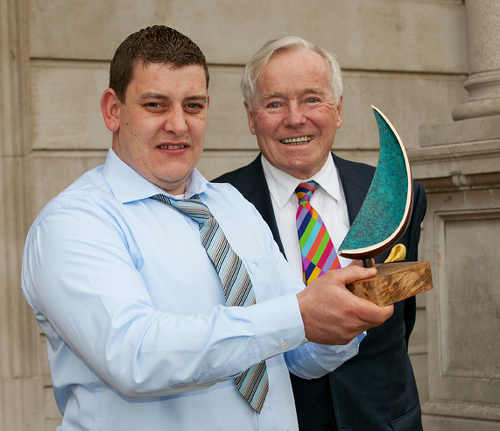

What makes the best of our young fishmongers stand out from the crowd? Marilyn Bright concludes her current series of interviews with some of Ireland’s best by talking to the winner of the inaugural Young Fishmonger of the Year, James Kirwan of East Coast Seafood in Naas, Co Kildare.
Black scabbard, orange roughy and cardinals - not fish you'd see on a fishmongers' slab these days, but instantly recognisable to James Kirwan of East Coast Seafood in Naas. Recently named BIM's Young Fishmonger of the Year, James spent 14 years fishing from deep sea trawlers out of Dingle and Donegal, ranging as far as the Azores and the Bay of Biscay, with summer stints off Clogherhead for Dublin Bay prawns.
 These days he's firmly land-based, bringing the best the sea has to offer to town dwellers who are showing an increasing appetite for seafood. Although he enjoyed the seafaring life and had earned his ship's engineers ticket, James recalls that rising costs and prospects of a better family life tipped him towards a job ashore. After two years in the courier business with his dad, he decided to return to what he knew best and asked his fishmonger uncle to train him in the skills he'd need behind the counter.
These days he's firmly land-based, bringing the best the sea has to offer to town dwellers who are showing an increasing appetite for seafood. Although he enjoyed the seafaring life and had earned his ship's engineers ticket, James recalls that rising costs and prospects of a better family life tipped him towards a job ashore. After two years in the courier business with his dad, he decided to return to what he knew best and asked his fishmonger uncle to train him in the skills he'd need behind the counter.
James opened East Coast Seafood in a business park in Naas in 2009, choosing an area that had no existing fish shop. By the end of the first year, business had expanded to take in an adjacent unit, and this year will see the addition of a third unit, a production kitchen financed by James' Young Fishmonger prize winnings.
“With our own kitchen, we'll be able to offer value-added products like chowder, fish pies and fish cakes as well as ready-made stock bases and sauces," James says, “Well also have ingredients for crusts and toppings and expand the range of Irish products we already sell in the shop — Derrycamma rapeseed oil, Atlantic Sea Salt, dillisk and carrigeen moss all sell well.”
James has no doubt that his time at sea and knowing the boats helps him pick top class fish for the shop. With no suppliers delivering to Naas, everything is collected from Dublin market and Clogherhead, nearly all bought as whole fish.
“We do 95% of the filleting ourselves and we'll peel the prawns for customers if that's what they want. Part of my BIM prize was a trip to France and I noticed that customers there buy whole fish, while the Irish prefer fillets with no bone or skin. You have to provide good service, but you get a return from customers and that's what keeps you in business, and enjoying it as well.”
East Coast Seafood celebrates its fifth birthday this year and clearly has tapped into growing consumer demand for fresh fish. “The business has grown steadily since day one,” James observes, “with people buying fish through the week, not just on Fridays. Holy week is still a peak time though, and Good Friday is totally manic, with queues out the door from about 11 o'clock in the morning.”
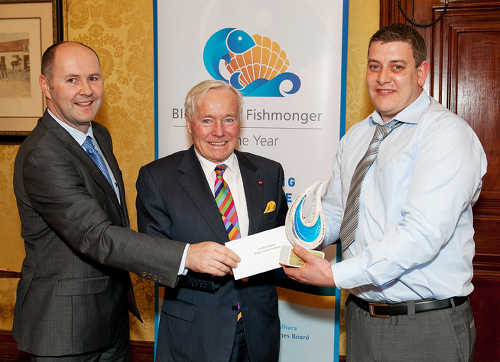 Main sellers from the beginning have been cod, salmon and plaice and James has been working hard to introduce customers to a wider range of seafood. “ We've been offering hake from Dingle at a good price and the ad promotion with Daithe O’Se was very helpful. Haddock is coming on too and recipe cards with serving suggestions in the shop help us to move customers on to try something new.”
Main sellers from the beginning have been cod, salmon and plaice and James has been working hard to introduce customers to a wider range of seafood. “ We've been offering hake from Dingle at a good price and the ad promotion with Daithe O’Se was very helpful. Haddock is coming on too and recipe cards with serving suggestions in the shop help us to move customers on to try something new.”
James admits that introducing less familiar fish requires sustained effort and can he expensive. “We tried dabs and witches which didn’t go, but lemon sole did, and they’re all part of the turbot and brill family. We get in the odd redfish - also known as Norwegian haddock or ocean perch - and that is very popular with our Filipino customers.”
Groundwork for the new seafood kitchen has been underway for several months, with input from BIM's Eileen Sorahan in regard to hygiene and quality control systems, “It has to be 100% right,” James emphasises “We’re working with a chef and a food scientist in regard to food preparation, and we'll designate a member of staff to work in the kitchen with the chef as we develop dishes.”
James is one of his own best customers, eating fish three or four times a week. Brill with a pinenut crust from Clodagh McKenna's cookbook is a favourite, but he also loves mackerel, just grilled with lemon and salt. “And you can't beat cod or haddock pan-fried in a little butter. People don't realise how quick and easy it is to cook fish.”
Having started as a two-man operation with just James and his partner Renée, East Coast Seafood now employs two full time staff and one part-timer. With a steadily growing customer base and the kitchen expansion, James is looking forward to Renée's return to the business after time out for two babies. “A woman in the shop is a definite asset," he says, “Customers like to see a friendly face and women are good with customers. When Renée is here, she's the boss," he adds.
The Seafood Interview supported by BIM - Aidan McGrath of The Wild Honey Inn


This month Marilyn Bright talks to Aidan McGrath, whose guests at The Wild Honey Inn in Lisdoonvarna, Co Clare are delighted by the wonderful seafood dishes he serves at accessible prices - no shortcuts in this kitchen!
Surrounded by the big skies and spectacular sunsets of the wild Atlantic coast, and flower carpeted hills of the Burren, The Wild Honey Inn is marked out in more than one guide book as a romantic hideaway and good food destination. This once quiet comer of Clare is attracting good reviews and a stream of visitors as they explore the corkscrew hills and fuchsia lined roads buzzing with dozy bees.
 Five years ago the touristic scene was decidedly different. Aidan McGrath and his wife Kate took on what was then a dilapidated country hostel just outside the spa town of Lisdoonvarna. The old inn had a good pedigree, built in 1860 to cater for Victorian guests drawn to the mineral waters. When the McGraths arrived in 2009, the derelict building had been boarded up for several years, but the remains of old monogrammed crockery was found inside, “We started up in the worst year possible, in the depths of economic depression,” Aldan recalls.
Five years ago the touristic scene was decidedly different. Aidan McGrath and his wife Kate took on what was then a dilapidated country hostel just outside the spa town of Lisdoonvarna. The old inn had a good pedigree, built in 1860 to cater for Victorian guests drawn to the mineral waters. When the McGraths arrived in 2009, the derelict building had been boarded up for several years, but the remains of old monogrammed crockery was found inside, “We started up in the worst year possible, in the depths of economic depression,” Aldan recalls.
Aidan had already earned his spurs as an award-winning chef at the distinguished Sheen Falls Hotel and then at his own restaurant at Bunratty Castle. With a family venture in mind, he felt that the time was right to get away from fine dining. The old inn met his requirements for a pub with guestrooms and living accommodation for the family.
As they set about refurbishment, Aidan recounts how the arrival of the Brennan brothers and their television series “At Your Service” was a spectacular stroke of luck. “In addition to their expert advice, it gave us tremendous publicity and got our name out there. With repeats and screenings on channels abroad, we’re still getting publicity and comments from guests booking rooms and dropping in for meals.”
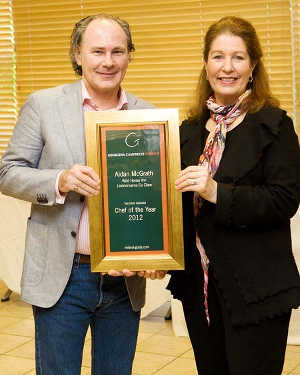 The relaxed atmosphere and welcoming fire are the setting for a menu which is uncomplicated yet showcases the bounty of Clare produce, and earned Aidan the title of Georgina Campbell Guides Chef of the Year 2012. With the Atlantic coast a few miles away, seafood is a speciality, and it’s become a destination for seafood lovers who are keen to sample everything Aidan cooks up from a lunchtime open sandwich of Liscannor crab with pickled cucumber and organic leaves on homemade brown bread or a fish pie with creamy velouté and a herb crust, to an elegant presentation of turbot and scallops on the dinner menu.
The relaxed atmosphere and welcoming fire are the setting for a menu which is uncomplicated yet showcases the bounty of Clare produce, and earned Aidan the title of Georgina Campbell Guides Chef of the Year 2012. With the Atlantic coast a few miles away, seafood is a speciality, and it’s become a destination for seafood lovers who are keen to sample everything Aidan cooks up from a lunchtime open sandwich of Liscannor crab with pickled cucumber and organic leaves on homemade brown bread or a fish pie with creamy velouté and a herb crust, to an elegant presentation of turbot and scallops on the dinner menu.
In addition to a changing catch of the day board, there are occasional all-seafood nights, often featuring the local turbot and black sole which some restaurants avoid as it can be prohibitively expensive in some areas. “We're lucky to be able to get good supplies of these prime fish and work with our supplier to be able to offer them at reasonable prices, selling sole at less than €30 and turbot at around the €26-27 mark. Our fish comes from the Cahills who have their own boat out of Doolin harbour and supply from other ports on the west coast as well.
The list of landed catch is texted to Aidan every morning as he makes up the days specials, which might range from gurnard fillets pan-fried with buttered samphire and charred orange segments to pickled mackerel with beetroot salad and horseradish mayo. Hard-to-get winkles, always cooked in seawater, go into creamy risotto richly greened with flat leaf parsley to go alongside crispy skinned cod or brill.
Aidan avoids trawlered shellfish and prefers to use pot-caught langoustines from day boats out of Galway and Castletownbere which arrive in top condition. The prawn tails are used in a number of dishes, while the heads and shells are bagged and frozen to be flamed in brandy later and used to make stock for bisques and sauces, “We do all our filleting and boning in-house, Aidan says, and all the trimmings go into a stock reduction base for sauces. We don't use flour and just a small amount of cream for some dishes.”
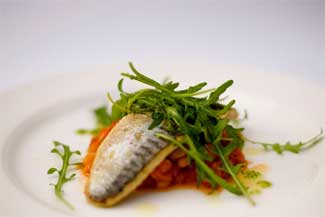 The move away from heavy sauces and a preference for lighter dishes is just one of the trends Aidan has noticed in the five years they've been open. “In the beginning, fish and chips and Burren beef burgers ware popular lunchtime choices and we did them very well with our own pickles and accompaniments. As time went on, customers were ordering a wider range of dishes, things that were different to what was available in other places, so we were happy to drop the fish and chips and burgers.”
The move away from heavy sauces and a preference for lighter dishes is just one of the trends Aidan has noticed in the five years they've been open. “In the beginning, fish and chips and Burren beef burgers ware popular lunchtime choices and we did them very well with our own pickles and accompaniments. As time went on, customers were ordering a wider range of dishes, things that were different to what was available in other places, so we were happy to drop the fish and chips and burgers.”
Aidan has also noticed a shift toward healthier eating habits, with snacking and casual eating being replaced by a good breakfast and one proper three course meal taken during the day, either at lunch or dinnertime.
Customers are also interested in food provenance and like to see that the crab claws are from Liscannor and the award winning smoked salmon comes from the Burren Smokehouse just a stroll down the road. St. Tola organic goats cheese from Inagh appears in the Wild Honey take on tartiflette, layered with potatoes, melting onion and bacon. For desserts, poached rhubarb and honeycomb parfait go alongside hazelnut cake bathed in Bunratty mead syrup and molten chocolate fondant is topped with a sweet foam of O'Hara's stout.
Small local growers supply salad leaves and herbs and, when he has time, Aidan likes to forage for things like wild garlic and elusive Burren land cress, “There's so much here to use,” he says, “from hazelnuts to wild herbs and sea vegetables. I’d love to find a forager - there's a job for someone out there.”
The Seafood Interview supported by BIM - Diarmaid Murphy of The Fish Kitchen, Bantry
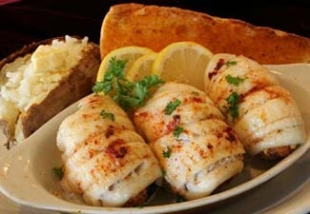

This month Marilyn Bright talks to Diarmaid Murphy of The Fish Kitchen, Bantry, where “Keep it fresh and keep it simple” is the byword
With the sparkling waters of Bantry Bay just below, it would be easy to imagine the spanking fresh fish leaping straight onto the plates in Anna Marie and Diarmaid Murphy's Fish Kitchen restaurant. Concerns about air miles and road miles simply don't apply when the seafood served up comes from the harbour below and the nearby fishing ports West Cork is famed for.
 The Fish Kitchen opened six years ago above the Central Fish Market run by Anna Marie's brother Colman Keohane in what was once the family grocery and butcher shop. Colman also runs Keohane’s in The Food Emporium in Cork and, since 2010, has operated the state-of-the-art Keohane’s Seafood (www.keohaneseafoods.ie) processing plant just outside Cork city, together with his brother Brian and their father Michael.
The Fish Kitchen opened six years ago above the Central Fish Market run by Anna Marie's brother Colman Keohane in what was once the family grocery and butcher shop. Colman also runs Keohane’s in The Food Emporium in Cork and, since 2010, has operated the state-of-the-art Keohane’s Seafood (www.keohaneseafoods.ie) processing plant just outside Cork city, together with his brother Brian and their father Michael.
Always innovative, they saw an opportunity for producing pre-packed, microwavable ‘skin filmed’ fish, which is very convenient and can be cooked from fresh or frozen in just a few minutes without any need to handle raw fish. This has been a huge success and they supply some of their ‘tide-to-table’ traceable range to Tesco UK, as well as all of the Irish multiples.
The Fish Kitchen and The Central Fish Market have a healthy symbiosis, with the fish shop's vivarium handily supplying live lobsters, oysters and shellfish as needed during restaurant service. “We buy direct from the boats and small fishermen,” Diarmaid says, “Bantry Bay mussels are a mainstay - they're rope grown, much cleaner and meatier than dredged and they're put through purification tanks for safety."
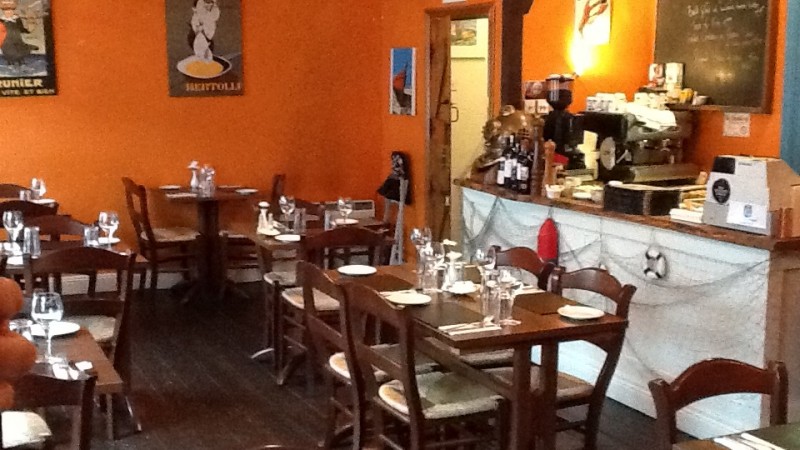 Anne Marie and Diarmaid have experience in restaurants and pub management respectively, but tend more to look after front of house. Chef Tiernan Vaughan trained as an electrician before a career change and works with Anne Marie on new dishes as they continually update menus. “We just have 28 -30 covers and a small kitchen, so we all multi-task with Anne Marie and I both turning a hand to baking the morning brown bread.
Anne Marie and Diarmaid have experience in restaurants and pub management respectively, but tend more to look after front of house. Chef Tiernan Vaughan trained as an electrician before a career change and works with Anne Marie on new dishes as they continually update menus. “We just have 28 -30 covers and a small kitchen, so we all multi-task with Anne Marie and I both turning a hand to baking the morning brown bread.
“Keep it fresh and keep it simple” is the byword in The Fish Kitchen. Popular lunches would be lemon sole or plaice simply pan-fried and served with lemon butter, or summery mackerel with the Murphy's home grown potatoes. Caesar salad might come with the fish of the day from the blackboard, and crab cakes or open sandwiches are daytime favourites too.
Midsummer is the best time for variety, Diarmaid reckons, with lots of boats out and food supplies coming in to be chalked up on the blackboard. “There's a lot of prime fish at the moment. We do black sole on the bone, John Dory, brill - just keeping it simple, pan-fried or grilled with different butters and sauces. Turbot for instance is delicious with red onion and caper butter.”
 Fresh prawns come from Union Hall and Castletownbere for the classic prawn cocktail with Marie Rose sauce, still “remarkably popular”. The Murphys use good sized number 12's — that's 12 to the kilo whole weight — with a light coating of sauce, not doused, Diarmaid emphasises.
Fresh prawns come from Union Hall and Castletownbere for the classic prawn cocktail with Marie Rose sauce, still “remarkably popular”. The Murphys use good sized number 12's — that's 12 to the kilo whole weight — with a light coating of sauce, not doused, Diarmaid emphasises.
Prawns also feature with monkfiish in a Thai green curry served with basmati rice and poppadoms, or take on Spanish flavours as a starter of pan-fried chorizo, chilli and garlic prawns with fresh coriander topping. There is also a seafood tortilla wrap of mixed fish with tomato sauce, topped with cheese and guacamole and finished under the grill.
The specials of the day can be just as popular at lunchtime as in the evening and Diarmaid points out that there is good year-round local trade from people from all over the world who have settled in Ireland and retired to the area.
There's no consistency as to the popularity of some dishes, but they have noticed varying preferences among customers. “You can't sell skate or ray to locals, but Dubliners love it, and the French go mad for fresh oysters on the half shell.”
The Fish Kitchen is Bantry’s only dedicated fish restaurant but they do accommodate with a chicken salad at lunchtime and the surf and turf evening option, pairing sirloin steak with crab claws. “When a customer is uncertain about choosing fish, I encourage them to try hake,” Diarmaid says. “Nine times out of ten, they enjoy it and will come back for more.”
Although there's no special children's menu at The Fish Kitchen, they encourage the younger set to try a small portion of anything on the day's menu. They'll offer a mini fish and chips with goujons of haddock and flaky fish like cod goes down well with a sauce. “They do sometimes surprise you though - I've seen a child scoff down half a dozen oysters, no problem,” Diarmaid comments.
Healthy eating campaigns have contributed to the increasing popularity of seafood,' Diarmaid observes, and media reports about issues like discards and sustainability have made people more aware of problems.
“Some customers won't eat farmed salmon, but we try to use organically and ecologically farmed salmon when it's available. The restrictions on wild salmon are sad, but very necessary. When it comes to discard management, the scientists and politicians seen to be saying different things, quotas change every year and what the papers print can be confusing. We can only do our best to follow sustainability and support our Irish fishing fleet.”
The Seafood Interview supported by BIM - Michael O'Neill of O'Neill's The Point Bar
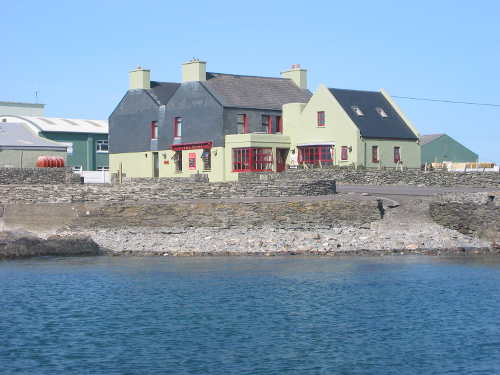

This month Marilyn Bright talks to Michael O’Neill of O’Neill’s The Point Bar, Renard Point, Caherciveen, Co Kerry; with a big reputation for ultra fresh seafood, the ‘simplest is best’ mantra at this immaculate little bar clearly works
“A small place with a big reputation,” is how O'Neill's The Point Bar is recommended by those in the know. Michael and Bridie O'Neill are the fourth generation to preside over the old family premises beside the Valentia Island car ferry dock at Renard Point just outside Cahirciveen, in Kerry.
Summer sees the harbour road thronged with seafood lovers drawn to the spanking fresh fish served up in generous quantity from the Point Bar's tiny kitchen. It wasn't always so, Michael explains, “It was an old-fashioned bar and my father was the agent for the foreign fishing vessels putting into the pier at Renard Point, which was the only deep water harbour in the area at the time. They generally didn't put into port unless there was a problem, or they might trans-ship the catch back to home ports or change crews.”
The Point was definitely a fishermen's bar - not a place you'd bring a lady, Michael recalls. Mainly Spanish, some French and Norwegian, the fishermen would arrive with bags of the best fish - halibut, turbot, monkfish. It would be cooked in what was then the family kitchen and passed out in the bar for free. Michael remembers as a teenager seeing the kitchen full of sea captains and engineers.
Things gradually changed as the harbour began to be starved of funds for maintenance. As the fishing vessels disappeared, the local businesses suffered - the grocers and butchers that had supplied the fishermen were all affected. The deep water pier only closed officially 15 years ago, but the downturn had started years earlier.
Michael took over the bar 25 years ago, when his father pulled down the shutters for the last time and said, “It's all yours now.”
 Reconfiguration of the premises was moderate, moving toilets from the old position “out back” and hiving off the private living quarters. “It's modern, yet old fashioned,” Michael describes it, with the air of a man who would be wary of anything too new-fangled.
Reconfiguration of the premises was moderate, moving toilets from the old position “out back” and hiving off the private living quarters. “It's modern, yet old fashioned,” Michael describes it, with the air of a man who would be wary of anything too new-fangled.
A small bar kitchen was fitted with a four ring gas hob to do soup and toasted sandwiches, mainly for the passengers using the Valentia Island car ferry which runs during the summer months. Still, so much fish was being given to the O’Neills that it was being passed on to neighbours or, regrettably, discarded. “I started just cooking hake for bar customers,” Michael recalls. “People didn't know monkfish at all, but I tried a bit of sea bream. People were wary at first but liked it. The food side of the business started rising, then the Celtic Tiger took off, we got a name for fresh fish and I could hardly cope.”
Michael takes pride in claiming that the menu hasn't changed in 25 years, although there have been the slightest of tweaks. The original menu was simply pan-fried fish and bread. Salad has been added - “at Bridie's insistence” - and buttered potatoes. There are seven or eight choices on the menu. “If you can do one thing well, why bother with more?” is Michael's motto.
Simple fresh produce is the byword, and Michael presides alone over a batterie de cuisine that consists of two frying pans and a deep-fat fryer; shallots, garlic, olive oil and egg wash batter. Period. “I’m not a chef and I couldn't make a sauce or gravy, but everything is fresh, simply cooked and I make sure the last order going out is as good as the first one”.
Best seller is pan-fried hake, all best quality long-line caught as Michael explains that trawled fish can be drowned as they're dragged for hours in nets. Popular squid from Killybegs can be big, so it's cut into strips rather than rings, battered and deep-fried. Lobsters are served cold, split, with salad and mayonnaise, or garlic butter if requested.
Food miles are negligible here as O'Neill's fish comes from Quinlan’s Kerry Fish 20 yards away or Daly’s 2½ miles down the road in Cahirciveen. With the increased volume of business, Michael orders in most fish ready filleted, but insists on doing skinning and portioning himself. Picked crab meat from Quinlan's is excellent, he says, and demand is huge. “It's easy as pie to use - just moistened with mayonnaise or hot au gratin with cheddar, salad and brown bread. Hot crab claws with piri-piri sauce go into newly acquired Spanish cazuela dishes.
Michael's pared-down approach to the menu doesn't allow for desserts, but the house speciality of “proper” Irish coffees has high uptake.
Clearly the “simplest is best” formula works, as the little harbourside bar is thronged during the summer months with customers happy to wait out the no booking system. Bridie works front of house, managing the tables which may turn over two or three times, and serving as many as 130 meals in an evening. “I've never seen what's happening outside,” Michael claims, “I live in a one square metre area for six months of the year.”
Business runs with the ferry, and when the service ends in October the O'Neills take a well-earned five week break. Weekend openings during the winter cater for loyal customers and the steady stream of Kerry tourists. August is high season and Michael counts himself lucky that he'll be out of the kitchen by 10.30 instead of midnight as was the case before drink-driving restrictions were introduced. And, after some years' consideration, Michael has taken another step toward modernity - they started accepting credit cards last month.
The Seafood Interview supported by BIM - Tricia Kealy of Kealy's Seafood Bar
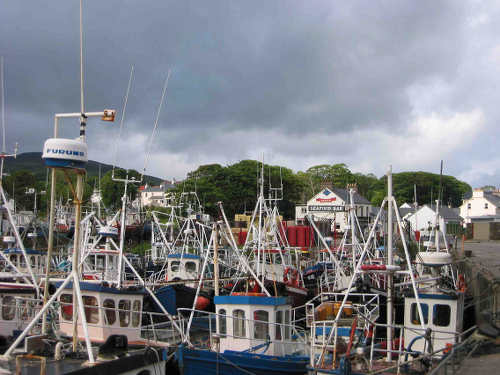

This month Marilyn Bright talks to Tricia Kealy of Kealy’s Seafood Bar in Greencastle Co Donegal about their 25th anniversary, some of the nostalgic menu dishes that were brought back this summer in honour of the occasion - and some newer items on the menu
Set on Ireland's most northerly point where the wild Atlantic crashes into the depths of Lough Foyle, Kealy's Seafood Bar crowned 25 years of business this summer with a nostalgic return to the menu dishes that first attracted seafood lovers to this tiny harbourside village (see menu below).
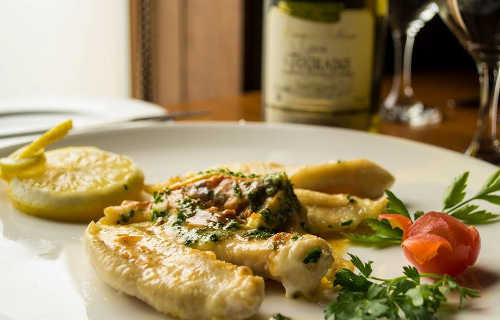 A signature dish of John Dory with anchovy butter, which has never been off the menu, starred alongside fashion-of-yesteryear fanned ogen melon in muscat, smoked salmon surprise which enclosed a stuffing of scrambled egg and chive, and a classic duck à l'orange of happy memory.
A signature dish of John Dory with anchovy butter, which has never been off the menu, starred alongside fashion-of-yesteryear fanned ogen melon in muscat, smoked salmon surprise which enclosed a stuffing of scrambled egg and chive, and a classic duck à l'orange of happy memory.
Poached fillet of cod with Stilton sauce or mustard crusted salmon with spring greens and bacon were flanked with retro dessert choices of fruit pavlova and crème caramel.
Ultimate indulgence was chocolate truffle gateau with Bailey's creme anglaise, “but we did stop short of Black Forest gateau,” Tricia Kealy laughs.
“We had great fun putting together the anniversary menu,” she remembers, “It made us realise how much people's tastes have changed and they're open now to much greater variety, but there are two original dishes we’d never be allowed to take off the menu - John Dory with anchovy butter and our whitefish and salmon chowder with pink peppercorns, although we eliminated the mussels because of the number of people with shellfish allergies.”
A flurry of refurbishment preceded the celebratory re-opening this spring. “We stripped the floors, revamped seating and put up new blinds,” Tricia explains. “It was stressful, but after 25 years it was needed and we wanted to have a special party to thank the loyal customers who've been coming here over the years, when Greencastle was still a cul-de-sac at the end of the peninsula.”
 Tricia and her late husband James both trained as chefs in the Killybegs Catering college and went on to work in Dublin before returning to Greencastle to re-open the old Kealy family pub that had been closed for several years.
Tricia and her late husband James both trained as chefs in the Killybegs Catering college and went on to work in Dublin before returning to Greencastle to re-open the old Kealy family pub that had been closed for several years.
Tricia remembers that they started serving food at five tables set up in the traditional fishermen's bar, “and, with fish being landed just paces from our front door, it made sense to feature seafoods. It's a huge advantage when you can look out of the window and see the fishing boats arriving back with your fresh ingredients.”
News of the delicious fresh food spread by word of mouth and Tricia recalls that competition for the five tables could be fierce - “like a rugby scrum” - especially on Saturday nights in summer. After four years, adjacent space was acquired and the restaurant now seats 60, with food still being served in the bar.
Although business was always seasonal, with an influx of summer visitors, Kealys was given an enormous boost with the return of the Magilligan car ferry which marks the start of the summer season on St Patrick's day, bringing customers from the North across Lough Foyle and landing them a short walk from the restaurant door.
Tricia also credits initiatives like Derry's City of Culture activities and the development of the Wild Atlantic Way bringing vitality to the area, along with improved roads that now bring visitors and summer residents from the South.
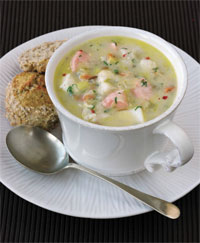 Kealy's famous chowder is still the top order, with a bar food menu that is served through the day and has adapted to modern trends with tapas plates and sharing platters. Foyle Mor oysters from 20 minutes away are mostly served up au naturel, but James's original “Pearl of the Foyle” is still regarded as a local classic - with oysters flamed in brandy and cream and served en croute with smoked salmon.
Kealy's famous chowder is still the top order, with a bar food menu that is served through the day and has adapted to modern trends with tapas plates and sharing platters. Foyle Mor oysters from 20 minutes away are mostly served up au naturel, but James's original “Pearl of the Foyle” is still regarded as a local classic - with oysters flamed in brandy and cream and served en croute with smoked salmon.
Newer additions like monkfish and lime ceviche, nachos with jalapeno dip and deep-fried squid rings with chipotle mayo put a South-of-the-Border swerve on the menu, courtesy of Tricia's adventurous sons who have interspersed work and studies with travel to Mexico and South America. Oisin is back for the summer season, joining Tricia in the kitchen, while Eoghan runs front of house.
Their new ideas keep things interesting, Tricia says, although there isn't much chance of boredom in the busy kitchen where everything from ice cream and relishes to yeasted focaccia is made in-house.
Batches of their special wheaten scones are baked constantly through the day and all fish is boned and filleted on site. “Our fish comes straight from the Greencastle Co-op boats to our door on a fork lift, so we deal with everything - nothing is wasted and we have bones for our own stock.”
Organic vegetables are sourced from White Oaks Rehab farm at Bridgend, including the vast amount of Donegal potatoes that are used to make hand-cut chips and champ, potato cakes, rosemary mash and creamy dauphinoise.
Lobster, crab and shellfish come from Malin Head a few miles away, and Tricia laments the fact that the dozen or so local salmon boats have gone, so she sources the best quality farmed fish to go into dishes like simply grilled salmon with lime and dill butter.
Business reaches a crescendo in August, with cruise liners docking outside the harbour to ferry day visitors ashore, regatta weekends and events like the international clipper race that set off from Derry this year. “September can be busy, but the families disappear and we have more tourists,” Tricia observes. “Even when the ferry stops in October, we'll be busy at week-ends with the loyal Northern customers and locals that keep us going during the winter.”
KEALY'S 25th BIRTHDAY MENU
Amuse-bouche
≈
Smoked Salmon Surprise
Oysters Pearl of the Foyle
Filo parcel of Crab & Smoked Salmon
James’s Greencastle Chowder
Gubbeen fritters with honey & mustard dressing
Dressed Ogen Melon with Muscat, Passion fruit sorbet
≈
In-house sorbet
≈
Grilled fillet of John Dory, anchovy butter
Pan-fried Monkfish Mediterranean style
Poached fillet of Cod, Stilton sauce
Mustard crusted Salmon, spring greens and bacon
Chicken stuffed with Smoked Salmon, whiskey and caper sauce
Duck à l'orange, potato basket
Pan-fried Sirloin Steak Chasseur
(All of the above served with a choice of either vegetables, potatoes, salad or hand-cut chips)
≈
Fruit Pavlova, caramel cage
Crème Caramel
Chocolate Truffle Gâteau, Baileys crème anglaise
Passion fruit Bavoir
Selection of homemade breads included
The Seafood Interview supported by BIM - Marco Roccasalvo of Campo de' Fiori
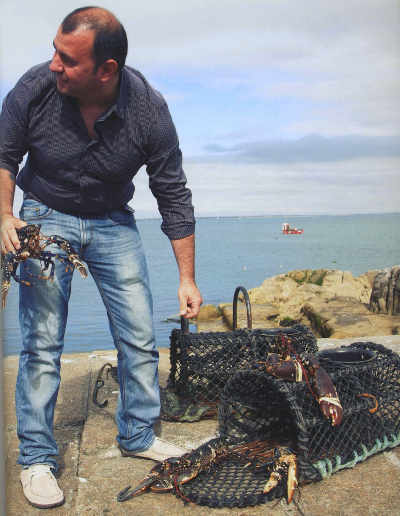

This month Marilyn Bright talks to Marco Roccasalvo of Campo de' Fiori on the seafront in Bray - where seafood is a natural speciality
“The best Italian restaurant in Ireland is Campo de’ Fiori in Bray”. Whatever about rosettes and plaques, recommendations don't come more heartfelt than this from a homesick Italian taxi driver. Marco Roccasalvo’s deft fusion of classical Italian cooking with best Irish produce has won a following of good food lovers that extends far beyond nostalgic ex-pats.
Named for the famous field of flowers square in Rome, Campo de’ Fiori opened in its present location six years ago in a defunct restaurant on Bray’s seafront. “It was in a terrible state,” Marco remembers. “A normal person would have walked away, but I felt it had something special so we got gloves and masks and set to - cleaning and painting and hammering. This place is handmade, just like all our food.”
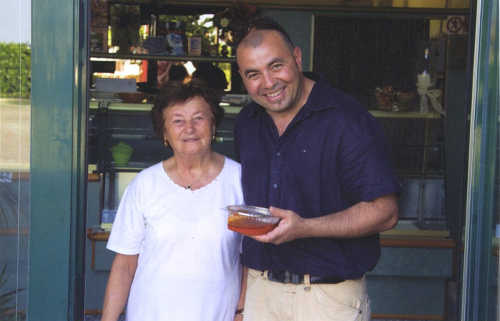 With rollers of the Irish sea visible just beyond the Esplanade, it was natural that seafood would be a menu specialty. Antipasto del pescatore is the impressive interpretation of the seafood platter starter, with a selection of fish dishes of the day served one after another in the Italian tradition. In impepata di cozze, rope-grown Cork mussels are given seasonings as old as ancient Rome - garlic, black pepper, white wine and parsley.
With rollers of the Irish sea visible just beyond the Esplanade, it was natural that seafood would be a menu specialty. Antipasto del pescatore is the impressive interpretation of the seafood platter starter, with a selection of fish dishes of the day served one after another in the Italian tradition. In impepata di cozze, rope-grown Cork mussels are given seasonings as old as ancient Rome - garlic, black pepper, white wine and parsley.
Lobster has become a house speciality, currently featuring in no less than four different dishes. Asticizzando is a starter plate of lobster salad, lobster ravioli and salmon soufflé with cauliflower mousse. Whole grilled lobster is seasoned with lemon, herbs and olive oil, or sautéed in a pan with mussels, prawns and cherry tomatoes, and can be ordered on or off the shell. Tonarelli all’ astice is a signature dish of homemade egg spaghetti with a half lobster and prawns in Marco's ragu sauce with Italian hill tomatoes.
Marco's mother cooked in a Roman seminary for 40 years and an uncle was head chef at the prestigious Ristorante Cesarina in Piedmonte, “So talk at home was always about food,” he remembers. “I took cooking courses and, at the age of 23, I opened the first gastropub in Rome and a second one later in Castelgondolfo.”
The move to Ireland came about ten years ago when Marco decided that a change of life and a new venture was in order. When a look around England convinced him it was “too big and too busy”, he came to visit friends in Athlone and ended up staying. Taking various cheffing jobs gave him a chance to explore locations as diverse as Cork, Belfast and Donegal before finding what he was looking for on the Wicklow coast.
Initially opening around the corner from the present restaurant (in the premises now occupied by the Campo de’ Fiori Risto Market) Marco quickly built a reputation with his own interpretations of authentic Italian dishes made with ingredients as fresh and local as possible. “Good food starts with good ingredients,” he emphasises and goes on to cast scorn on “fake Italian food” - the likes of pineapple on pizza and chips with lasagne. And not many people know that a real Italian would never have chicken on pizza or in pasta dishes.
Healthy eating trends are reflected on Marco's menu too. The familiar fritto misto becomes grigliata mista, with fresh seafood grilled rather than deep-fried. Aubergine slices for the Neapolitan dish of melanzane parmigiana by-pass the traditional fryer and get a brush of olive oil before baking in the oven. Fresh vegetables are sparked with Italian seasonings like the roast potatoes with garlic and rosemary, spinach sautéed with butter and Parmesan and broccoli saltata pan-seared with garlic, chilli flakes and olive oil.
Gluten-free dishes are flagged on the menu and gluten-free pasta is available, or customers can opt for carnaroli rice to replace pasta in any of the dishes, Marco points out that substitutions are not a problem because everything is cooked from fresh as ordered. “Slow-cooked ragu is the only sauce made in advance, “Marco says. “'We don’t even cut the meat until it’s ordered.”
This philosophy is enthusiastically expressed in Marco’s book Buon Appetito (€20, online from campodefiori.ie), a cookbook that ‘shares the secrets of creating delicious Italian food at home using the everyday ingredients we are all familiar with’ - and, as Marco has a special affinity with fish, that includes plenty of Irish seafood.
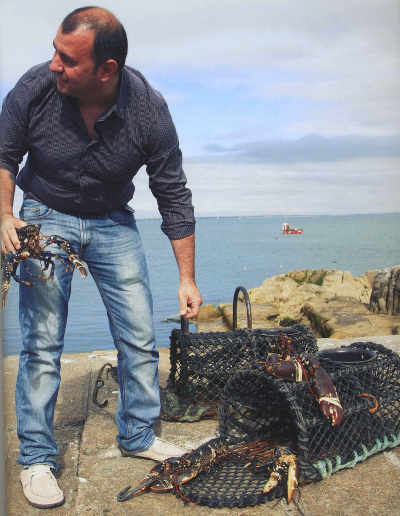 He takes a very practical approach to buying (‘How can you tell when fish is fresh?’), cleaning and preparation as well as giving a great range of recipes (see sample below). Lobster is a favourite with Marco, as it is for many other people, and he explains clearly how to deal with it at home - including a beautifully simple recipe for boiled lobster.
He takes a very practical approach to buying (‘How can you tell when fish is fresh?’), cleaning and preparation as well as giving a great range of recipes (see sample below). Lobster is a favourite with Marco, as it is for many other people, and he explains clearly how to deal with it at home - including a beautifully simple recipe for boiled lobster.
Risto Market around the corner is the informal daytime branch of Campo de’ Fiori, reminiscent of the Italian groceria combination of delicatessen and snack bar. Billed as an ' Aladdin's cave of delights', shelves are bursting with Italian specialties including 24 month aged Parmesan and 25 different cheeses as well as the fresh handmade pastas and breads made daily for the shop and restaurant. The soft panino rolls that make Italian style sandwiches are listed as ‘pizzino’, an Italian in-joke that refers to messages smuggled in bread by an imprisoned mafia boss.
Marco reflects that the daytime deli has been an important part of post-tiger survival, where busy customers can have a glass of wins and order pizza by the slice or pick up fresh pasta and homemade sauces for wieals at home.
“At the height of the boom, the restaurant was booked out every night. Weekends are still busy, but weekday business is gradually building again and we have a ‘Cheap and Chic’ tasting menu which brings in customers when it’s less busy.”
From lobster ravioli, fat Donegal oysters and aged hereford beef in Campo de' Fiori to rustic pizza and lasagne classics “like Momma’s” in Risto Market, this corner of Bray seafront offers Mediterranean flavour to suit every pocket.
RECIPE (from Buon Appetito, The Campo de Fiori Cookbook):
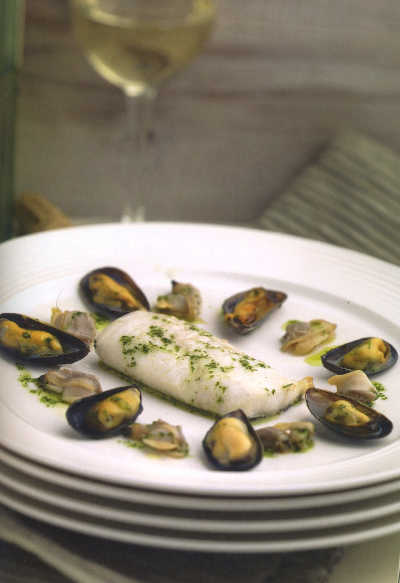 San Pietro con cozze e vongole - John Dory with mussels and clams
San Pietro con cozze e vongole - John Dory with mussels and clams
“One of my signature culinary traits is to accompany fillets of fish with shellfish. I have used this combination in many of my dishes at Campo de' Fiori and I think it works particularly well with fish that have a delicate flavour. This recipe combines John Dory with the salty taste of shellfish and a light parsley pesto. You can substitute the John Dory with cod, sea bass, sea bream, hake or turbot. But do try it with the John Dory first. It's a lovely, tasty dish.”
Serves 2
For the pesto
1 bunch flat-leaf parsley, roughly chopped
30ml extra-virgin olive oil
Juice of half lemon
1/2 tsp salt
Freshly ground black pepper
For the fish
Extra-virgin olive oil
1 clove garlic, halved
2 John Dory fillets (about 200g)
30ml dry white wine
20 mussels, washed and debearded
20 clams, washed
Start by making the pesto. Wash and dry the parsley and chop it up. Place it in a deep plastic container suitable for use with a hand blender and add 30ml of oil, 1/2 teaspoon of salt, the lemon juice and some freshly ground black pepper. Blend with the hand blender until you obtain a fairly liquid pesto. Add a little extra oil if the pesto seems too creamy.
To prepare the fish, heat 2 tablespoons of oil in a non-stick pan (with a lid) over a medium heat and add the garlic. Once the garlic has begun to brown, place the fish in the pan, skin side up.
Cook over a medium heat for 3 minutes and then use a spatula to carefully turn the fish over. Then add the wine, mussels and clams. Cover with the lid and increase the heat to maximum for about 3 minutes, until all the shells are open.
Remove from the heat and serve on warmed wide-brim plates. If you like you can remove the mussels and clams from their shells and arrange them as you see in the photo. Pour over the cooking juices and accompany with pesto.
The Seafood Interview supported by BIM - Peter Caviston
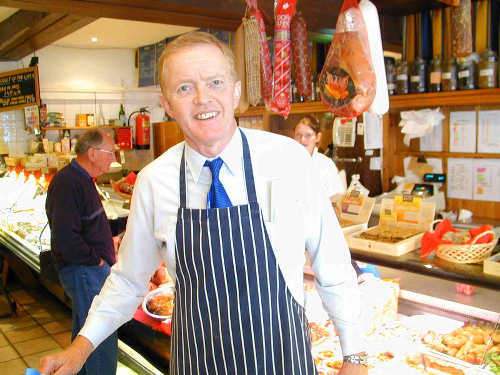

This month Marilyn Bright talks to one of the Dublin food scene’s most colourful characters, the second generation fishmonger Peter Caviston
The splash of colour that marks out Caviston's in Glasthule’s main street reaches a crescendo at Christmastime, when the tumbling displays of fruits and vegetables and winter greens are garlanded with holly sprigs and glittering wreaths spilling along the footpath.
 No less colourful is proprietor Peter Caviston second generation fishmonger who has now been joined in the business by sons Mark and David. “My father opened the shop in 1947 as a fishmongers and poulterers, which was the traditional pairing in those days - and poultry included game then too,” Peter explains. “Fish was displayed on white slabs in the window, always on ice because there was no refrigeration. Ice was delivered in 56 pound blocks to be crushed, and water was kept trickling down the window as a deterrent for flies. We kept a big vase of fresh mint in the display for the same reason.”
No less colourful is proprietor Peter Caviston second generation fishmonger who has now been joined in the business by sons Mark and David. “My father opened the shop in 1947 as a fishmongers and poulterers, which was the traditional pairing in those days - and poultry included game then too,” Peter explains. “Fish was displayed on white slabs in the window, always on ice because there was no refrigeration. Ice was delivered in 56 pound blocks to be crushed, and water was kept trickling down the window as a deterrent for flies. We kept a big vase of fresh mint in the display for the same reason.”
The window display was always a talking point, attracting customers with a wide variety of fish and seafood. Peter remembers the late Monica Sheridan, Ireland's first TV cook, dropping in to see what was available and discuss recipes with his father, as did Theodora Fitzgibbon later on. “With little refrigeration in homes, people had to do their shopping every day, so we needed to excite customers with a good display and establish a rapport once they were in the shop.
Knowledgeable staff encouraged people to try the less usual fish in the display, like monkfish which wasn't known at the time, giving out samples and explaining how to cook it.”
Generating cash was a problem in the lean 50's and 60's and items to complement fish were added gradually to encourage customers to fill their baskets —good olive oil and seasonings and what Peter considers essential, to a proper fish supper - good tea, along with the vegetables to complete a meal.
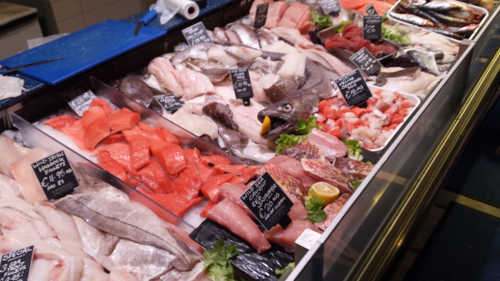 Today customers can choose from 20 to 40 different kinds of fresh fish and shellfish every day, ranging from the familiar cod, salmon and plaice to more exotic razor clams, red gurnard and sea urchins. In addition to cookery suggestions from counter staff, customers can consult Caviston's library of cookery books or avail of advice from three resident chefs attached to the delicatessen and restaurant added in recent years.
Today customers can choose from 20 to 40 different kinds of fresh fish and shellfish every day, ranging from the familiar cod, salmon and plaice to more exotic razor clams, red gurnard and sea urchins. In addition to cookery suggestions from counter staff, customers can consult Caviston's library of cookery books or avail of advice from three resident chefs attached to the delicatessen and restaurant added in recent years.
People are more open to trying different fish now Peter thinks, citing influence from travel and TV chefs as well as an increasingly international population bringing a variety of new food cultures. Caviston's scored a massive PR coup back in the 1970's, presenting the Japanese ambassador with two huge blue fin tuna which had been landed off the south coast.
The Japanese community flocked to buy the rare fish and the shop has built on its reputation for supplying the premium sushi grade fish for the oriental specialities which have now gone mainstream, along with the traditional accompaniments of nori, wakame and wasabi.
Carp and pike appear now with demand from Polish and eastern European customers, while grey mullet is prized by Chinese cooks. Monkfish cheeks from the once discarded heads found a ready market with the Spanish and now the meaty nuggets enjoy good general sales for quick cooking like scallops. Inner city Dubliners still love their ray wings and traditional chippers prefer what Peter calls blonde ray, more expensive than the star ray which is thinner and has less flavour.
Ling which was once only seen dried and salted is recommended by Peter as “poor man's cod”. Along with pollock and whiting, these fish were often avoided as being too bony. “A good fishmonger can get lovely fillets from these by using large fish and skilful boning. Megs (megrim) and witches are nearly always called white sole and the little fillets from these make gorgeous tempura."
Premium fish and luxurious seafood come into their own at Christmastime and Peter says that 25 % of their yearly business is done over the holiday period. Oysters from Kelly's of Galway come by two dozens packed in wood chip baskets.
Caviar is part of the festive splurge, ranging from the award winning Goatsbridge trout caviar to the dizzyingly priced Sevruga and Beluga. Smoked eel comes from Lough Neagh, and huge amounts of Clare Island organic salmon are processed in Caviston's own smokery to be sold in the shop or parcelled up for dispatch around the world.
Dublin Bay prawns (mostly coming from the west coast these days) are in huge demand, with Caviston’s customers looking for the largest sizes, tails only and ready to cook. Caviston’s stock only the highest quality frozen prawns (no added phosphates, and just a light glaze to protect them in the freezer) and Peter recommends them simply thrown into a pan with butter, garlic and a sizzle of white wine. Similar treatment is suggested for the top quality crab claws from Ted Browne in Dingle.
Whole turbot, brill and black sole are in demand for entertaining, with supply and price very dependent on capricious December weather, whole salmon stars as most popular buffet centrepiece, and Caviston's chefs can provide cooked dressed salmon, pinboned, re-formed and garnished for busy party-givers.
An expanding range of freshly chilled ready-to-cook and ready-to-heat products is designed to make life easy for home cooks, from fish stock and creamy chowder to seafood lasagne, fisherman's pies and cajun spiced salmon in microwavable dishes. “Everything is done with customer satisfaction in mind, whether it's fresh fish, deli products or food in the restaurant,” Peter reflects. “The bottom line is - would I eat it and would I pay the price? “
The Seafood Interview supported by BIM - Gerard Collier
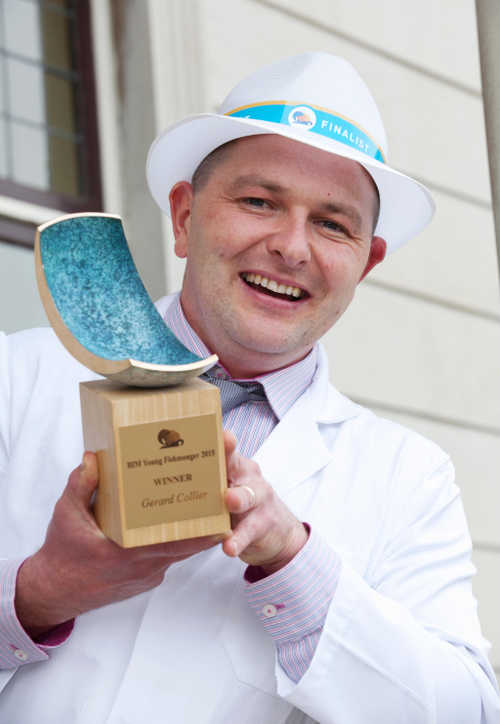

This month Marilyn Bright talks to Gerard Collier, recently named BIM Young Fishmonger for 2015.
Gerard works every day within sight and sound of the sea at Clogherhead's picturesque Port Oriel. Always drawn to the busy comings and goings of the fishing boats, he remembers cycling down to the harbour as a schoolboy, cadging jobs mending nets or tailing prawns.
 Today he presides over the aptly named Fisherman's Catch, a neat blue and white quayside shop whose modest size belies the huge variety of Irish caught fish displayed on its counters. Owned by the Kirwin family over four generations, the shop has its own fishing boat, Argonaut IV, which specialises in seine netting. “With this method, fish are only in the nets 40 minutes at most,” Gerard explains, “With other methods, catch can be dragged for four to five hours which affects condition.”
Today he presides over the aptly named Fisherman's Catch, a neat blue and white quayside shop whose modest size belies the huge variety of Irish caught fish displayed on its counters. Owned by the Kirwin family over four generations, the shop has its own fishing boat, Argonaut IV, which specialises in seine netting. “With this method, fish are only in the nets 40 minutes at most,” Gerard explains, “With other methods, catch can be dragged for four to five hours which affects condition.”
Fascinated by seine-netting, the youthful Gerard crewed aboard the Argonaut for two years before being given the opportunity to take over the day to day running of the shop five years ago. It’s a role he clearly enjoys and takes great pride in the wide variety of fish offered daily. “Having pick of the catch is key, and I choose the best from other boats and ports to offer a good range,” he says. “I like to include the less usual too, for show - we had three albino haddock this year, and a few rainbow wrasse with their tropical colours.”
Gerard attributes the change in types of catch and seasonality to global temperature shifts, noting that there are no more blue shark now and fishermen are seeing more whales, as many as 16 in one pod recently.
A real rarity was the 58kg conger eel landed, the largest ever recorded, which was frozen and sent to scientists in London. “Most females mature at about four years, then leave for the Mediterranean to breed,” he explains. “They die after spawning and only the young; travel back, so finding one reckoned to be 15 years old is rare.”
Local customers who have grown up in this ancient princedom of Oriel tend to be steeped in seafaring tradition, are generally knowledgeable and happy to eat a wider variety of fish than might be the norm in other areas. Red mullet, for instance is highly regarded, and with a brief season that lasts only about three weeks, Gerard says that it nearly sells out before it reaches the counter. He obliges regular customers who wait all year for it, by phoning to alert them when a catch is making its way to harbour.
Gerard has noticed a big increase in fish sales over the past two years, with the old habit of fish only on Fridays gone by the board. Sunday is one of their best days and he sees Mondays and Wednesdays as the new days for fish.
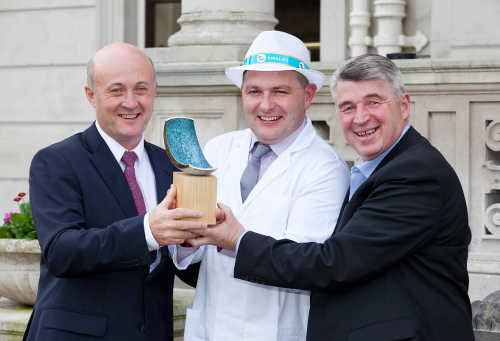 Seven days a week opening has also meant that the shop's customer base has expanded too, with seafood lovers making Sunday excursions to stock up on the spanking fresh fish. “People from Dublin make a day of it with a drive up the coast road, a walk on the beach and a mug of our hot chowder and brown bread, that they can take outside to sit on the harbour with a grand view of the trawlers and working boats. On weekdays, teachers from the local school might come down for a quick lunch and even on a winter day we'd sell 35 to 40 portions of chowder.”
Seven days a week opening has also meant that the shop's customer base has expanded too, with seafood lovers making Sunday excursions to stock up on the spanking fresh fish. “People from Dublin make a day of it with a drive up the coast road, a walk on the beach and a mug of our hot chowder and brown bread, that they can take outside to sit on the harbour with a grand view of the trawlers and working boats. On weekdays, teachers from the local school might come down for a quick lunch and even on a winter day we'd sell 35 to 40 portions of chowder.”
Gerard's enthusiasm is also being spread to the younger generation, as he's asked to make presentations in the local schools. “I bring as many fresh species as possible- and they’re allowed to hold live crabs and lobsters with gloves so they're not afraid. We have questions and answers and demonstrate filleting. We gave out vouchers and after the first demonstration we had 120 kids come into the shop with their parents. Now the local crèche has asked us to make a presentation to the under 4’s.”
While space in the harbourside premises is limited, Gerard is thinking of shifting the boning and filleting area to make space for a few tables and chairs. “We’d never go into full fledged catering, but it would be nice for customers to have a bit of shelter when they have the chowder and bits and pieces we put up, like the smoked salmon and mackerel and platters of the mussels and oysters we get from Kelly's of Galway.”
Although much of the fresh fish on offer is filleted and pin-boned, Gerard recommends fish cooked on the bone for best flavour. Noting that this is the norm on the continent, he set up a dedicated whole fish counter which has proved popular with customers who now try dishes like whole roasted and stuffed fish they see prepared by television chefs.
Gerard sees great potential in developing the Irish seafood business but is adamant that value-added products shouldn't take the spotlight away from the fresh fish. “Everything we have on the shelves is to complement the fish - breadcrumbs, sauces, fresh coriander, dill, parsley, lemons. We make our own stock from a turbot, monkfish and brill base, which gives a lovely gelatinous finish, and we sell it ready to use or frozen,"
With customers keen on trying new ideas at home, Gerard garners ideas from books by Rick Stein and our own Martin Shanahan, and regrets that Georgina Campbell’s From Tide to Table is no longer available as it’s a favourite of his and was a best-seller in the shop.
A study trip to France is part of Gerard's prize as BIM Young Fishmonger 2015 and he plans to concentrate on the Mediterranean fish markets, where he's interested in the varieties of whole small fish commonly used in southern cooking. “They use fish that would be regarded here as by-catch or simply overlooked and I'm hoping to pick up some new ideas. The fish market is growing fast here and there's just no limit to the good things we can get from the sea around us.”
PHOTOS - Pictured at the announcement of the Winner of the Young Fishmonger Competition 2015:
Top: Gerard Collier, Fisherman’s Catch, Clogherhead winner of BIM’s Young Fishmonger Competition 2015
Bottom: L to R: Donal Buckley, Business Development & Innovation Director, BIM; Gerard Collier, Fisherman’s Catch, Clogherhead winner of BIM’s Young Fishmonger Competition 2015 and Martin Shanahan, Fishy Fishy Restaurant, Kinsale and TV broadcaster
The Seafood Interview supported by BIM - Frankie Mallon
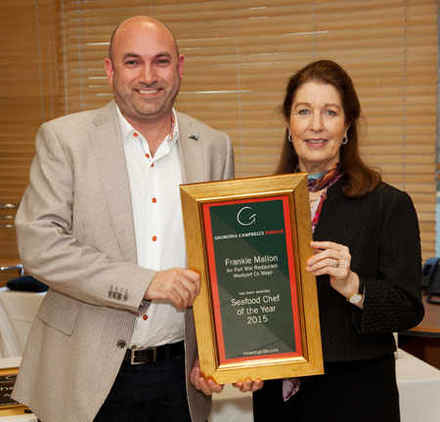

This month Marilyn Bright talks to Frankie Mallon, chef- proprietor of the acclaimed An Port Mor seafood restaurant in Westport, Co Mayo
Summers spent on Lough Neagh fishing, picking berries and making jam, chutney and bread with his grandmother are among Frankie Mallon's earliest memories. Today he is chef proprietor of Westport's An Port Mór restaurant with a reputation built on showcasing the local produce that abounds around Clew Bay that has attracted well-earned recognition, including the Georgina Campbell Seafood Chef of the Year for 2015.
 Menus feature local, fresh seafood and shellfish like the Inishturk crab cakes with a seaweed and polenta crust or the Donegal turf smoked organic salmon served up with Clew Bay prawns marinated in garlic, lemon and fresh herbs. Clew Bay seaweed jam appears on a plate of Achill Island smoked fish alongside homemade treacle brown bread.
Menus feature local, fresh seafood and shellfish like the Inishturk crab cakes with a seaweed and polenta crust or the Donegal turf smoked organic salmon served up with Clew Bay prawns marinated in garlic, lemon and fresh herbs. Clew Bay seaweed jam appears on a plate of Achill Island smoked fish alongside homemade treacle brown bread.
Frankie grew up in Portmór House at Blackwatertown in County Armagh and trained in Portrush Catering College. Leaving college in the 1990's, he went into Paul Rankin's Roscoff restaurant which was breaking new ground at the time. “It was the best thing that ever happened to me,” Frankie says. “It instilled in me a passion for good food and I learned the ethos of hard work that stands to me today.”
Roscoff was awarded a Michelin star that year and it is still a point of pride that commis chef Frankie prepared the starter and dessert for the customer later revealed to be the Michelin inspector.
Looking to broaden his experience, the young Irish chef worked for a couple of years in London, then spent two years in Switzerland at a family run hotel in Berne. “It was very regimented and ran like clockwork, but it engrained organisation and that stays with you. It’s training and discipline that makes you if you really want to make a career of cheffing, so I consider myself lucky."
It was off to the heady delights of Paris next, which Frankie admits was a “dream come true - completely surrounded by food.” He worked in Guy Savoy's fish restaurant just off the Champs Elysée and soaked up the atmosphere in the markets and food temples like Fauchon - with fruits and pastries presented like jewels in cases and Hediard where caskets of fresh truffles bear price tags that look like telephone numbers. “But in the end, I’m a home bird and, after two years in Paris, I was yearning for home and family,” Frankie recalls.
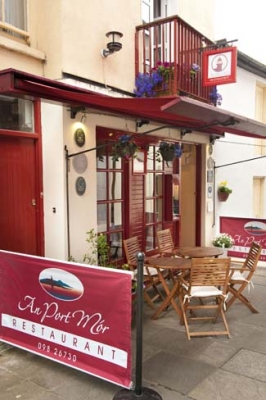 By his late 20's, Frankie was back in Westport, establishing a name for cooking the best seafood, notably as head chef at the Cronin family's popular old world thatched pub overlooking Clew Bay. Opening his own restaurant, An Port Mór, six years ago it was natural that seafood would star on the menu. “It's a pleasure to work with great produce - prawns, lobster, scallops straight out of the bay - that you know is so fresh and you can cook with confidence. You don't need to do a lot with them - just grill with a bit of butter and a few herbs and you can't go wrong.”
By his late 20's, Frankie was back in Westport, establishing a name for cooking the best seafood, notably as head chef at the Cronin family's popular old world thatched pub overlooking Clew Bay. Opening his own restaurant, An Port Mór, six years ago it was natural that seafood would star on the menu. “It's a pleasure to work with great produce - prawns, lobster, scallops straight out of the bay - that you know is so fresh and you can cook with confidence. You don't need to do a lot with them - just grill with a bit of butter and a few herbs and you can't go wrong.”
Frankie doesn't go overboard for the foams and waterbaths that he terms ‘frills and swills’, saying that “you can get bogged down with complications.” He thinks that fashion in cooking is going back to more simplicity, “Or maybe we all mellow with age,” he quips. Customers are more particular now, he's observed, because they're more knowledgeable, value quality and look for local and artisanal food on the menu.
Frankie buys in whole fish to be boned and filleted in-house where best use can be made of offcuts and bones for stocks and sauces. Prawn and lobster shells are flamed with brandy and roasted off to make the base for bisques, or processed and steeped with chervil and peppercorns to make flavoured oils.
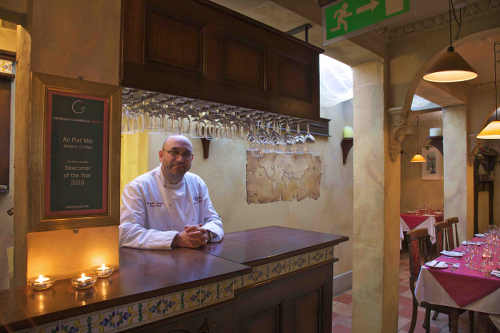 Jane Harriett's rapeseed oil from County Down has replaced olive oil in the Port Mor kitchens. “It's homegrown, a lovely gold colour and we use it for everything from frying and grilling to marinades and salad dressings.”
Jane Harriett's rapeseed oil from County Down has replaced olive oil in the Port Mor kitchens. “It's homegrown, a lovely gold colour and we use it for everything from frying and grilling to marinades and salad dressings.”
Homegrown and local is a theme throughout the An Port Mór menus and the terrific produce grown locally partners perfectly with the ultra fresh fish and seafood to present the food credentials of the area at their best.
Cress and fresh herbs come straight from Joe Kelly's farm outside the town, along with salad leaves, red chard, Frankie's favourite bok choy greens and long stem broccoli. Carrots, beetroot and turnips are grown by Lily Ryder, along with the taste trialled Mayo potatoes that Frankie swears put commercial supplies in the shade.
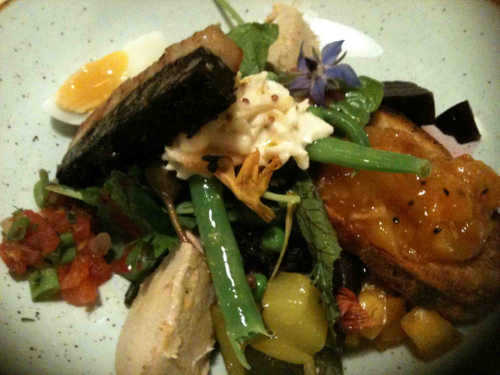 Locally harvested seaweed and polenta crust is a signature twist, appearing as a crisp finish on crab cakes or roasted cod fillets. New to the menu this season is a pairing of Achill Island smoked mackerel paté with Kelly's black pudding, just grilled and served as a warm salad.
Locally harvested seaweed and polenta crust is a signature twist, appearing as a crisp finish on crab cakes or roasted cod fillets. New to the menu this season is a pairing of Achill Island smoked mackerel paté with Kelly's black pudding, just grilled and served as a warm salad.
An Port Mor and Kelly's of Newport, along with a dozen or so other restaurants and artisan producers make up the Gourmet Greenway Group, all food related businesses welcoming cyclists and walkers along the Great Western Greenway that embraces picturesque Clew Bay. This popular trail put Mayo ‘on the radar’, Frankie says, and the area is getting a name as a food destination.
“The Greenway has created a feel-good factor, with the local community all working together - restaurants, hotels and food producers all supporting each other. We opened at the worst possible time six years ago and the business was built by word of mouth with recommendations from B and B's and hotels, and it's the locals who keep us going through the low season too. They enjoy the area’s brilliant fresh fish and seafood - and the lovely Achill Island lamb - just as much as visitors do. It’s a great place to live and to work.”
The Seafood Interview supported by BIM - Martin Shanahan
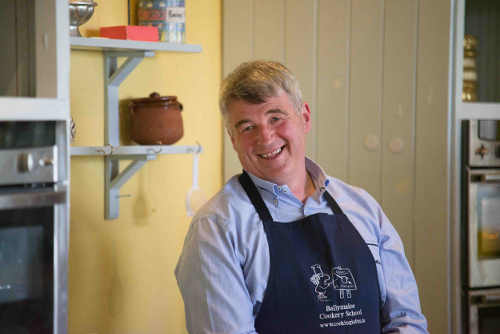

This month Marilyn Bright talks to Ireland’s most famous ambassador for fresh Irish seafood, Martin Shanahan of Fishy Fishy Restaurant in Kinsale, Co Cork- whose motto is “no skin, no bone, no fear”
Everybody knows that Martin Shanahan is “Mad About Fish”. The hit cookery programme first screened by RTE Cork in 2009 spread the fame of the chef/restaurateur far beyond his Kinsale base in the golden food triangle of West Cork.
Fishy Fishy was originally a fish shop and deli opened by the Shanahans 25 years ago as the Kinsale Gourmet Store, morphing to become Kinsale's first dedicated seafood café, drawing throngs of diners happy to queue for space at tables or sit on walls in the sunny forecourt with their fresh crab rolls or bowls of chowder.
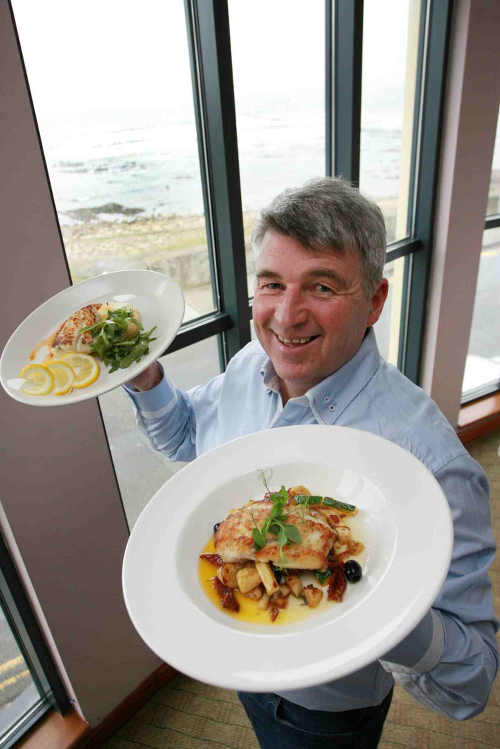 Becoming a seafood legend in his own lunchtime, Martin expanded the business to open a fully fledged restaurant in 2006, with spacious harbourside premises and a generous courtyard for al fresco dining.
Becoming a seafood legend in his own lunchtime, Martin expanded the business to open a fully fledged restaurant in 2006, with spacious harbourside premises and a generous courtyard for al fresco dining.
Best selling fish cookery books and further TV series such as Surf’n’Turf with Paul Flynn have ensured a steady stream of seafood lovers which reach a crescendo in the summer season and sees the year round staff of 22 nearly double to cope with the non-stop daily service. The newly refurbished Fishy Fishy opened in February - with an enlarged ground floor area that has doubled the dining space.
With a reputation for deliciously fresh uncomplicated seafood, Martin's motto is “no skin, no bone, no fear” and the menu features everything that is fresh and local from land and sea. His cheffing skills were honed at the late lamented Rockwell Catering College where training included everything from pot scrubbing to harvesting the fresh fruit and vegetables grown by the resident agricultural students.
“We had to cater three meals a day for 800-1,000 students and staff. It was hard work but a good grounding. With the rise of celebrity chefs now the job can seem glamorous, but the young need to see that you have to have discipline and start at the bottom to stay the course as a career.”
Work experience around Ireland, in Germany and the US, expanded Martin's knowledge and appreciation of the ways local produce was used. “In San Francisco, Fisherman's Wharf was a revelation. People would pick up boiled crabs or chowder from the stalls and walk around eating seafood like we'd eat 99s. It was just casual, simply prepared food.”
Martin is adamant that when you have best ingredients, dishes shouldn't be over complicated. “People want to taste fish for what it is - it's all about quality. Brilliant fish doesn't need much more than butter sauce and a green salad.”
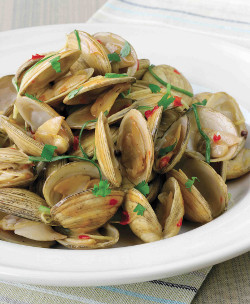 Seafood doesn't get more local than the selection that appears daily on Fishy Fishy menus and Martin considers himself lucky that small boats still land their catches in Kinsale harbour.
Seafood doesn't get more local than the selection that appears daily on Fishy Fishy menus and Martin considers himself lucky that small boats still land their catches in Kinsale harbour.
Other supplies come from Castletownbere, Union Hall or Oysterhaven, minutes rather than hours away, and Martin knows personally who caught each fish that comes into his kitchen. Fresh vegetables and salad leaves are very local too, coming from Horizon Farm three miles from Kinsale.
Pressures of time and volume mean that most fish is now delivered boned and filleted, ready to be portioned in-house, but lobsters and crab are hand picked in the Fishy Fishy kitchens. “It's laborious, but worth it for the taste,” Martin says. "Nothing is wasted - shells go into stock bases for chowder and bisque and off-cuts into fish cakes and seafood pies.”
Seasonality is key and Martin feels that the ever changing menu keeps the job interesting. Prawns and turbot come into their own in June and high summer means lobster and crab. There may be fresh crab cakes with chilli and coriander or crab risotto with wild rocket, Parmesan shavings and lemon oil while traditionalists can treat themselves to classic lobster thermidor with creamy mustard sauce.
While summer visitors are more adventurous, Martin observes that comfort food is the order of the day in winter, with high uptake of the famous Fishy Fishy pie of whitefish, salmon and shellfish in creamy sauce topped with herb breadcrumbs and served with dollops of buttery house mash.
Local surf and turf features in a dish pairing Rosscarbery black pudding with pan-fried scallops and creamed parsnips with lemon and thyme dressing while the seafood chowder with a subtle seasoning of tarragon and coriander is a year round best seller, by the cup or hearty bowlful.
 Over the years, Martin has seen huge growth in the consumption of seafood, both in dining out and home cooking. With recent involvement in BIM’s Young Fishmonger awards, he’s also observed that new generation fish shops are opening with knowledgeable, customer friendly staff offering cooking advice and fresh seafood with ready-to-cook convenience, prepared sauces, stocks and accompaniments. “People want seafood and the demand will continue, thanks to the good restaurants, good fish and chip shops and fishmongers I see cropping up all over the country.”
Over the years, Martin has seen huge growth in the consumption of seafood, both in dining out and home cooking. With recent involvement in BIM’s Young Fishmonger awards, he’s also observed that new generation fish shops are opening with knowledgeable, customer friendly staff offering cooking advice and fresh seafood with ready-to-cook convenience, prepared sauces, stocks and accompaniments. “People want seafood and the demand will continue, thanks to the good restaurants, good fish and chip shops and fishmongers I see cropping up all over the country.”
The Seafood Interview supported by BIM - JJ & Kay Mitchell
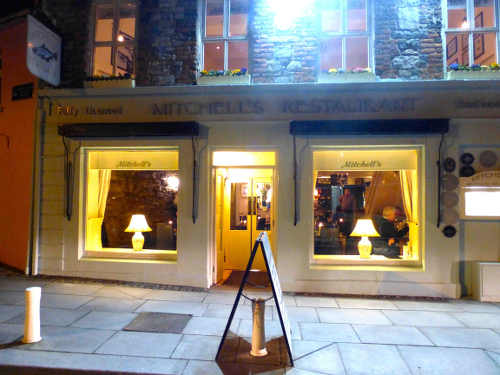

This month Marilyn Bright talks to J.J. and Kay Mitchell, whose seafood restaurant in the heart of Clifden has been delighting locals and visitors alike for nearly a quarter of a century
With the waves of Clifden Bay lapping just strides away, fresh crab and an array of fish from local boats is being served up to happy diners in Mitchell's Restaurant in the heart of Connemara. Named Georgina Campbell’s Seafood Restaurant of the Year 2015, this popular establishment run by J.J. and Kay Mitchell runs to choices of a dozen or so different fish and shellfish daily, with a list that changes according to the day's catch.
 Opening nearly a quarter of a century ago in an attractively restored stone-fronted pub, J.J. relates that they spent the first year gradually establishing the direction the business would take. “We could see an increasing tourist market in the West and more demand for food. Being on the port, it was only natural to focus on fish and local produce. Timing was right too, because in the mid-90's, people were becoming more interested in healthy eating and demand for seafood was growing.”
Opening nearly a quarter of a century ago in an attractively restored stone-fronted pub, J.J. relates that they spent the first year gradually establishing the direction the business would take. “We could see an increasing tourist market in the West and more demand for food. Being on the port, it was only natural to focus on fish and local produce. Timing was right too, because in the mid-90's, people were becoming more interested in healthy eating and demand for seafood was growing.”
Creamy chowder made with fresh white fish, salmon and mussels became a lunchtime staple, along with big bowls of Killary mussels steamed in their own liquor with garlic, butter and white wine or cod and leek pie with mash topping. Fresh baked brown bread is the base for open sandwiches piled high with fresh crab or salmon or Galway Bay prawns with homemade mayonnaise. Crunchy homemade fish fingers go onto toasted ciabatta with pickled red onion and lemon mayo.
Demand for fish and the house handcut chips is constant, but an updated version boasts tempura lemon sole with curried mayonnaise, chilli jam and salad. Evening menus include dishes like pan-fried hake with a colcannon and bacon potato cake and coriander cream, or baked Clare Island organic salmon, with creamed leeks and sorrel sauce.
Scallops and black pudding with parsnip mash is a favourite and J.J. notes that demand for scallops has risen by at least 50 % over the past few years. Hake is up in the charts too, replacing cod which was in danger of being over fished, although J.J. says that stocks are recovering now due to strict controls on allowances.
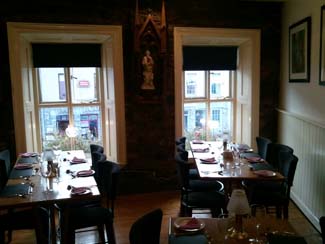 With an early background in a family confectionery and coffee shop, Kay Mitchell runs the kitchen today with a brigade of five chefs catering for the busy all-day service. “We started small,” she says, but now we have 75 covers over two floors and are open seven days a week during high season. Customers are looking for good food at a good price, and it's all about freshness. Even though we're a seasonal restaurant, most of our team come back year after year and take pride in the quality and consistency of everything that goes out.”
With an early background in a family confectionery and coffee shop, Kay Mitchell runs the kitchen today with a brigade of five chefs catering for the busy all-day service. “We started small,” she says, but now we have 75 covers over two floors and are open seven days a week during high season. Customers are looking for good food at a good price, and it's all about freshness. Even though we're a seasonal restaurant, most of our team come back year after year and take pride in the quality and consistency of everything that goes out.”
Many of the team use winter months to travel or do stages in London restaurants where they pick up new ideas to bring back. J.J. and Kay take six weeks in the Florida sun, trying menus there that feature warm water fish like grouper and snapper. “You'd see some new ideas there, but food at home is a thousand times nicer,” Kay says.
Fish for Kay's menu is delivered in fresh daily from local sources, with portioning done in-house to utilise off-cuts and trimmings for their own stocks and sauces. Clare Island organic salmon are filleted and pin-boned and prawns from Rossaveal are peeled by hand. Quantities of Maris Pipers are hand cut for ever-popular chips but Queens are scrubbed, to be boiled and served in their jackets, Connemara style.
Reflecting on how the business has grown, J.J. notes that tourism began an upward curve in the mid-1990s, with Connemara seen as an international brand name attracting North Americans and a growing stream of continentals mainly French, Italian and Spanish. “A popular French song, about the beauty of Connemara's mountains and lakes - I think by a singer called Michel Sardou - has brought loads of visitors, and they're hugely into oysters, scallops, mussels and crab.”
The good times stopped suddenly when recession hit and J.J. describes 2008 to 2013 as “horrific years” citing the many businesses that didn't survive! He sees confidence coming back now, with people willing to spend money and tourists returning. Kay observes that they've been busy early this year, with the season starting on St Patrick's Day and already full on. “There are already lots of French visitors and we have great local trade with something on nearly every weekend - mini-marathons, cycling events and walking festivals.”
“The outlook is very good this year,” J.J. adds, “and we're looking forward to a bumper season.”
The Seafood Interview supported by BIM - Birgitta Hedin-Curtin
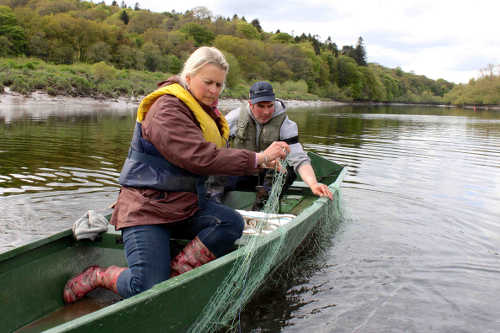

This month Marilyn Bright talks to Birgitta Hedin-Curtin, of the famed Burren Smokehouse in Lisdoonvarna Co Clare, about this vibrant business and some of its recent successes.
A leaping salmon sculpture and splashing stream rushing to the sea mark the entrance to the Burren Smokehouse where Birgitta Hedin-Curtin produces the award winning smoked salmon deemed fit for a visiting queen or a St. Patricks Day treat for the president of the United States.
Clare Island organic farmed salmon is used to make the cold-smoked salmon to a recipe Birgitta and her husband Peter developed 25 years ago, as well as the recently introduced smoked salmon with Irish seaweed, which Birgitta says is their most successful product to date. The seaweed which gives it a unique flavour comes from Spanish Point, supplied by traditional seaweed harvester Gerard Talty of Wild Irish Sea Vegetables.
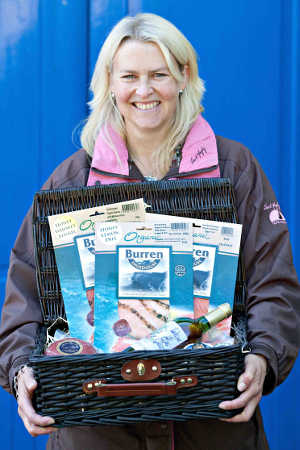 The Curtins only work with sustainably sourced fish, Birgitta explains. “Our organically farmed salmon is the best in terms of feeding, stock density and situation. Plenty of wave action and tidal movement means that the fish swims 24,000 km in its lifetime so the flesh is firm with a minimum of the fat you find in fish raised in overcrowded conditions.”
The Curtins only work with sustainably sourced fish, Birgitta explains. “Our organically farmed salmon is the best in terms of feeding, stock density and situation. Plenty of wave action and tidal movement means that the fish swims 24,000 km in its lifetime so the flesh is firm with a minimum of the fat you find in fish raised in overcrowded conditions.”
Mackerel for smoking comes from Killybegs and the Curtins only use fish landed from November to February when the oil content is at its best for producing top quality smoked product. “Summer mackerel is hugely different”, Birgitta says, “even though it's very good eaten fresh.”
The prized wild salmon was completely off the menu when fishing licences were suspended for five years to conserve diminishing stocks. Birgitta relates how restrictions were lifted just six days before Queen Elizabeth's historic visit in 2011.
“Ross Lewis of Chapter One Restaurant was responsible for the state banquet in Dublin Castle and asked if we could supply wild smoked salmon for the night. No fish were caught on he first two days of the season, but just as time was running out on the third day, the first salmon were landed. There was just enough time for the curing and smoking and I ended up taking the salmon straight from the ovens and driving through the night to deliver it in time.”
Birgitta comes from coastal Sweden where there is a tradition of local smoking and remembers fishing for eels with her father. “Smoked eel was always a feature of any celebration, especially Christmas, New Year and midsummer... and smoked herring was a favourite too.”
With Peter, who had a background in the merchant navy and ran his own fishing boat, the couple worked together on recipes for smoked fish and started with a small smoker just big enough for 12 sides of salmon. Birgitta vac-packed their first batches of smoked salmon in the kitchen and the Burren Smokehouse Ltd. was born.
As business expanded a larger brick oven was built, but proved to be problematical. “Smoking is an art and a craft,” Birgitta explains, “and it was difficult to control the temperature in the brick oven. For a cold smoke, temperature must be kept under 35ºC. Eventually, we worked with a food scientist to design our own state of the art steel ovens which were built in Limerick. Both the process and the equipment is patented so these are totally unique to us.”
 The new purpose-built smokehouse opened 25 years ago in its picturesque setting on the road from Lisdoonvarna to the sea at Doolin. Today the Burren Smokehouse produces 40 tonnes of smoked fish a year, with the huge Christmas orders accounting for nearly half that amount.
The new purpose-built smokehouse opened 25 years ago in its picturesque setting on the road from Lisdoonvarna to the sea at Doolin. Today the Burren Smokehouse produces 40 tonnes of smoked fish a year, with the huge Christmas orders accounting for nearly half that amount.
The visitor centre and shop opened in 1994 to cater for increasing numbers of tourists in the area and an educational element was added with a seven minute video film showing the sourcing of Irish seafood and the curing and smoking process. The facility attracts 30,000 visitors a year and, although access to the smokery is generally restricted for health and safety reasons, special tours are arranged for schools and groups such as culinary students.
Birgitta is chairperson of Slow Food Clare, a member of the Taste Council and currently involved in the Burren Slow Food Festival which takes place May 16-24 with a Land and Sea theme. She uses her frequent trips to speciality food fairs abroad to promote other quality Irish produce as well as her own.
A growing international profile has meant that Burren Smokehouse Irish salmon is stocked at high-end outlets such as Harrods, Selfridges and Fortnum and Mason, and is currently flying high in Aer Lingus business class along with six other artisan products on a new menu showcasing quality Irish foods. Earlier this year Birgitta was honoured by the Irish Food Writers’ Guild, with an award for her notable contribution to Irish food.
The Burren Smokehouse’s growing customer base also attracted interest recently from the producers of the six-part Wild Ireland TV series, in which presenter Christine Bleakley returns home to Ireland to travel the 1500-mile length of the Wild Atlantic Way. The Smokehouse featured in the first programme of the series and, saying that the programme makers “were keen to discover more about our company and how we source 100% quality Irish raw materials for our Burren Smoked Salmon, Trout and Mackerel products,”
Birgitta - who is a Wild Atlantic Way Food Ambassador for Fáilte Ireland - expressed the hope that hope it will help provide increased exposure for and awareness of the West of Ireland's food producers, as well as boosting numbers at their own Visitor Centre.
Show me all Article


